Research Methods in Business and Social Sciences
VerifiedAdded on 2020/03/28
|60
|12350
|50
AI Summary
The assignment delves into the world of research methods utilized across diverse fields like business and social sciences. It examines different approaches to conducting research, including quantitative, qualitative, and mixed methods. Understanding these methodologies is crucial for effectively collecting, analyzing, and interpreting data in various academic and professional settings.
Contribute Materials
Your contribution can guide someone’s learning journey. Share your
documents today.
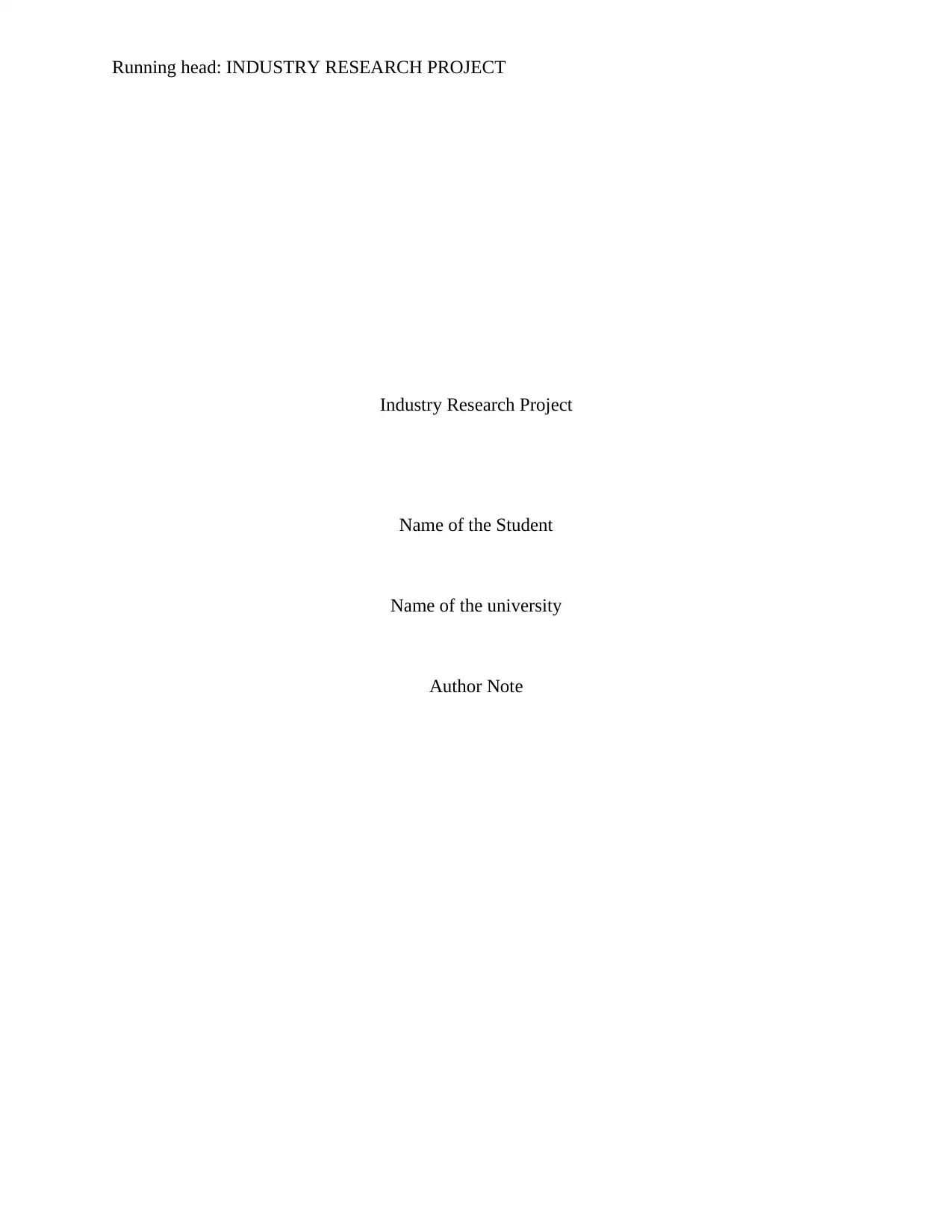
Running head: INDUSTRY RESEARCH PROJECT
Industry Research Project
Name of the Student
Name of the university
Author Note
Industry Research Project
Name of the Student
Name of the university
Author Note
Secure Best Marks with AI Grader
Need help grading? Try our AI Grader for instant feedback on your assignments.
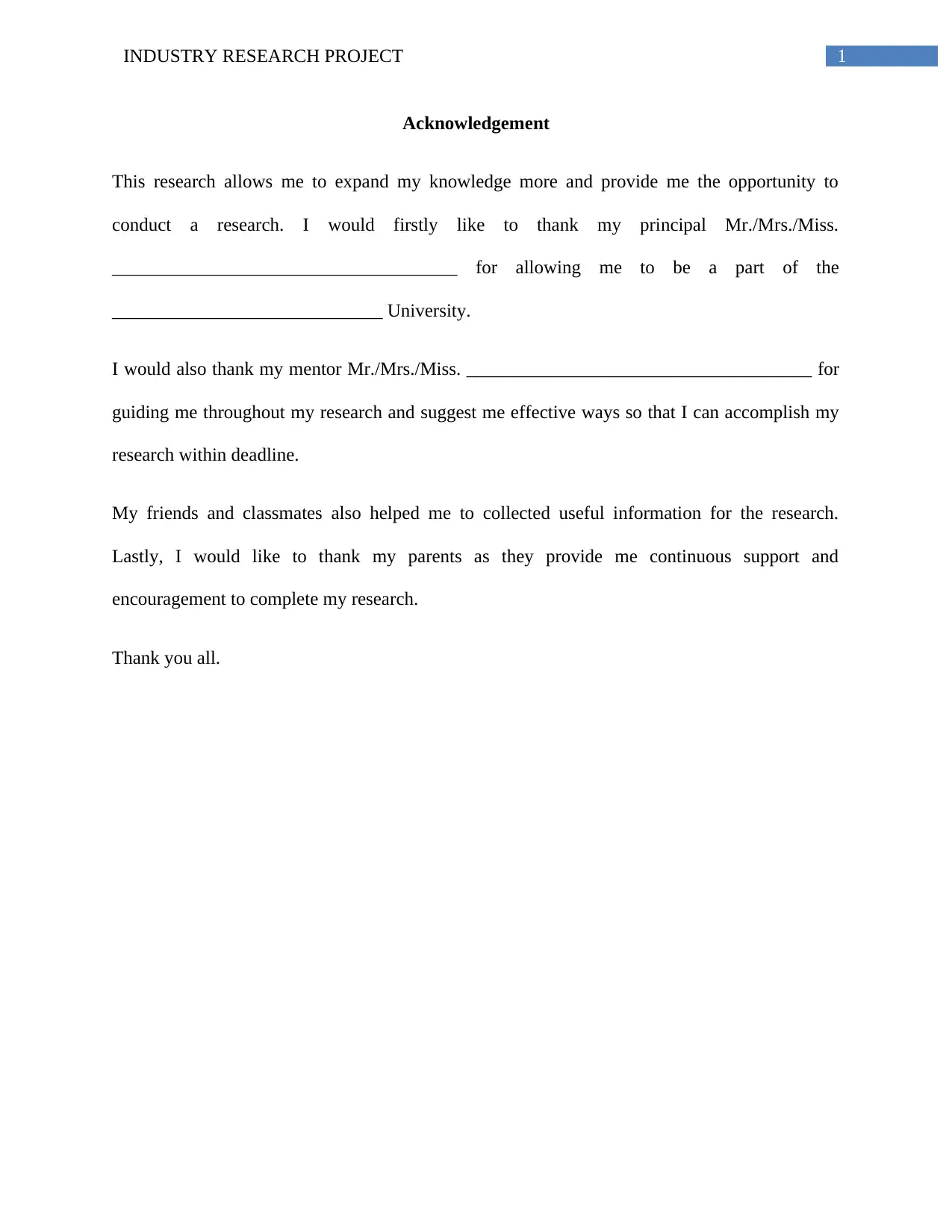
1INDUSTRY RESEARCH PROJECT
Acknowledgement
This research allows me to expand my knowledge more and provide me the opportunity to
conduct a research. I would firstly like to thank my principal Mr./Mrs./Miss.
_____________________________________ for allowing me to be a part of the
_____________________________ University.
I would also thank my mentor Mr./Mrs./Miss. _____________________________________ for
guiding me throughout my research and suggest me effective ways so that I can accomplish my
research within deadline.
My friends and classmates also helped me to collected useful information for the research.
Lastly, I would like to thank my parents as they provide me continuous support and
encouragement to complete my research.
Thank you all.
Acknowledgement
This research allows me to expand my knowledge more and provide me the opportunity to
conduct a research. I would firstly like to thank my principal Mr./Mrs./Miss.
_____________________________________ for allowing me to be a part of the
_____________________________ University.
I would also thank my mentor Mr./Mrs./Miss. _____________________________________ for
guiding me throughout my research and suggest me effective ways so that I can accomplish my
research within deadline.
My friends and classmates also helped me to collected useful information for the research.
Lastly, I would like to thank my parents as they provide me continuous support and
encouragement to complete my research.
Thank you all.
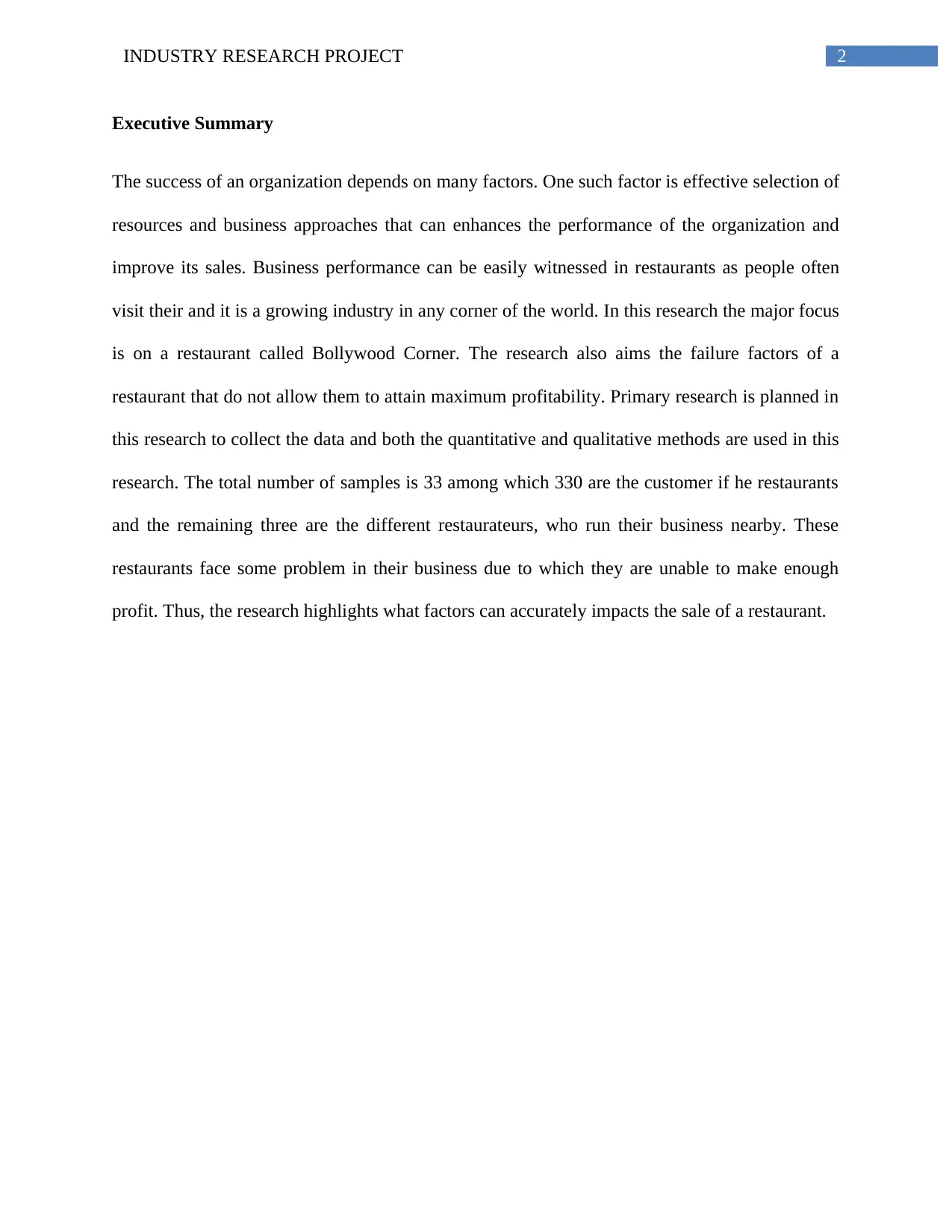
2INDUSTRY RESEARCH PROJECT
Executive Summary
The success of an organization depends on many factors. One such factor is effective selection of
resources and business approaches that can enhances the performance of the organization and
improve its sales. Business performance can be easily witnessed in restaurants as people often
visit their and it is a growing industry in any corner of the world. In this research the major focus
is on a restaurant called Bollywood Corner. The research also aims the failure factors of a
restaurant that do not allow them to attain maximum profitability. Primary research is planned in
this research to collect the data and both the quantitative and qualitative methods are used in this
research. The total number of samples is 33 among which 330 are the customer if he restaurants
and the remaining three are the different restaurateurs, who run their business nearby. These
restaurants face some problem in their business due to which they are unable to make enough
profit. Thus, the research highlights what factors can accurately impacts the sale of a restaurant.
Executive Summary
The success of an organization depends on many factors. One such factor is effective selection of
resources and business approaches that can enhances the performance of the organization and
improve its sales. Business performance can be easily witnessed in restaurants as people often
visit their and it is a growing industry in any corner of the world. In this research the major focus
is on a restaurant called Bollywood Corner. The research also aims the failure factors of a
restaurant that do not allow them to attain maximum profitability. Primary research is planned in
this research to collect the data and both the quantitative and qualitative methods are used in this
research. The total number of samples is 33 among which 330 are the customer if he restaurants
and the remaining three are the different restaurateurs, who run their business nearby. These
restaurants face some problem in their business due to which they are unable to make enough
profit. Thus, the research highlights what factors can accurately impacts the sale of a restaurant.
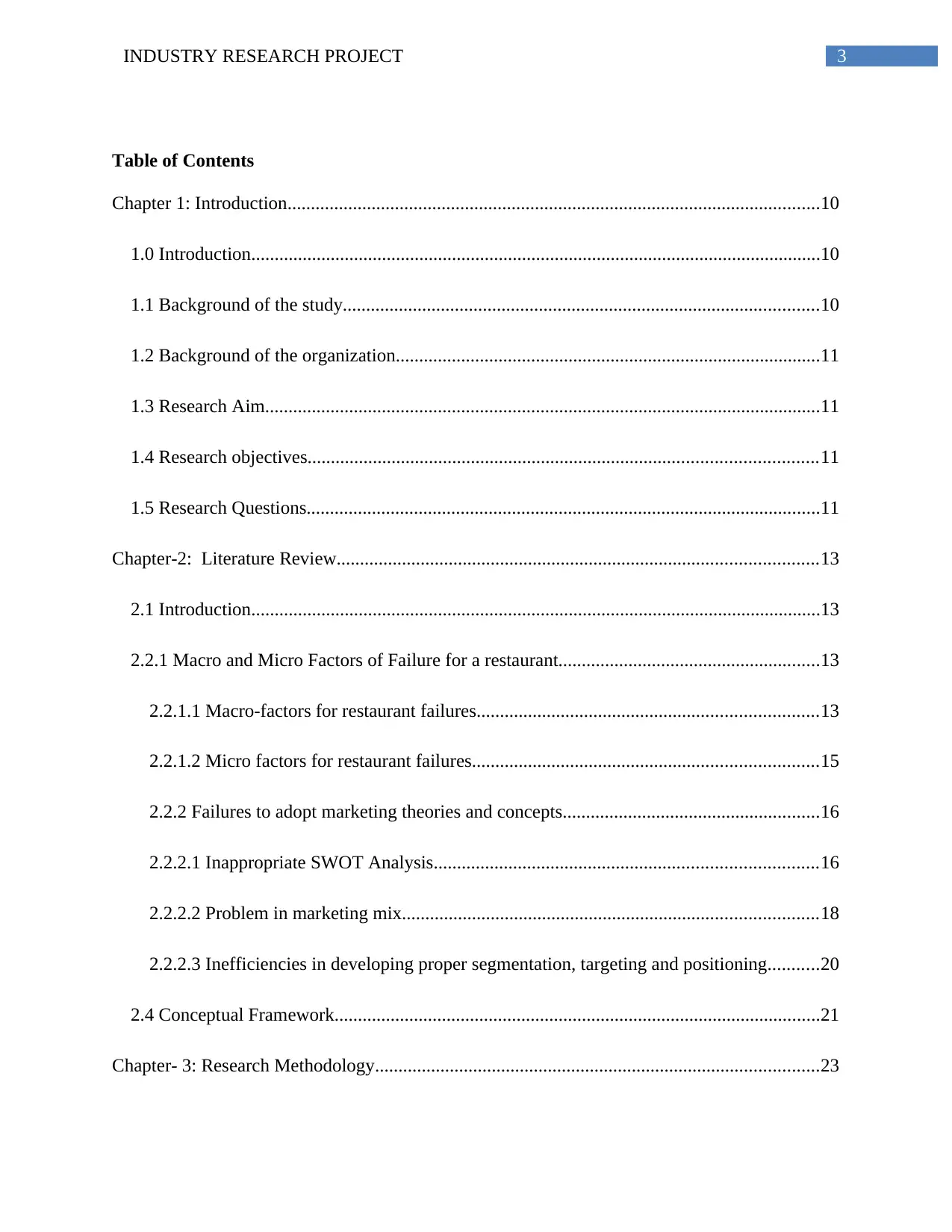
3INDUSTRY RESEARCH PROJECT
Table of Contents
Chapter 1: Introduction..................................................................................................................10
1.0 Introduction..........................................................................................................................10
1.1 Background of the study......................................................................................................10
1.2 Background of the organization...........................................................................................11
1.3 Research Aim.......................................................................................................................11
1.4 Research objectives.............................................................................................................11
1.5 Research Questions..............................................................................................................11
Chapter-2: Literature Review.......................................................................................................13
2.1 Introduction..........................................................................................................................13
2.2.1 Macro and Micro Factors of Failure for a restaurant........................................................13
2.2.1.1 Macro-factors for restaurant failures.........................................................................13
2.2.1.2 Micro factors for restaurant failures..........................................................................15
2.2.2 Failures to adopt marketing theories and concepts.......................................................16
2.2.2.1 Inappropriate SWOT Analysis..................................................................................16
2.2.2.2 Problem in marketing mix.........................................................................................18
2.2.2.3 Inefficiencies in developing proper segmentation, targeting and positioning...........20
2.4 Conceptual Framework........................................................................................................21
Chapter- 3: Research Methodology...............................................................................................23
Table of Contents
Chapter 1: Introduction..................................................................................................................10
1.0 Introduction..........................................................................................................................10
1.1 Background of the study......................................................................................................10
1.2 Background of the organization...........................................................................................11
1.3 Research Aim.......................................................................................................................11
1.4 Research objectives.............................................................................................................11
1.5 Research Questions..............................................................................................................11
Chapter-2: Literature Review.......................................................................................................13
2.1 Introduction..........................................................................................................................13
2.2.1 Macro and Micro Factors of Failure for a restaurant........................................................13
2.2.1.1 Macro-factors for restaurant failures.........................................................................13
2.2.1.2 Micro factors for restaurant failures..........................................................................15
2.2.2 Failures to adopt marketing theories and concepts.......................................................16
2.2.2.1 Inappropriate SWOT Analysis..................................................................................16
2.2.2.2 Problem in marketing mix.........................................................................................18
2.2.2.3 Inefficiencies in developing proper segmentation, targeting and positioning...........20
2.4 Conceptual Framework........................................................................................................21
Chapter- 3: Research Methodology...............................................................................................23
Secure Best Marks with AI Grader
Need help grading? Try our AI Grader for instant feedback on your assignments.
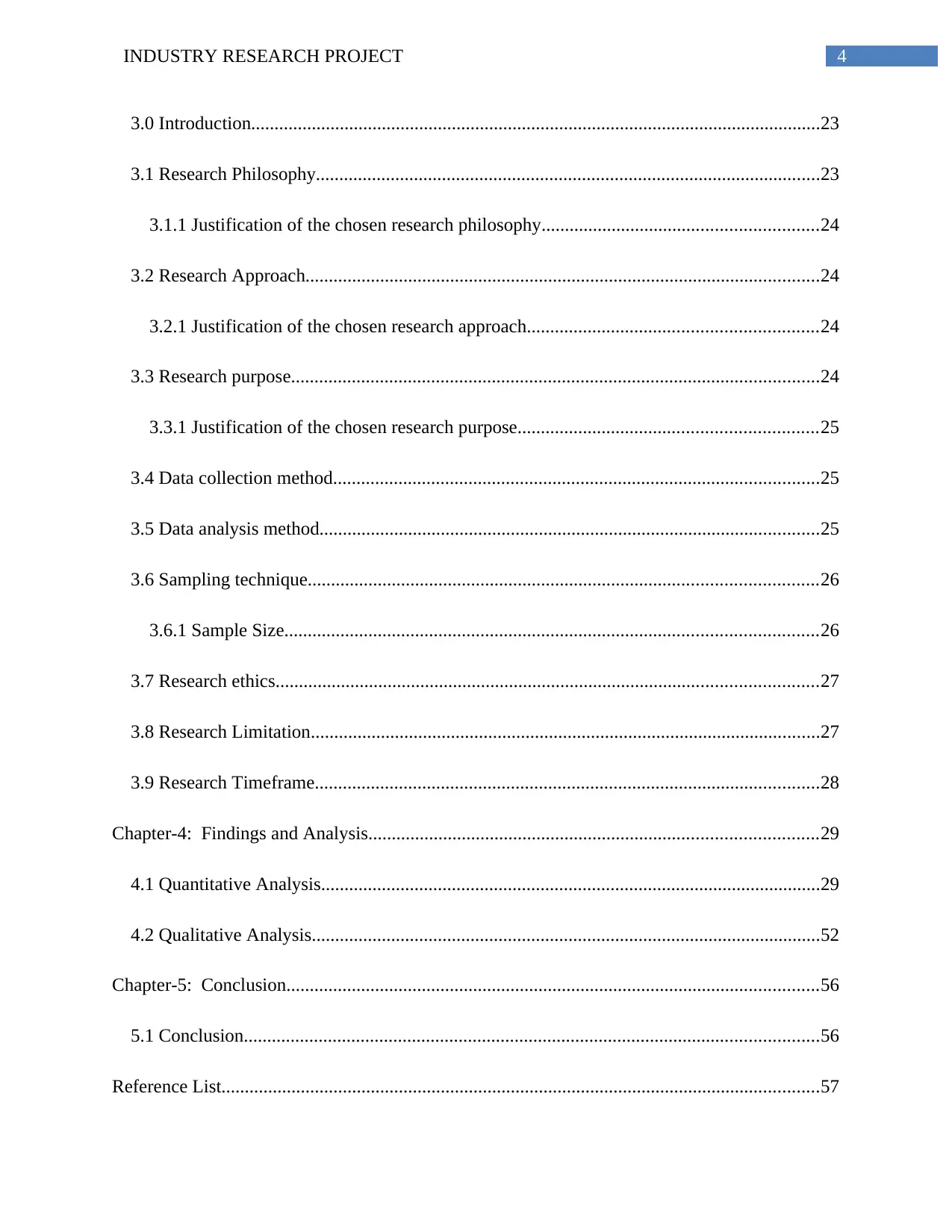
4INDUSTRY RESEARCH PROJECT
3.0 Introduction..........................................................................................................................23
3.1 Research Philosophy............................................................................................................23
3.1.1 Justification of the chosen research philosophy...........................................................24
3.2 Research Approach..............................................................................................................24
3.2.1 Justification of the chosen research approach..............................................................24
3.3 Research purpose.................................................................................................................24
3.3.1 Justification of the chosen research purpose................................................................25
3.4 Data collection method........................................................................................................25
3.5 Data analysis method...........................................................................................................25
3.6 Sampling technique.............................................................................................................26
3.6.1 Sample Size..................................................................................................................26
3.7 Research ethics....................................................................................................................27
3.8 Research Limitation.............................................................................................................27
3.9 Research Timeframe............................................................................................................28
Chapter-4: Findings and Analysis................................................................................................29
4.1 Quantitative Analysis...........................................................................................................29
4.2 Qualitative Analysis.............................................................................................................52
Chapter-5: Conclusion..................................................................................................................56
5.1 Conclusion...........................................................................................................................56
Reference List................................................................................................................................57
3.0 Introduction..........................................................................................................................23
3.1 Research Philosophy............................................................................................................23
3.1.1 Justification of the chosen research philosophy...........................................................24
3.2 Research Approach..............................................................................................................24
3.2.1 Justification of the chosen research approach..............................................................24
3.3 Research purpose.................................................................................................................24
3.3.1 Justification of the chosen research purpose................................................................25
3.4 Data collection method........................................................................................................25
3.5 Data analysis method...........................................................................................................25
3.6 Sampling technique.............................................................................................................26
3.6.1 Sample Size..................................................................................................................26
3.7 Research ethics....................................................................................................................27
3.8 Research Limitation.............................................................................................................27
3.9 Research Timeframe............................................................................................................28
Chapter-4: Findings and Analysis................................................................................................29
4.1 Quantitative Analysis...........................................................................................................29
4.2 Qualitative Analysis.............................................................................................................52
Chapter-5: Conclusion..................................................................................................................56
5.1 Conclusion...........................................................................................................................56
Reference List................................................................................................................................57
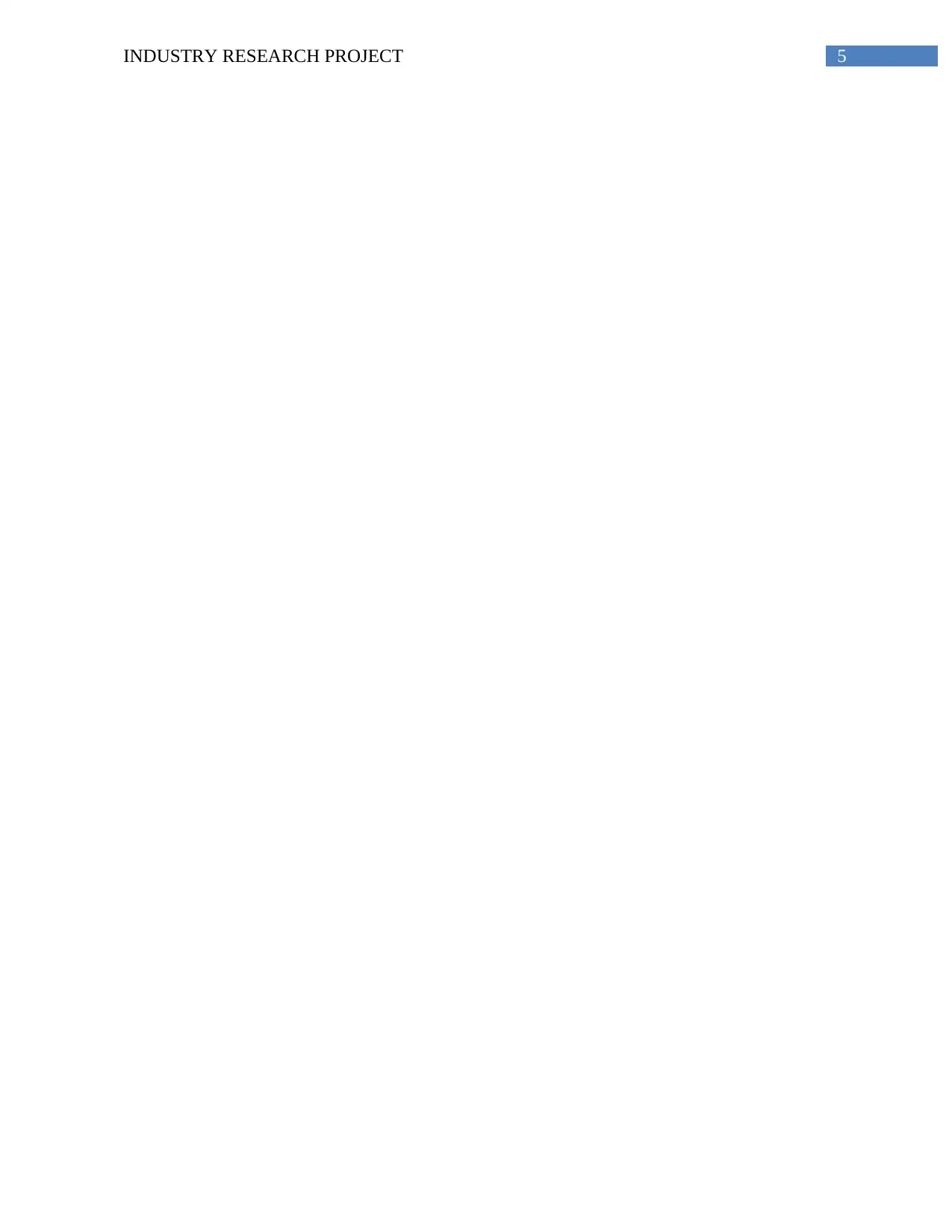
5INDUSTRY RESEARCH PROJECT

6INDUSTRY RESEARCH PROJECT
Table of Images
Image 1: Structure of the Dissertation...........................................................................................11
Image 2: SWOT Analysis..............................................................................................................15
Image 3: Marketing Mix- 4P.........................................................................................................17
Image 4: Segmentation, Targeting and Positioning Model...........................................................19
Table of Images
Image 1: Structure of the Dissertation...........................................................................................11
Image 2: SWOT Analysis..............................................................................................................15
Image 3: Marketing Mix- 4P.........................................................................................................17
Image 4: Segmentation, Targeting and Positioning Model...........................................................19
Paraphrase This Document
Need a fresh take? Get an instant paraphrase of this document with our AI Paraphraser
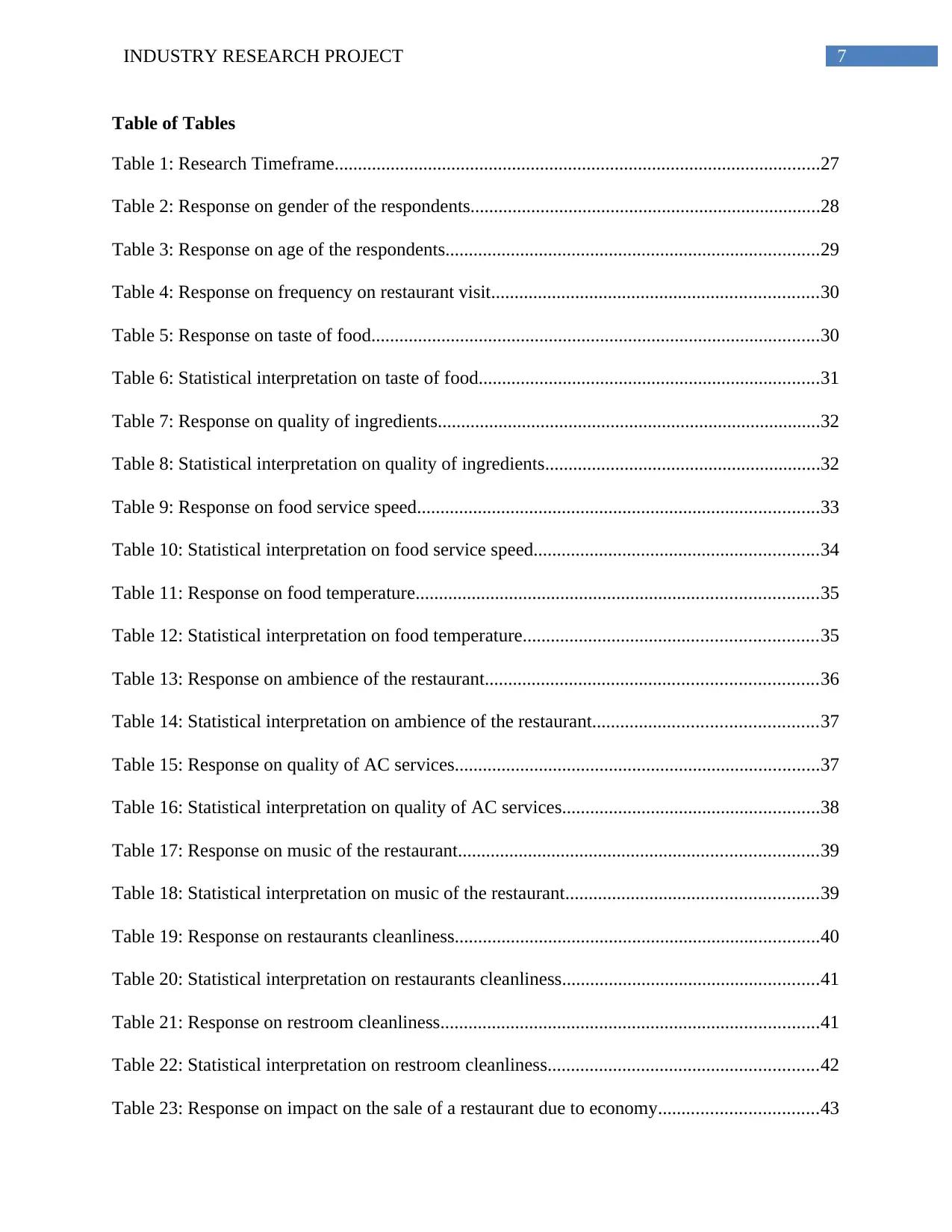
7INDUSTRY RESEARCH PROJECT
Table of Tables
Table 1: Research Timeframe........................................................................................................27
Table 2: Response on gender of the respondents...........................................................................28
Table 3: Response on age of the respondents................................................................................29
Table 4: Response on frequency on restaurant visit......................................................................30
Table 5: Response on taste of food................................................................................................30
Table 6: Statistical interpretation on taste of food.........................................................................31
Table 7: Response on quality of ingredients..................................................................................32
Table 8: Statistical interpretation on quality of ingredients...........................................................32
Table 9: Response on food service speed......................................................................................33
Table 10: Statistical interpretation on food service speed.............................................................34
Table 11: Response on food temperature......................................................................................35
Table 12: Statistical interpretation on food temperature...............................................................35
Table 13: Response on ambience of the restaurant.......................................................................36
Table 14: Statistical interpretation on ambience of the restaurant................................................37
Table 15: Response on quality of AC services..............................................................................37
Table 16: Statistical interpretation on quality of AC services.......................................................38
Table 17: Response on music of the restaurant.............................................................................39
Table 18: Statistical interpretation on music of the restaurant......................................................39
Table 19: Response on restaurants cleanliness..............................................................................40
Table 20: Statistical interpretation on restaurants cleanliness.......................................................41
Table 21: Response on restroom cleanliness.................................................................................41
Table 22: Statistical interpretation on restroom cleanliness..........................................................42
Table 23: Response on impact on the sale of a restaurant due to economy..................................43
Table of Tables
Table 1: Research Timeframe........................................................................................................27
Table 2: Response on gender of the respondents...........................................................................28
Table 3: Response on age of the respondents................................................................................29
Table 4: Response on frequency on restaurant visit......................................................................30
Table 5: Response on taste of food................................................................................................30
Table 6: Statistical interpretation on taste of food.........................................................................31
Table 7: Response on quality of ingredients..................................................................................32
Table 8: Statistical interpretation on quality of ingredients...........................................................32
Table 9: Response on food service speed......................................................................................33
Table 10: Statistical interpretation on food service speed.............................................................34
Table 11: Response on food temperature......................................................................................35
Table 12: Statistical interpretation on food temperature...............................................................35
Table 13: Response on ambience of the restaurant.......................................................................36
Table 14: Statistical interpretation on ambience of the restaurant................................................37
Table 15: Response on quality of AC services..............................................................................37
Table 16: Statistical interpretation on quality of AC services.......................................................38
Table 17: Response on music of the restaurant.............................................................................39
Table 18: Statistical interpretation on music of the restaurant......................................................39
Table 19: Response on restaurants cleanliness..............................................................................40
Table 20: Statistical interpretation on restaurants cleanliness.......................................................41
Table 21: Response on restroom cleanliness.................................................................................41
Table 22: Statistical interpretation on restroom cleanliness..........................................................42
Table 23: Response on impact on the sale of a restaurant due to economy..................................43
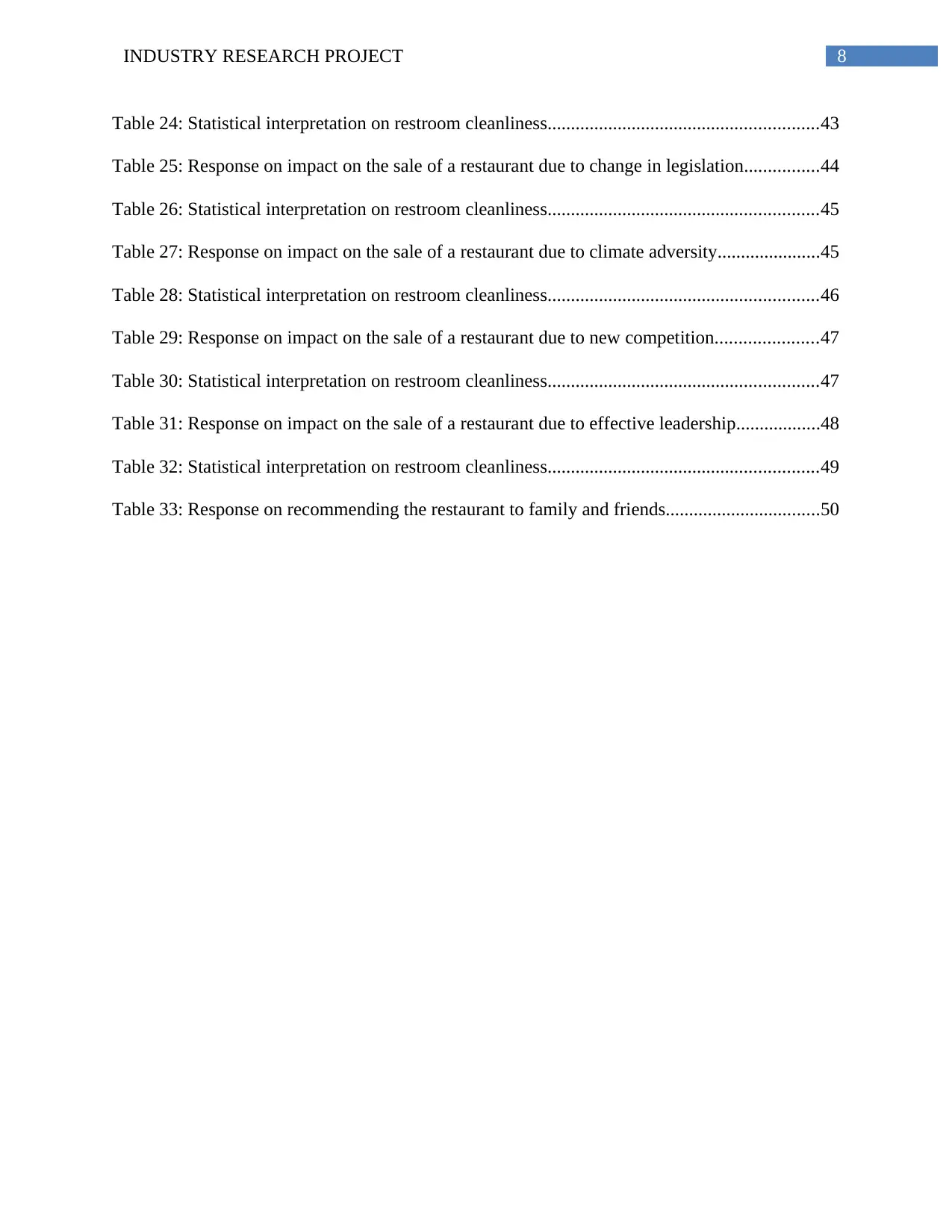
8INDUSTRY RESEARCH PROJECT
Table 24: Statistical interpretation on restroom cleanliness..........................................................43
Table 25: Response on impact on the sale of a restaurant due to change in legislation................44
Table 26: Statistical interpretation on restroom cleanliness..........................................................45
Table 27: Response on impact on the sale of a restaurant due to climate adversity......................45
Table 28: Statistical interpretation on restroom cleanliness..........................................................46
Table 29: Response on impact on the sale of a restaurant due to new competition......................47
Table 30: Statistical interpretation on restroom cleanliness..........................................................47
Table 31: Response on impact on the sale of a restaurant due to effective leadership..................48
Table 32: Statistical interpretation on restroom cleanliness..........................................................49
Table 33: Response on recommending the restaurant to family and friends.................................50
Table 24: Statistical interpretation on restroom cleanliness..........................................................43
Table 25: Response on impact on the sale of a restaurant due to change in legislation................44
Table 26: Statistical interpretation on restroom cleanliness..........................................................45
Table 27: Response on impact on the sale of a restaurant due to climate adversity......................45
Table 28: Statistical interpretation on restroom cleanliness..........................................................46
Table 29: Response on impact on the sale of a restaurant due to new competition......................47
Table 30: Statistical interpretation on restroom cleanliness..........................................................47
Table 31: Response on impact on the sale of a restaurant due to effective leadership..................48
Table 32: Statistical interpretation on restroom cleanliness..........................................................49
Table 33: Response on recommending the restaurant to family and friends.................................50
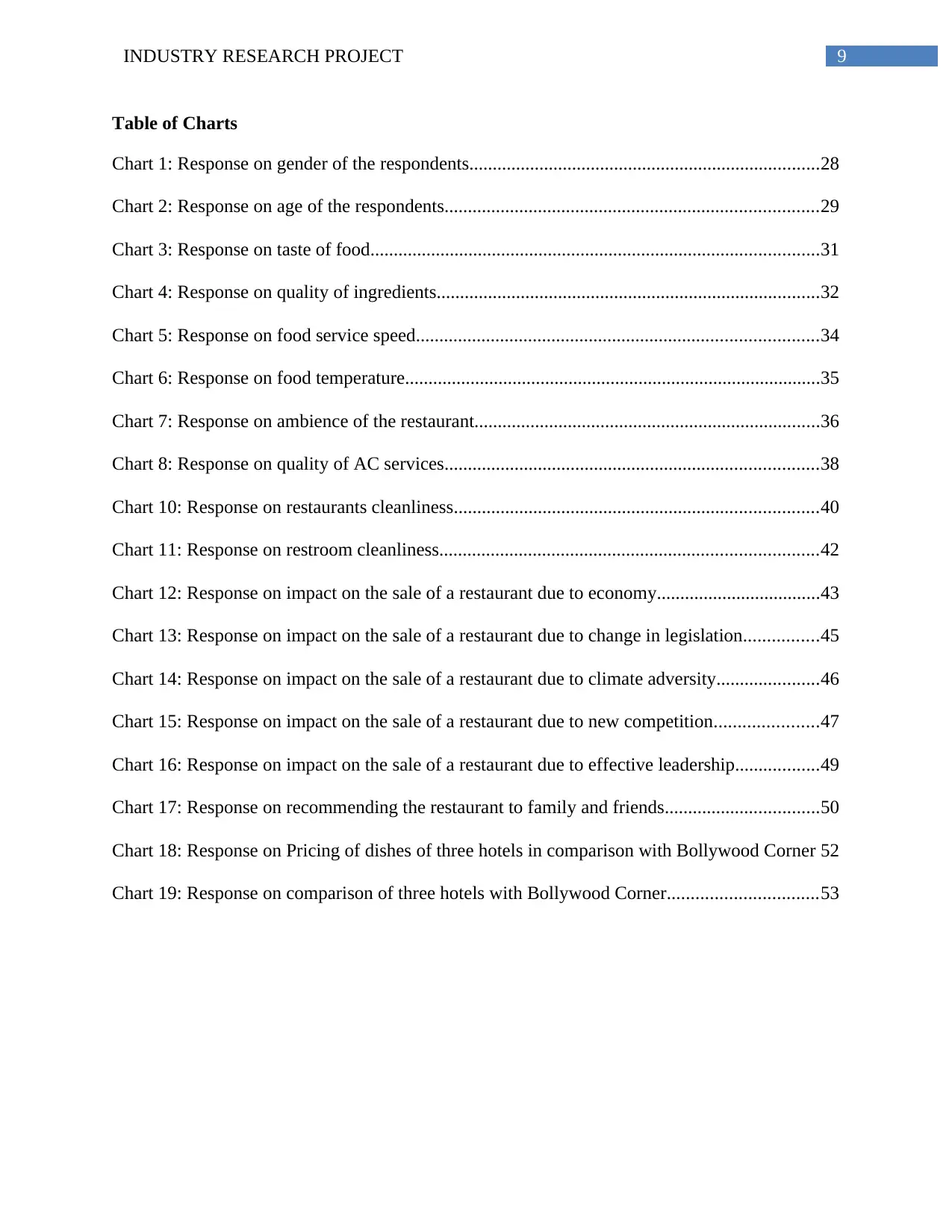
9INDUSTRY RESEARCH PROJECT
Table of Charts
Chart 1: Response on gender of the respondents...........................................................................28
Chart 2: Response on age of the respondents................................................................................29
Chart 3: Response on taste of food................................................................................................31
Chart 4: Response on quality of ingredients..................................................................................32
Chart 5: Response on food service speed......................................................................................34
Chart 6: Response on food temperature.........................................................................................35
Chart 7: Response on ambience of the restaurant..........................................................................36
Chart 8: Response on quality of AC services................................................................................38
Chart 10: Response on restaurants cleanliness..............................................................................40
Chart 11: Response on restroom cleanliness.................................................................................42
Chart 12: Response on impact on the sale of a restaurant due to economy...................................43
Chart 13: Response on impact on the sale of a restaurant due to change in legislation................45
Chart 14: Response on impact on the sale of a restaurant due to climate adversity......................46
Chart 15: Response on impact on the sale of a restaurant due to new competition......................47
Chart 16: Response on impact on the sale of a restaurant due to effective leadership..................49
Chart 17: Response on recommending the restaurant to family and friends.................................50
Chart 18: Response on Pricing of dishes of three hotels in comparison with Bollywood Corner 52
Chart 19: Response on comparison of three hotels with Bollywood Corner................................53
Table of Charts
Chart 1: Response on gender of the respondents...........................................................................28
Chart 2: Response on age of the respondents................................................................................29
Chart 3: Response on taste of food................................................................................................31
Chart 4: Response on quality of ingredients..................................................................................32
Chart 5: Response on food service speed......................................................................................34
Chart 6: Response on food temperature.........................................................................................35
Chart 7: Response on ambience of the restaurant..........................................................................36
Chart 8: Response on quality of AC services................................................................................38
Chart 10: Response on restaurants cleanliness..............................................................................40
Chart 11: Response on restroom cleanliness.................................................................................42
Chart 12: Response on impact on the sale of a restaurant due to economy...................................43
Chart 13: Response on impact on the sale of a restaurant due to change in legislation................45
Chart 14: Response on impact on the sale of a restaurant due to climate adversity......................46
Chart 15: Response on impact on the sale of a restaurant due to new competition......................47
Chart 16: Response on impact on the sale of a restaurant due to effective leadership..................49
Chart 17: Response on recommending the restaurant to family and friends.................................50
Chart 18: Response on Pricing of dishes of three hotels in comparison with Bollywood Corner 52
Chart 19: Response on comparison of three hotels with Bollywood Corner................................53
Secure Best Marks with AI Grader
Need help grading? Try our AI Grader for instant feedback on your assignments.
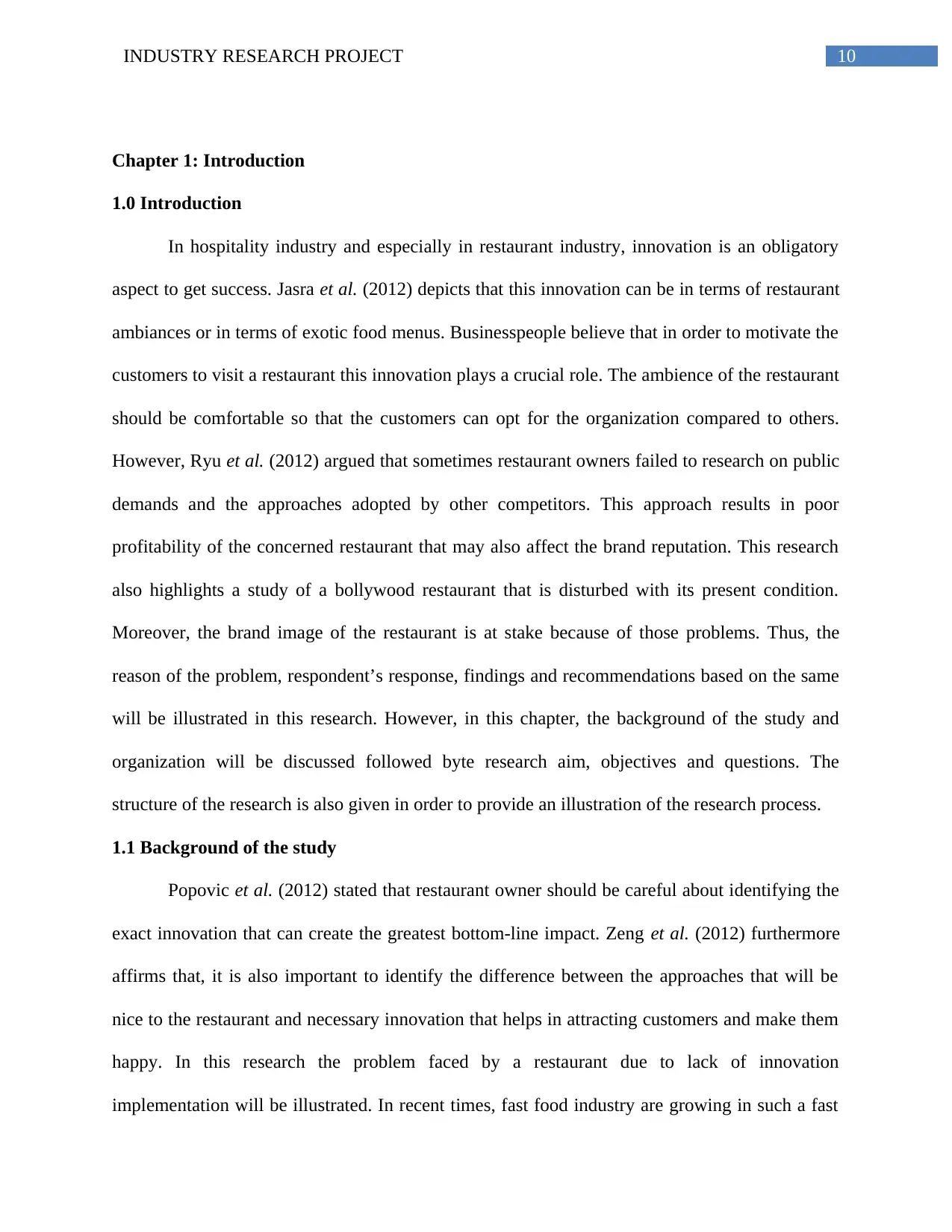
10INDUSTRY RESEARCH PROJECT
Chapter 1: Introduction
1.0 Introduction
In hospitality industry and especially in restaurant industry, innovation is an obligatory
aspect to get success. Jasra et al. (2012) depicts that this innovation can be in terms of restaurant
ambiances or in terms of exotic food menus. Businesspeople believe that in order to motivate the
customers to visit a restaurant this innovation plays a crucial role. The ambience of the restaurant
should be comfortable so that the customers can opt for the organization compared to others.
However, Ryu et al. (2012) argued that sometimes restaurant owners failed to research on public
demands and the approaches adopted by other competitors. This approach results in poor
profitability of the concerned restaurant that may also affect the brand reputation. This research
also highlights a study of a bollywood restaurant that is disturbed with its present condition.
Moreover, the brand image of the restaurant is at stake because of those problems. Thus, the
reason of the problem, respondent’s response, findings and recommendations based on the same
will be illustrated in this research. However, in this chapter, the background of the study and
organization will be discussed followed byte research aim, objectives and questions. The
structure of the research is also given in order to provide an illustration of the research process.
1.1 Background of the study
Popovic et al. (2012) stated that restaurant owner should be careful about identifying the
exact innovation that can create the greatest bottom-line impact. Zeng et al. (2012) furthermore
affirms that, it is also important to identify the difference between the approaches that will be
nice to the restaurant and necessary innovation that helps in attracting customers and make them
happy. In this research the problem faced by a restaurant due to lack of innovation
implementation will be illustrated. In recent times, fast food industry are growing in such a fast
Chapter 1: Introduction
1.0 Introduction
In hospitality industry and especially in restaurant industry, innovation is an obligatory
aspect to get success. Jasra et al. (2012) depicts that this innovation can be in terms of restaurant
ambiances or in terms of exotic food menus. Businesspeople believe that in order to motivate the
customers to visit a restaurant this innovation plays a crucial role. The ambience of the restaurant
should be comfortable so that the customers can opt for the organization compared to others.
However, Ryu et al. (2012) argued that sometimes restaurant owners failed to research on public
demands and the approaches adopted by other competitors. This approach results in poor
profitability of the concerned restaurant that may also affect the brand reputation. This research
also highlights a study of a bollywood restaurant that is disturbed with its present condition.
Moreover, the brand image of the restaurant is at stake because of those problems. Thus, the
reason of the problem, respondent’s response, findings and recommendations based on the same
will be illustrated in this research. However, in this chapter, the background of the study and
organization will be discussed followed byte research aim, objectives and questions. The
structure of the research is also given in order to provide an illustration of the research process.
1.1 Background of the study
Popovic et al. (2012) stated that restaurant owner should be careful about identifying the
exact innovation that can create the greatest bottom-line impact. Zeng et al. (2012) furthermore
affirms that, it is also important to identify the difference between the approaches that will be
nice to the restaurant and necessary innovation that helps in attracting customers and make them
happy. In this research the problem faced by a restaurant due to lack of innovation
implementation will be illustrated. In recent times, fast food industry are growing in such a fast
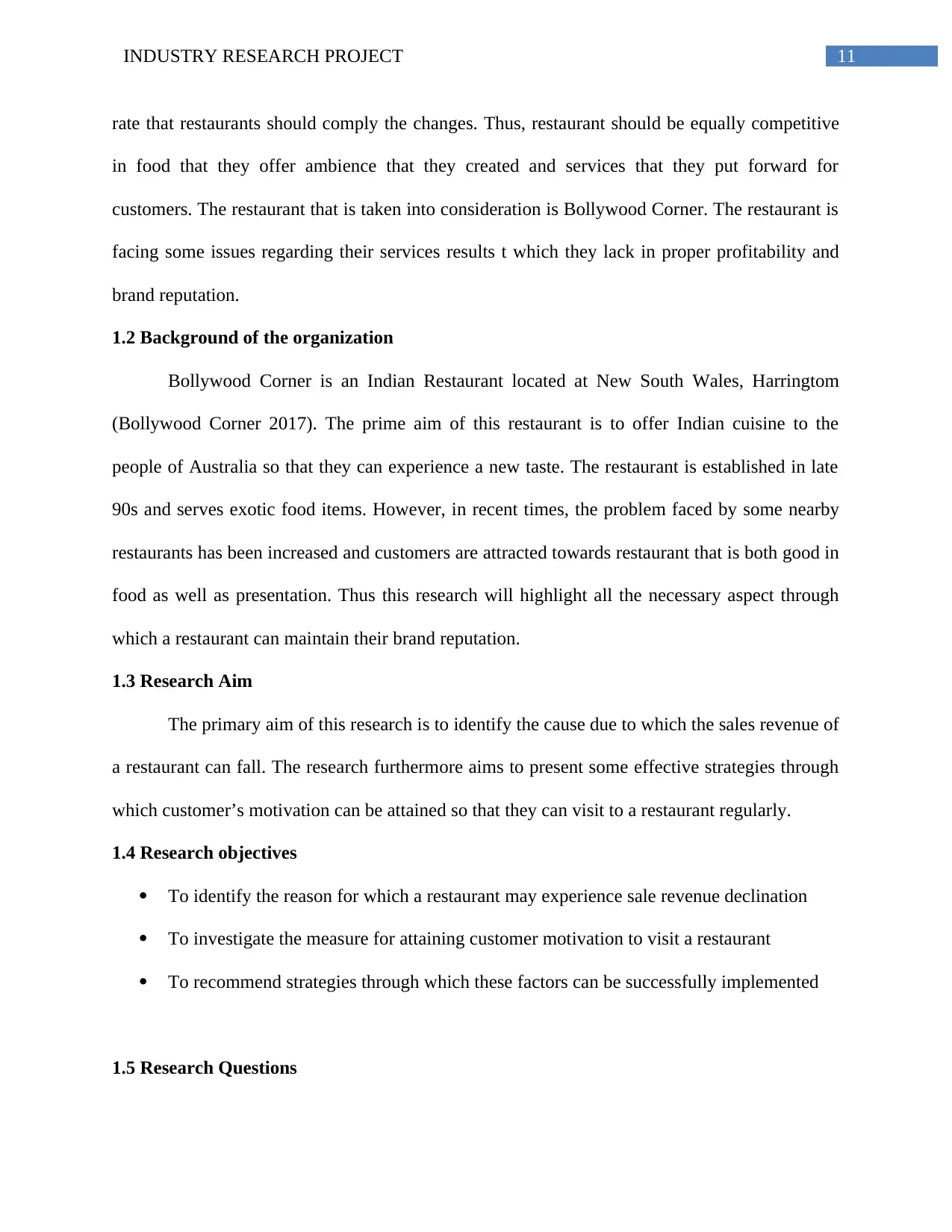
11INDUSTRY RESEARCH PROJECT
rate that restaurants should comply the changes. Thus, restaurant should be equally competitive
in food that they offer ambience that they created and services that they put forward for
customers. The restaurant that is taken into consideration is Bollywood Corner. The restaurant is
facing some issues regarding their services results t which they lack in proper profitability and
brand reputation.
1.2 Background of the organization
Bollywood Corner is an Indian Restaurant located at New South Wales, Harringtom
(Bollywood Corner 2017). The prime aim of this restaurant is to offer Indian cuisine to the
people of Australia so that they can experience a new taste. The restaurant is established in late
90s and serves exotic food items. However, in recent times, the problem faced by some nearby
restaurants has been increased and customers are attracted towards restaurant that is both good in
food as well as presentation. Thus this research will highlight all the necessary aspect through
which a restaurant can maintain their brand reputation.
1.3 Research Aim
The primary aim of this research is to identify the cause due to which the sales revenue of
a restaurant can fall. The research furthermore aims to present some effective strategies through
which customer’s motivation can be attained so that they can visit to a restaurant regularly.
1.4 Research objectives
To identify the reason for which a restaurant may experience sale revenue declination
To investigate the measure for attaining customer motivation to visit a restaurant
To recommend strategies through which these factors can be successfully implemented
1.5 Research Questions
rate that restaurants should comply the changes. Thus, restaurant should be equally competitive
in food that they offer ambience that they created and services that they put forward for
customers. The restaurant that is taken into consideration is Bollywood Corner. The restaurant is
facing some issues regarding their services results t which they lack in proper profitability and
brand reputation.
1.2 Background of the organization
Bollywood Corner is an Indian Restaurant located at New South Wales, Harringtom
(Bollywood Corner 2017). The prime aim of this restaurant is to offer Indian cuisine to the
people of Australia so that they can experience a new taste. The restaurant is established in late
90s and serves exotic food items. However, in recent times, the problem faced by some nearby
restaurants has been increased and customers are attracted towards restaurant that is both good in
food as well as presentation. Thus this research will highlight all the necessary aspect through
which a restaurant can maintain their brand reputation.
1.3 Research Aim
The primary aim of this research is to identify the cause due to which the sales revenue of
a restaurant can fall. The research furthermore aims to present some effective strategies through
which customer’s motivation can be attained so that they can visit to a restaurant regularly.
1.4 Research objectives
To identify the reason for which a restaurant may experience sale revenue declination
To investigate the measure for attaining customer motivation to visit a restaurant
To recommend strategies through which these factors can be successfully implemented
1.5 Research Questions
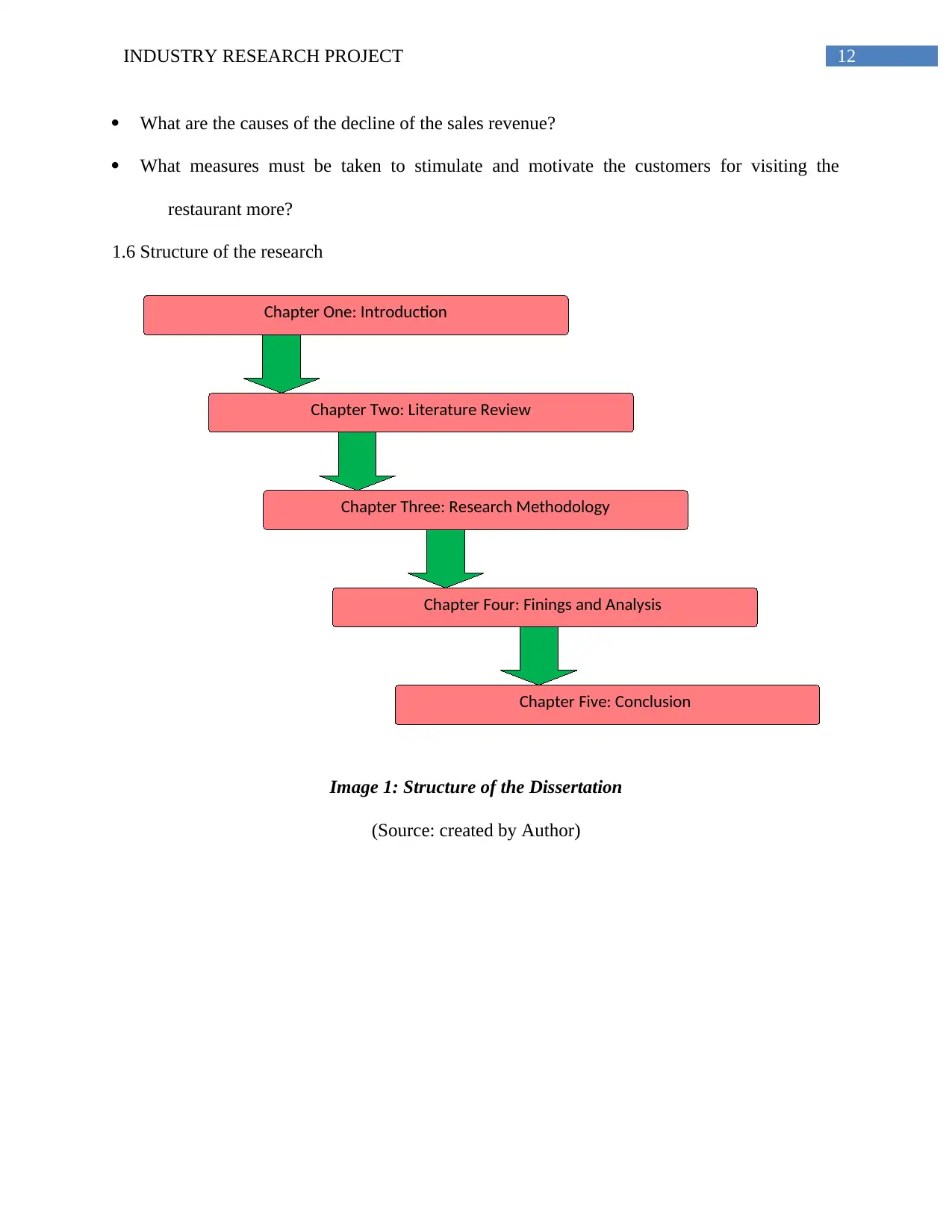
12INDUSTRY RESEARCH PROJECT
Chapter One: Introduction
Chapter Two: Literature Review
Chapter Three: Research Methodology
Chapter Four: Finings and Analysis
Chapter Five: Conclusion
What are the causes of the decline of the sales revenue?
What measures must be taken to stimulate and motivate the customers for visiting the
restaurant more?
1.6 Structure of the research
Image 1: Structure of the Dissertation
(Source: created by Author)
Chapter One: Introduction
Chapter Two: Literature Review
Chapter Three: Research Methodology
Chapter Four: Finings and Analysis
Chapter Five: Conclusion
What are the causes of the decline of the sales revenue?
What measures must be taken to stimulate and motivate the customers for visiting the
restaurant more?
1.6 Structure of the research
Image 1: Structure of the Dissertation
(Source: created by Author)
Paraphrase This Document
Need a fresh take? Get an instant paraphrase of this document with our AI Paraphraser
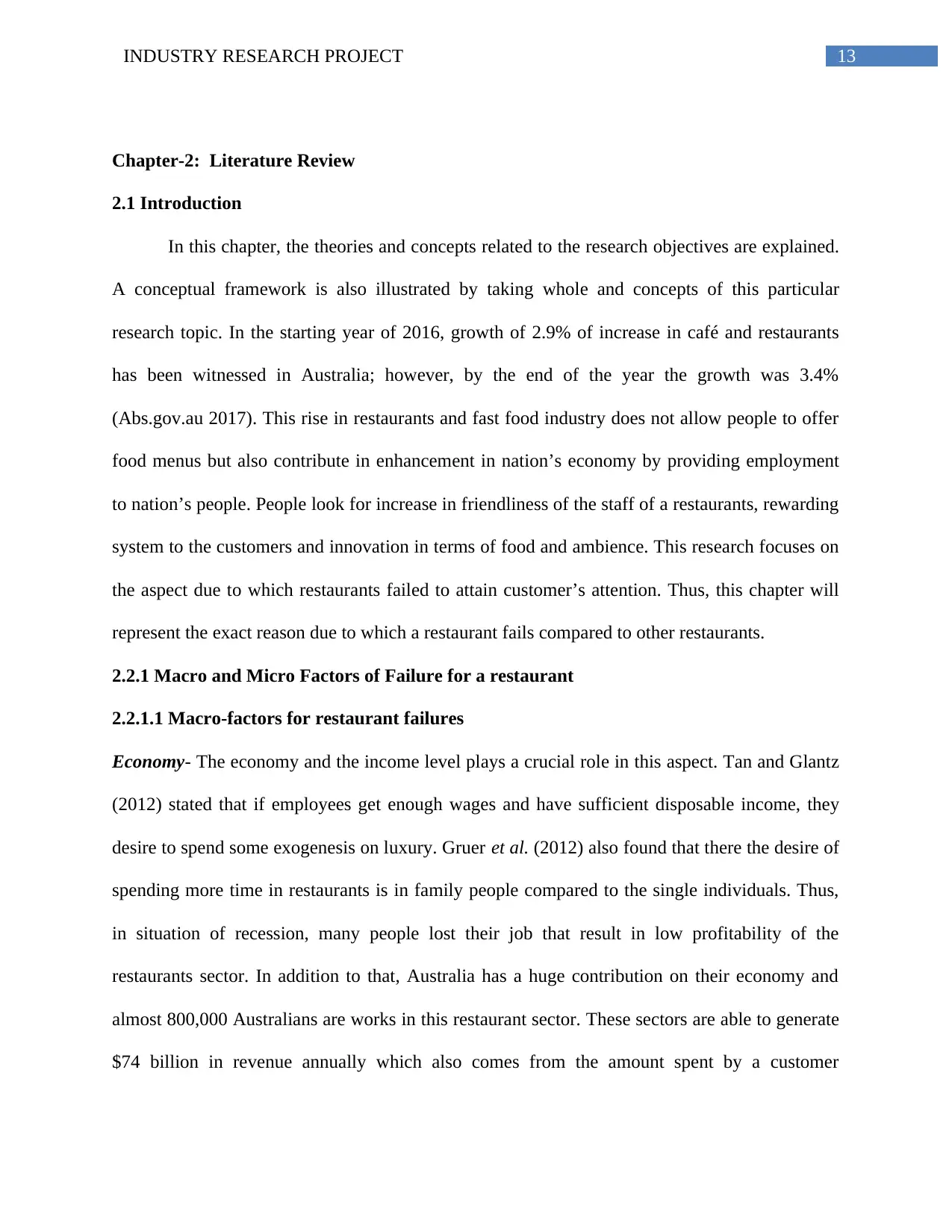
13INDUSTRY RESEARCH PROJECT
Chapter-2: Literature Review
2.1 Introduction
In this chapter, the theories and concepts related to the research objectives are explained.
A conceptual framework is also illustrated by taking whole and concepts of this particular
research topic. In the starting year of 2016, growth of 2.9% of increase in café and restaurants
has been witnessed in Australia; however, by the end of the year the growth was 3.4%
(Abs.gov.au 2017). This rise in restaurants and fast food industry does not allow people to offer
food menus but also contribute in enhancement in nation’s economy by providing employment
to nation’s people. People look for increase in friendliness of the staff of a restaurants, rewarding
system to the customers and innovation in terms of food and ambience. This research focuses on
the aspect due to which restaurants failed to attain customer’s attention. Thus, this chapter will
represent the exact reason due to which a restaurant fails compared to other restaurants.
2.2.1 Macro and Micro Factors of Failure for a restaurant
2.2.1.1 Macro-factors for restaurant failures
Economy- The economy and the income level plays a crucial role in this aspect. Tan and Glantz
(2012) stated that if employees get enough wages and have sufficient disposable income, they
desire to spend some exogenesis on luxury. Gruer et al. (2012) also found that there the desire of
spending more time in restaurants is in family people compared to the single individuals. Thus,
in situation of recession, many people lost their job that result in low profitability of the
restaurants sector. In addition to that, Australia has a huge contribution on their economy and
almost 800,000 Australians are works in this restaurant sector. These sectors are able to generate
$74 billion in revenue annually which also comes from the amount spent by a customer
Chapter-2: Literature Review
2.1 Introduction
In this chapter, the theories and concepts related to the research objectives are explained.
A conceptual framework is also illustrated by taking whole and concepts of this particular
research topic. In the starting year of 2016, growth of 2.9% of increase in café and restaurants
has been witnessed in Australia; however, by the end of the year the growth was 3.4%
(Abs.gov.au 2017). This rise in restaurants and fast food industry does not allow people to offer
food menus but also contribute in enhancement in nation’s economy by providing employment
to nation’s people. People look for increase in friendliness of the staff of a restaurants, rewarding
system to the customers and innovation in terms of food and ambience. This research focuses on
the aspect due to which restaurants failed to attain customer’s attention. Thus, this chapter will
represent the exact reason due to which a restaurant fails compared to other restaurants.
2.2.1 Macro and Micro Factors of Failure for a restaurant
2.2.1.1 Macro-factors for restaurant failures
Economy- The economy and the income level plays a crucial role in this aspect. Tan and Glantz
(2012) stated that if employees get enough wages and have sufficient disposable income, they
desire to spend some exogenesis on luxury. Gruer et al. (2012) also found that there the desire of
spending more time in restaurants is in family people compared to the single individuals. Thus,
in situation of recession, many people lost their job that result in low profitability of the
restaurants sector. In addition to that, Australia has a huge contribution on their economy and
almost 800,000 Australians are works in this restaurant sector. These sectors are able to generate
$74 billion in revenue annually which also comes from the amount spent by a customer
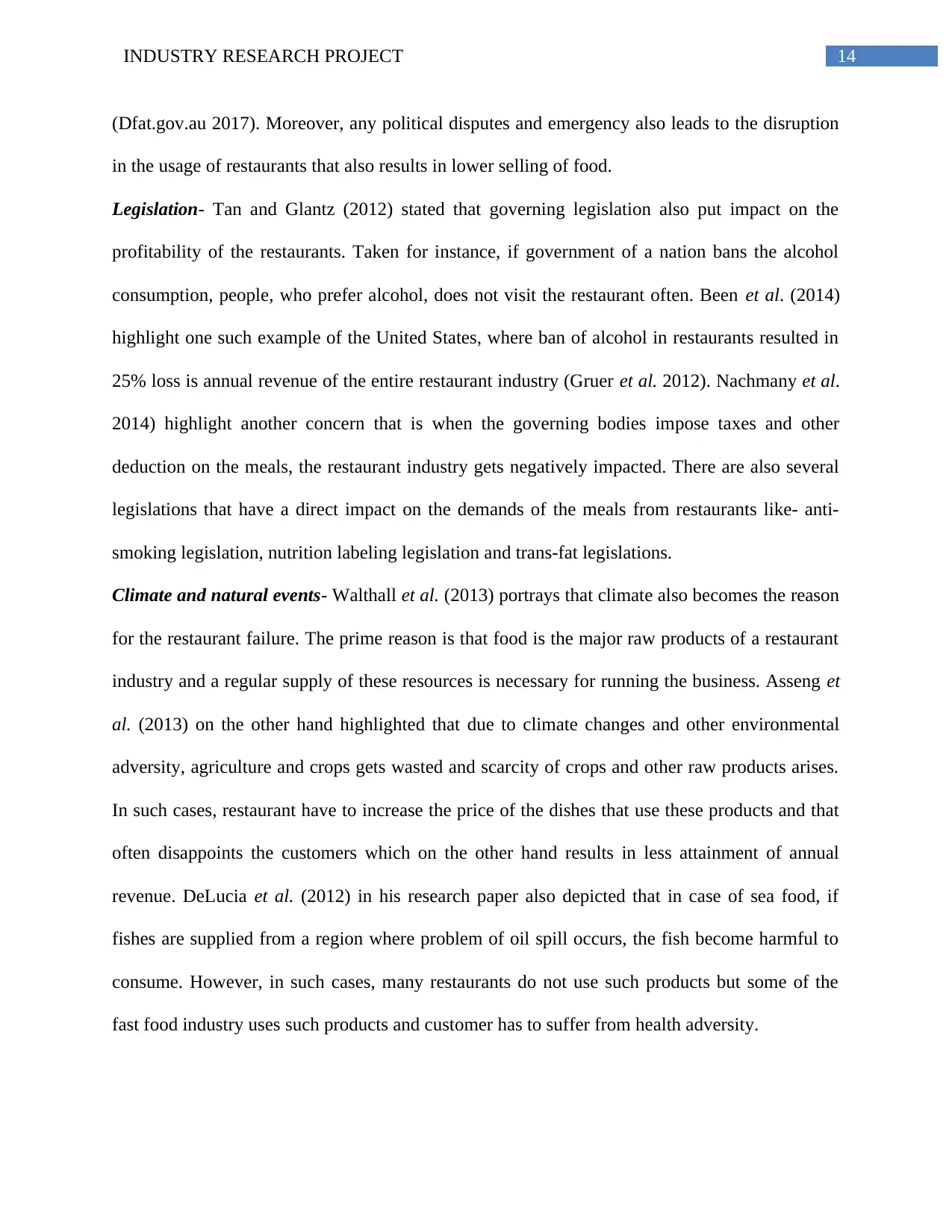
14INDUSTRY RESEARCH PROJECT
(Dfat.gov.au 2017). Moreover, any political disputes and emergency also leads to the disruption
in the usage of restaurants that also results in lower selling of food.
Legislation- Tan and Glantz (2012) stated that governing legislation also put impact on the
profitability of the restaurants. Taken for instance, if government of a nation bans the alcohol
consumption, people, who prefer alcohol, does not visit the restaurant often. Been et al. (2014)
highlight one such example of the United States, where ban of alcohol in restaurants resulted in
25% loss is annual revenue of the entire restaurant industry (Gruer et al. 2012). Nachmany et al.
2014) highlight another concern that is when the governing bodies impose taxes and other
deduction on the meals, the restaurant industry gets negatively impacted. There are also several
legislations that have a direct impact on the demands of the meals from restaurants like- anti-
smoking legislation, nutrition labeling legislation and trans-fat legislations.
Climate and natural events- Walthall et al. (2013) portrays that climate also becomes the reason
for the restaurant failure. The prime reason is that food is the major raw products of a restaurant
industry and a regular supply of these resources is necessary for running the business. Asseng et
al. (2013) on the other hand highlighted that due to climate changes and other environmental
adversity, agriculture and crops gets wasted and scarcity of crops and other raw products arises.
In such cases, restaurant have to increase the price of the dishes that use these products and that
often disappoints the customers which on the other hand results in less attainment of annual
revenue. DeLucia et al. (2012) in his research paper also depicted that in case of sea food, if
fishes are supplied from a region where problem of oil spill occurs, the fish become harmful to
consume. However, in such cases, many restaurants do not use such products but some of the
fast food industry uses such products and customer has to suffer from health adversity.
(Dfat.gov.au 2017). Moreover, any political disputes and emergency also leads to the disruption
in the usage of restaurants that also results in lower selling of food.
Legislation- Tan and Glantz (2012) stated that governing legislation also put impact on the
profitability of the restaurants. Taken for instance, if government of a nation bans the alcohol
consumption, people, who prefer alcohol, does not visit the restaurant often. Been et al. (2014)
highlight one such example of the United States, where ban of alcohol in restaurants resulted in
25% loss is annual revenue of the entire restaurant industry (Gruer et al. 2012). Nachmany et al.
2014) highlight another concern that is when the governing bodies impose taxes and other
deduction on the meals, the restaurant industry gets negatively impacted. There are also several
legislations that have a direct impact on the demands of the meals from restaurants like- anti-
smoking legislation, nutrition labeling legislation and trans-fat legislations.
Climate and natural events- Walthall et al. (2013) portrays that climate also becomes the reason
for the restaurant failure. The prime reason is that food is the major raw products of a restaurant
industry and a regular supply of these resources is necessary for running the business. Asseng et
al. (2013) on the other hand highlighted that due to climate changes and other environmental
adversity, agriculture and crops gets wasted and scarcity of crops and other raw products arises.
In such cases, restaurant have to increase the price of the dishes that use these products and that
often disappoints the customers which on the other hand results in less attainment of annual
revenue. DeLucia et al. (2012) in his research paper also depicted that in case of sea food, if
fishes are supplied from a region where problem of oil spill occurs, the fish become harmful to
consume. However, in such cases, many restaurants do not use such products but some of the
fast food industry uses such products and customer has to suffer from health adversity.
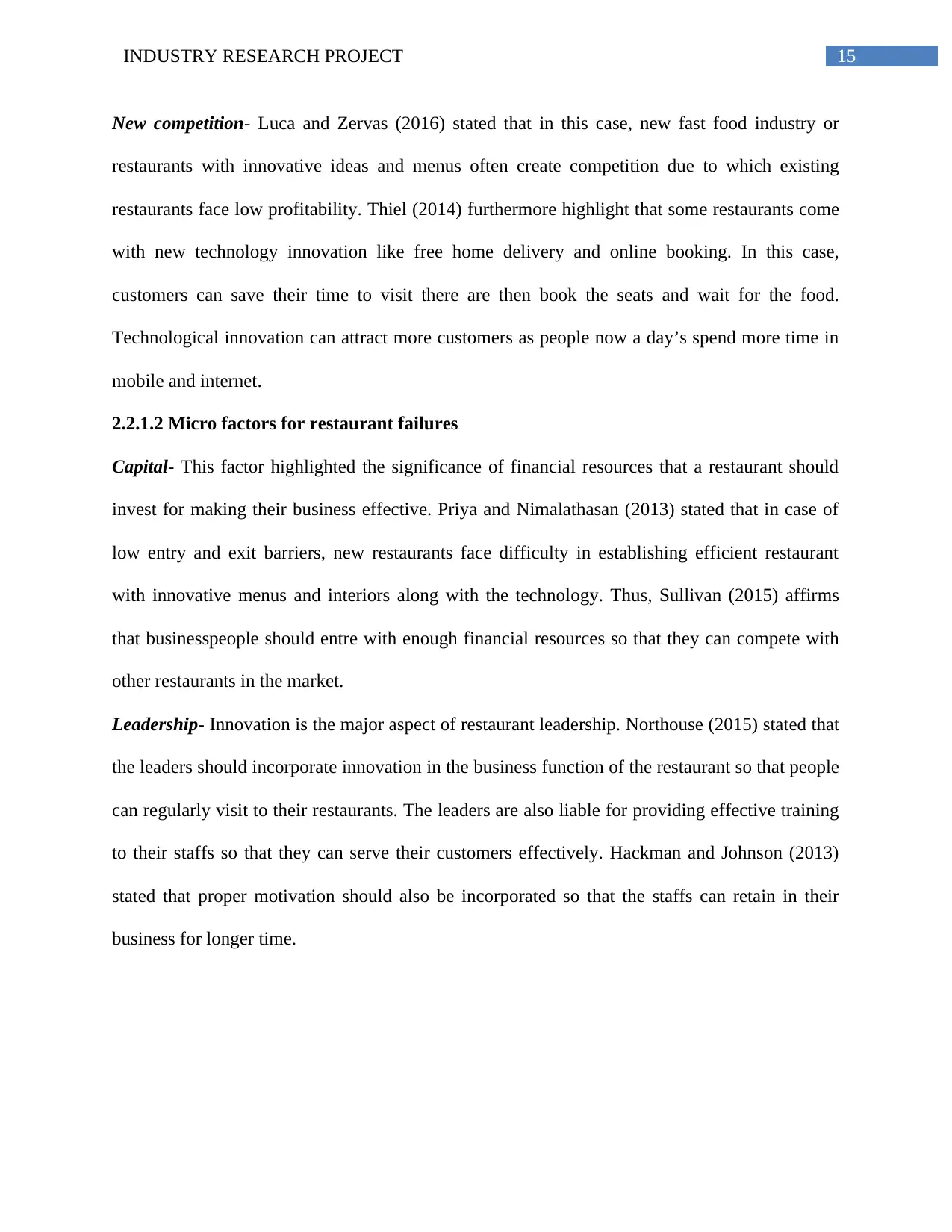
15INDUSTRY RESEARCH PROJECT
New competition- Luca and Zervas (2016) stated that in this case, new fast food industry or
restaurants with innovative ideas and menus often create competition due to which existing
restaurants face low profitability. Thiel (2014) furthermore highlight that some restaurants come
with new technology innovation like free home delivery and online booking. In this case,
customers can save their time to visit there are then book the seats and wait for the food.
Technological innovation can attract more customers as people now a day’s spend more time in
mobile and internet.
2.2.1.2 Micro factors for restaurant failures
Capital- This factor highlighted the significance of financial resources that a restaurant should
invest for making their business effective. Priya and Nimalathasan (2013) stated that in case of
low entry and exit barriers, new restaurants face difficulty in establishing efficient restaurant
with innovative menus and interiors along with the technology. Thus, Sullivan (2015) affirms
that businesspeople should entre with enough financial resources so that they can compete with
other restaurants in the market.
Leadership- Innovation is the major aspect of restaurant leadership. Northouse (2015) stated that
the leaders should incorporate innovation in the business function of the restaurant so that people
can regularly visit to their restaurants. The leaders are also liable for providing effective training
to their staffs so that they can serve their customers effectively. Hackman and Johnson (2013)
stated that proper motivation should also be incorporated so that the staffs can retain in their
business for longer time.
New competition- Luca and Zervas (2016) stated that in this case, new fast food industry or
restaurants with innovative ideas and menus often create competition due to which existing
restaurants face low profitability. Thiel (2014) furthermore highlight that some restaurants come
with new technology innovation like free home delivery and online booking. In this case,
customers can save their time to visit there are then book the seats and wait for the food.
Technological innovation can attract more customers as people now a day’s spend more time in
mobile and internet.
2.2.1.2 Micro factors for restaurant failures
Capital- This factor highlighted the significance of financial resources that a restaurant should
invest for making their business effective. Priya and Nimalathasan (2013) stated that in case of
low entry and exit barriers, new restaurants face difficulty in establishing efficient restaurant
with innovative menus and interiors along with the technology. Thus, Sullivan (2015) affirms
that businesspeople should entre with enough financial resources so that they can compete with
other restaurants in the market.
Leadership- Innovation is the major aspect of restaurant leadership. Northouse (2015) stated that
the leaders should incorporate innovation in the business function of the restaurant so that people
can regularly visit to their restaurants. The leaders are also liable for providing effective training
to their staffs so that they can serve their customers effectively. Hackman and Johnson (2013)
stated that proper motivation should also be incorporated so that the staffs can retain in their
business for longer time.
Secure Best Marks with AI Grader
Need help grading? Try our AI Grader for instant feedback on your assignments.
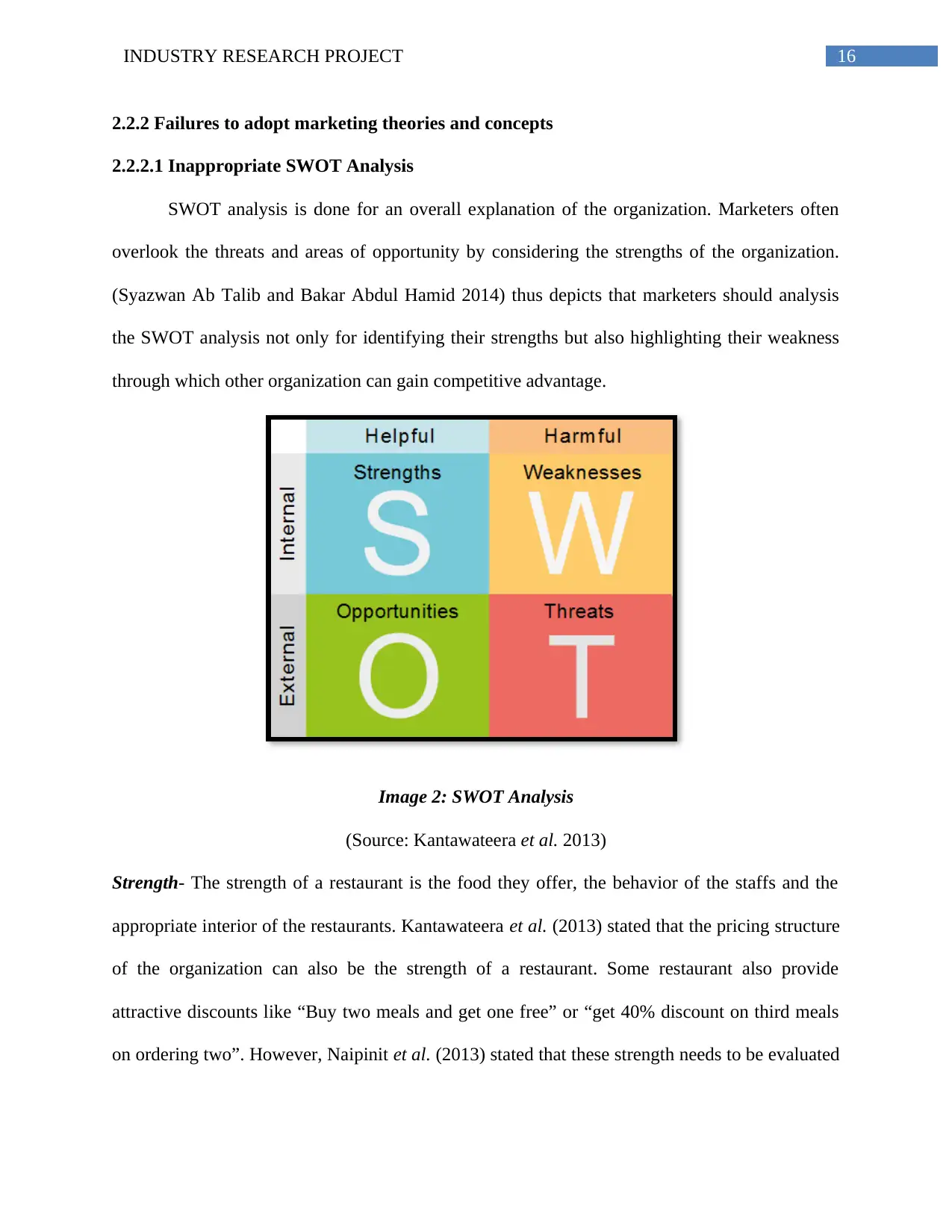
16INDUSTRY RESEARCH PROJECT
2.2.2 Failures to adopt marketing theories and concepts
2.2.2.1 Inappropriate SWOT Analysis
SWOT analysis is done for an overall explanation of the organization. Marketers often
overlook the threats and areas of opportunity by considering the strengths of the organization.
(Syazwan Ab Talib and Bakar Abdul Hamid 2014) thus depicts that marketers should analysis
the SWOT analysis not only for identifying their strengths but also highlighting their weakness
through which other organization can gain competitive advantage.
Image 2: SWOT Analysis
(Source: Kantawateera et al. 2013)
Strength- The strength of a restaurant is the food they offer, the behavior of the staffs and the
appropriate interior of the restaurants. Kantawateera et al. (2013) stated that the pricing structure
of the organization can also be the strength of a restaurant. Some restaurant also provide
attractive discounts like “Buy two meals and get one free” or “get 40% discount on third meals
on ordering two”. However, Naipinit et al. (2013) stated that these strength needs to be evaluated
2.2.2 Failures to adopt marketing theories and concepts
2.2.2.1 Inappropriate SWOT Analysis
SWOT analysis is done for an overall explanation of the organization. Marketers often
overlook the threats and areas of opportunity by considering the strengths of the organization.
(Syazwan Ab Talib and Bakar Abdul Hamid 2014) thus depicts that marketers should analysis
the SWOT analysis not only for identifying their strengths but also highlighting their weakness
through which other organization can gain competitive advantage.
Image 2: SWOT Analysis
(Source: Kantawateera et al. 2013)
Strength- The strength of a restaurant is the food they offer, the behavior of the staffs and the
appropriate interior of the restaurants. Kantawateera et al. (2013) stated that the pricing structure
of the organization can also be the strength of a restaurant. Some restaurant also provide
attractive discounts like “Buy two meals and get one free” or “get 40% discount on third meals
on ordering two”. However, Naipinit et al. (2013) stated that these strength needs to be evaluated
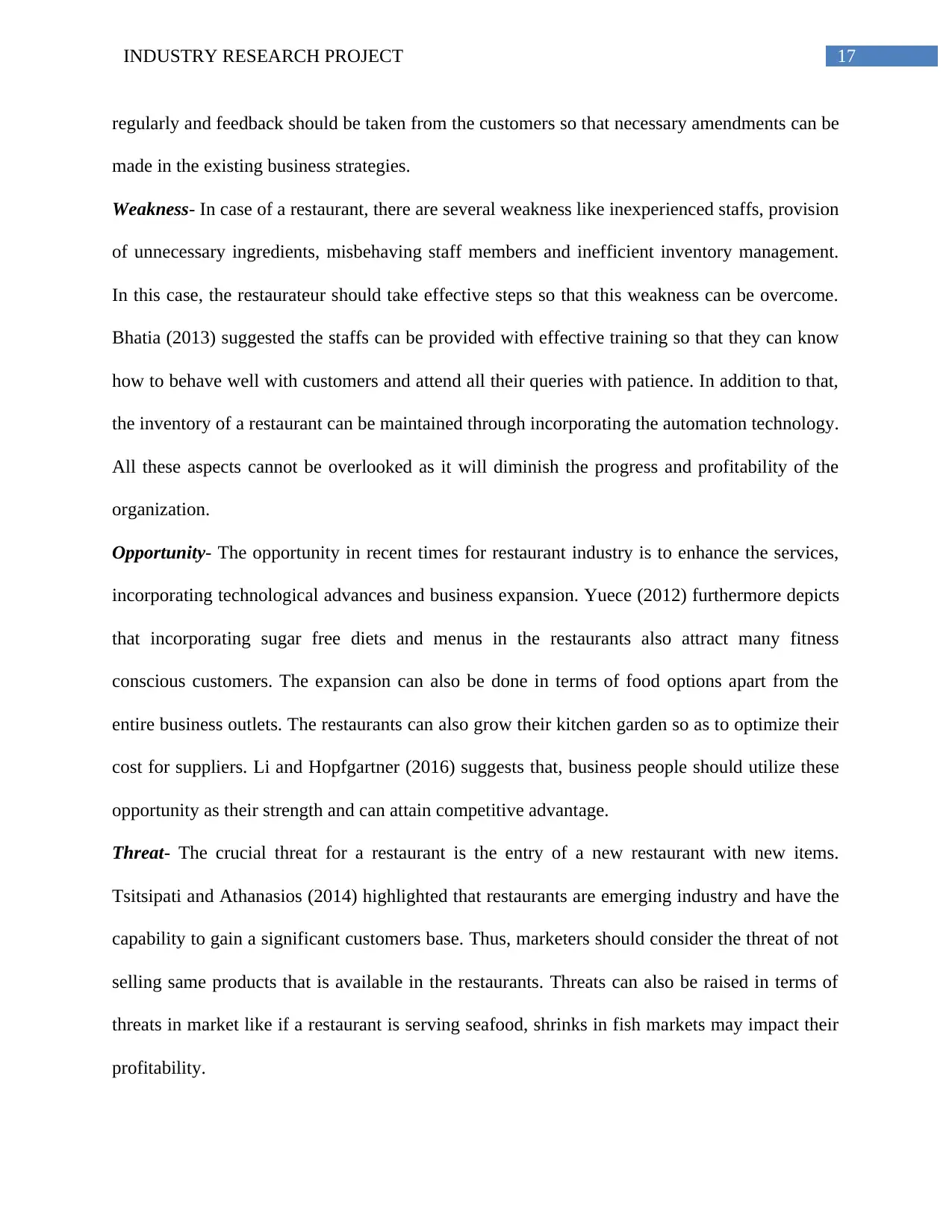
17INDUSTRY RESEARCH PROJECT
regularly and feedback should be taken from the customers so that necessary amendments can be
made in the existing business strategies.
Weakness- In case of a restaurant, there are several weakness like inexperienced staffs, provision
of unnecessary ingredients, misbehaving staff members and inefficient inventory management.
In this case, the restaurateur should take effective steps so that this weakness can be overcome.
Bhatia (2013) suggested the staffs can be provided with effective training so that they can know
how to behave well with customers and attend all their queries with patience. In addition to that,
the inventory of a restaurant can be maintained through incorporating the automation technology.
All these aspects cannot be overlooked as it will diminish the progress and profitability of the
organization.
Opportunity- The opportunity in recent times for restaurant industry is to enhance the services,
incorporating technological advances and business expansion. Yuece (2012) furthermore depicts
that incorporating sugar free diets and menus in the restaurants also attract many fitness
conscious customers. The expansion can also be done in terms of food options apart from the
entire business outlets. The restaurants can also grow their kitchen garden so as to optimize their
cost for suppliers. Li and Hopfgartner (2016) suggests that, business people should utilize these
opportunity as their strength and can attain competitive advantage.
Threat- The crucial threat for a restaurant is the entry of a new restaurant with new items.
Tsitsipati and Athanasios (2014) highlighted that restaurants are emerging industry and have the
capability to gain a significant customers base. Thus, marketers should consider the threat of not
selling same products that is available in the restaurants. Threats can also be raised in terms of
threats in market like if a restaurant is serving seafood, shrinks in fish markets may impact their
profitability.
regularly and feedback should be taken from the customers so that necessary amendments can be
made in the existing business strategies.
Weakness- In case of a restaurant, there are several weakness like inexperienced staffs, provision
of unnecessary ingredients, misbehaving staff members and inefficient inventory management.
In this case, the restaurateur should take effective steps so that this weakness can be overcome.
Bhatia (2013) suggested the staffs can be provided with effective training so that they can know
how to behave well with customers and attend all their queries with patience. In addition to that,
the inventory of a restaurant can be maintained through incorporating the automation technology.
All these aspects cannot be overlooked as it will diminish the progress and profitability of the
organization.
Opportunity- The opportunity in recent times for restaurant industry is to enhance the services,
incorporating technological advances and business expansion. Yuece (2012) furthermore depicts
that incorporating sugar free diets and menus in the restaurants also attract many fitness
conscious customers. The expansion can also be done in terms of food options apart from the
entire business outlets. The restaurants can also grow their kitchen garden so as to optimize their
cost for suppliers. Li and Hopfgartner (2016) suggests that, business people should utilize these
opportunity as their strength and can attain competitive advantage.
Threat- The crucial threat for a restaurant is the entry of a new restaurant with new items.
Tsitsipati and Athanasios (2014) highlighted that restaurants are emerging industry and have the
capability to gain a significant customers base. Thus, marketers should consider the threat of not
selling same products that is available in the restaurants. Threats can also be raised in terms of
threats in market like if a restaurant is serving seafood, shrinks in fish markets may impact their
profitability.

18INDUSTRY RESEARCH PROJECT
2.2.2.2 Problem in marketing mix
Huang and Sarigollu (2014) depict that for a profitable business, it is important for the
managing authority of the organization to identify the success factors of the marketing mix. The
marketing mix comprises of four aspects- products, price, place and promotion.
Image 3: Marketing Mix- 4P
(Source: Huang and Sarigollu 2014)
Product- Restaurateurs usually choose all the available products and ingredients for their menu
but they should also choose those ingredients that are rarely available in that locality. In such
cases, people intend to visit the restaurants more and experience the taste of those food items. In
addition to that, it is also evident that some restaurant uses exotic ingredients and desire to give
fancy names to the dishes. Anitsal et al. (2012) thus depicts that in such cases, customer become
confused and cannot determine the taste of the dishes prior to give order for that particular menu
this is the reason of huge wastage of inventory. Rosenbloom (2012) furthermore depicts that in
such situation, chefs also have to face difficulty in maintaining the menu in a shirt interval of
2.2.2.2 Problem in marketing mix
Huang and Sarigollu (2014) depict that for a profitable business, it is important for the
managing authority of the organization to identify the success factors of the marketing mix. The
marketing mix comprises of four aspects- products, price, place and promotion.
Image 3: Marketing Mix- 4P
(Source: Huang and Sarigollu 2014)
Product- Restaurateurs usually choose all the available products and ingredients for their menu
but they should also choose those ingredients that are rarely available in that locality. In such
cases, people intend to visit the restaurants more and experience the taste of those food items. In
addition to that, it is also evident that some restaurant uses exotic ingredients and desire to give
fancy names to the dishes. Anitsal et al. (2012) thus depicts that in such cases, customer become
confused and cannot determine the taste of the dishes prior to give order for that particular menu
this is the reason of huge wastage of inventory. Rosenbloom (2012) furthermore depicts that in
such situation, chefs also have to face difficulty in maintaining the menu in a shirt interval of
Paraphrase This Document
Need a fresh take? Get an instant paraphrase of this document with our AI Paraphraser
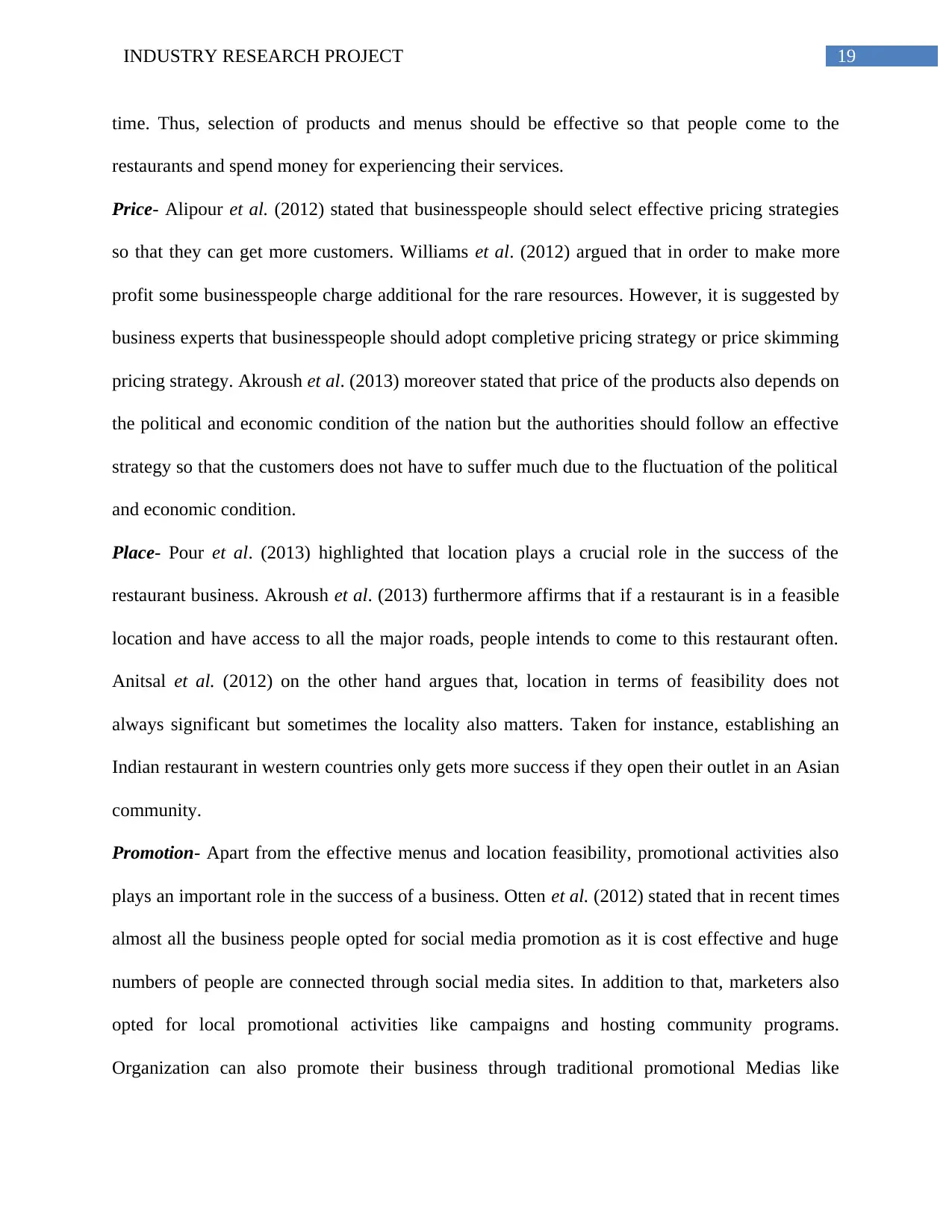
19INDUSTRY RESEARCH PROJECT
time. Thus, selection of products and menus should be effective so that people come to the
restaurants and spend money for experiencing their services.
Price- Alipour et al. (2012) stated that businesspeople should select effective pricing strategies
so that they can get more customers. Williams et al. (2012) argued that in order to make more
profit some businesspeople charge additional for the rare resources. However, it is suggested by
business experts that businesspeople should adopt completive pricing strategy or price skimming
pricing strategy. Akroush et al. (2013) moreover stated that price of the products also depends on
the political and economic condition of the nation but the authorities should follow an effective
strategy so that the customers does not have to suffer much due to the fluctuation of the political
and economic condition.
Place- Pour et al. (2013) highlighted that location plays a crucial role in the success of the
restaurant business. Akroush et al. (2013) furthermore affirms that if a restaurant is in a feasible
location and have access to all the major roads, people intends to come to this restaurant often.
Anitsal et al. (2012) on the other hand argues that, location in terms of feasibility does not
always significant but sometimes the locality also matters. Taken for instance, establishing an
Indian restaurant in western countries only gets more success if they open their outlet in an Asian
community.
Promotion- Apart from the effective menus and location feasibility, promotional activities also
plays an important role in the success of a business. Otten et al. (2012) stated that in recent times
almost all the business people opted for social media promotion as it is cost effective and huge
numbers of people are connected through social media sites. In addition to that, marketers also
opted for local promotional activities like campaigns and hosting community programs.
Organization can also promote their business through traditional promotional Medias like
time. Thus, selection of products and menus should be effective so that people come to the
restaurants and spend money for experiencing their services.
Price- Alipour et al. (2012) stated that businesspeople should select effective pricing strategies
so that they can get more customers. Williams et al. (2012) argued that in order to make more
profit some businesspeople charge additional for the rare resources. However, it is suggested by
business experts that businesspeople should adopt completive pricing strategy or price skimming
pricing strategy. Akroush et al. (2013) moreover stated that price of the products also depends on
the political and economic condition of the nation but the authorities should follow an effective
strategy so that the customers does not have to suffer much due to the fluctuation of the political
and economic condition.
Place- Pour et al. (2013) highlighted that location plays a crucial role in the success of the
restaurant business. Akroush et al. (2013) furthermore affirms that if a restaurant is in a feasible
location and have access to all the major roads, people intends to come to this restaurant often.
Anitsal et al. (2012) on the other hand argues that, location in terms of feasibility does not
always significant but sometimes the locality also matters. Taken for instance, establishing an
Indian restaurant in western countries only gets more success if they open their outlet in an Asian
community.
Promotion- Apart from the effective menus and location feasibility, promotional activities also
plays an important role in the success of a business. Otten et al. (2012) stated that in recent times
almost all the business people opted for social media promotion as it is cost effective and huge
numbers of people are connected through social media sites. In addition to that, marketers also
opted for local promotional activities like campaigns and hosting community programs.
Organization can also promote their business through traditional promotional Medias like
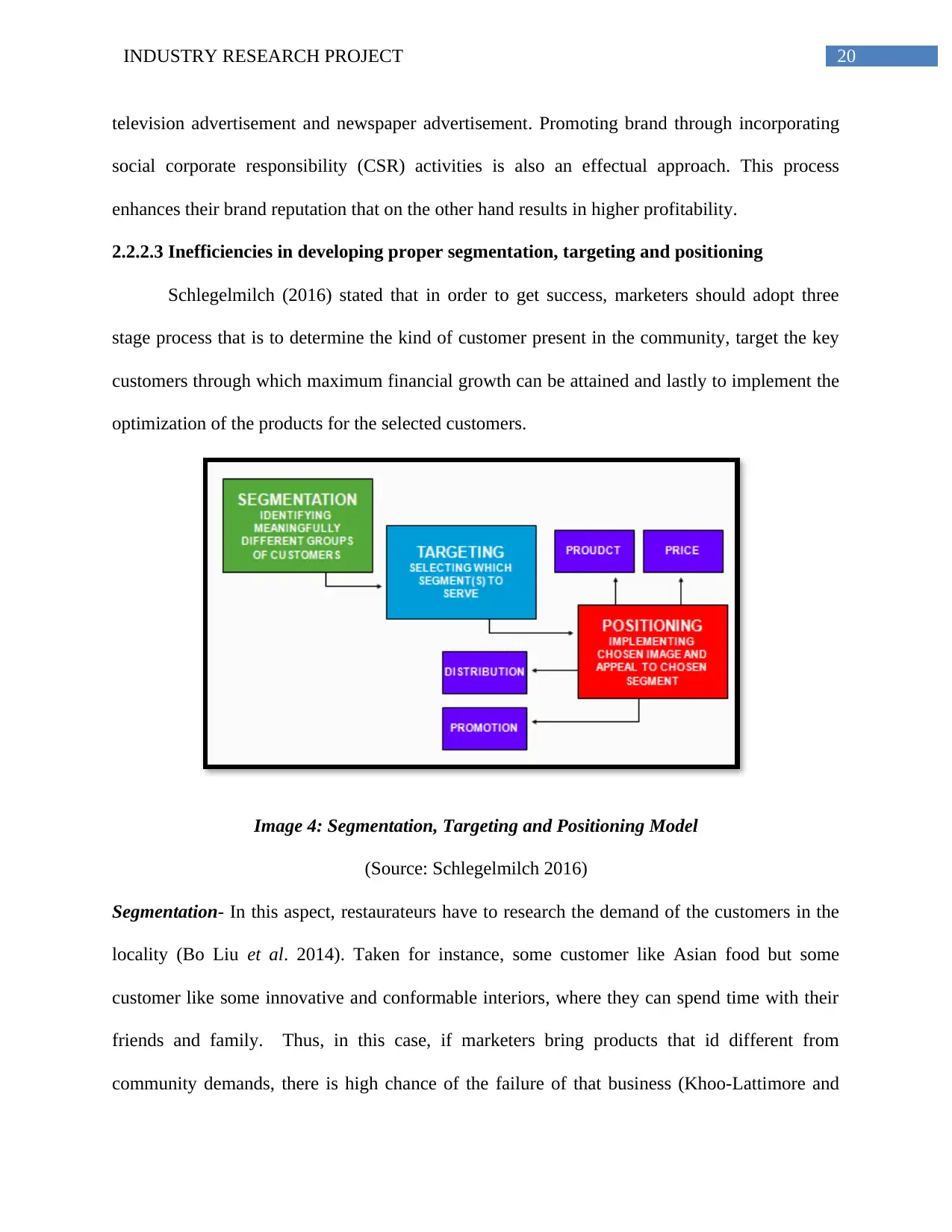
20INDUSTRY RESEARCH PROJECT
television advertisement and newspaper advertisement. Promoting brand through incorporating
social corporate responsibility (CSR) activities is also an effectual approach. This process
enhances their brand reputation that on the other hand results in higher profitability.
2.2.2.3 Inefficiencies in developing proper segmentation, targeting and positioning
Schlegelmilch (2016) stated that in order to get success, marketers should adopt three
stage process that is to determine the kind of customer present in the community, target the key
customers through which maximum financial growth can be attained and lastly to implement the
optimization of the products for the selected customers.
Image 4: Segmentation, Targeting and Positioning Model
(Source: Schlegelmilch 2016)
Segmentation- In this aspect, restaurateurs have to research the demand of the customers in the
locality (Bo Liu et al. 2014). Taken for instance, some customer like Asian food but some
customer like some innovative and conformable interiors, where they can spend time with their
friends and family. Thus, in this case, if marketers bring products that id different from
community demands, there is high chance of the failure of that business (Khoo-Lattimore and
television advertisement and newspaper advertisement. Promoting brand through incorporating
social corporate responsibility (CSR) activities is also an effectual approach. This process
enhances their brand reputation that on the other hand results in higher profitability.
2.2.2.3 Inefficiencies in developing proper segmentation, targeting and positioning
Schlegelmilch (2016) stated that in order to get success, marketers should adopt three
stage process that is to determine the kind of customer present in the community, target the key
customers through which maximum financial growth can be attained and lastly to implement the
optimization of the products for the selected customers.
Image 4: Segmentation, Targeting and Positioning Model
(Source: Schlegelmilch 2016)
Segmentation- In this aspect, restaurateurs have to research the demand of the customers in the
locality (Bo Liu et al. 2014). Taken for instance, some customer like Asian food but some
customer like some innovative and conformable interiors, where they can spend time with their
friends and family. Thus, in this case, if marketers bring products that id different from
community demands, there is high chance of the failure of that business (Khoo-Lattimore and
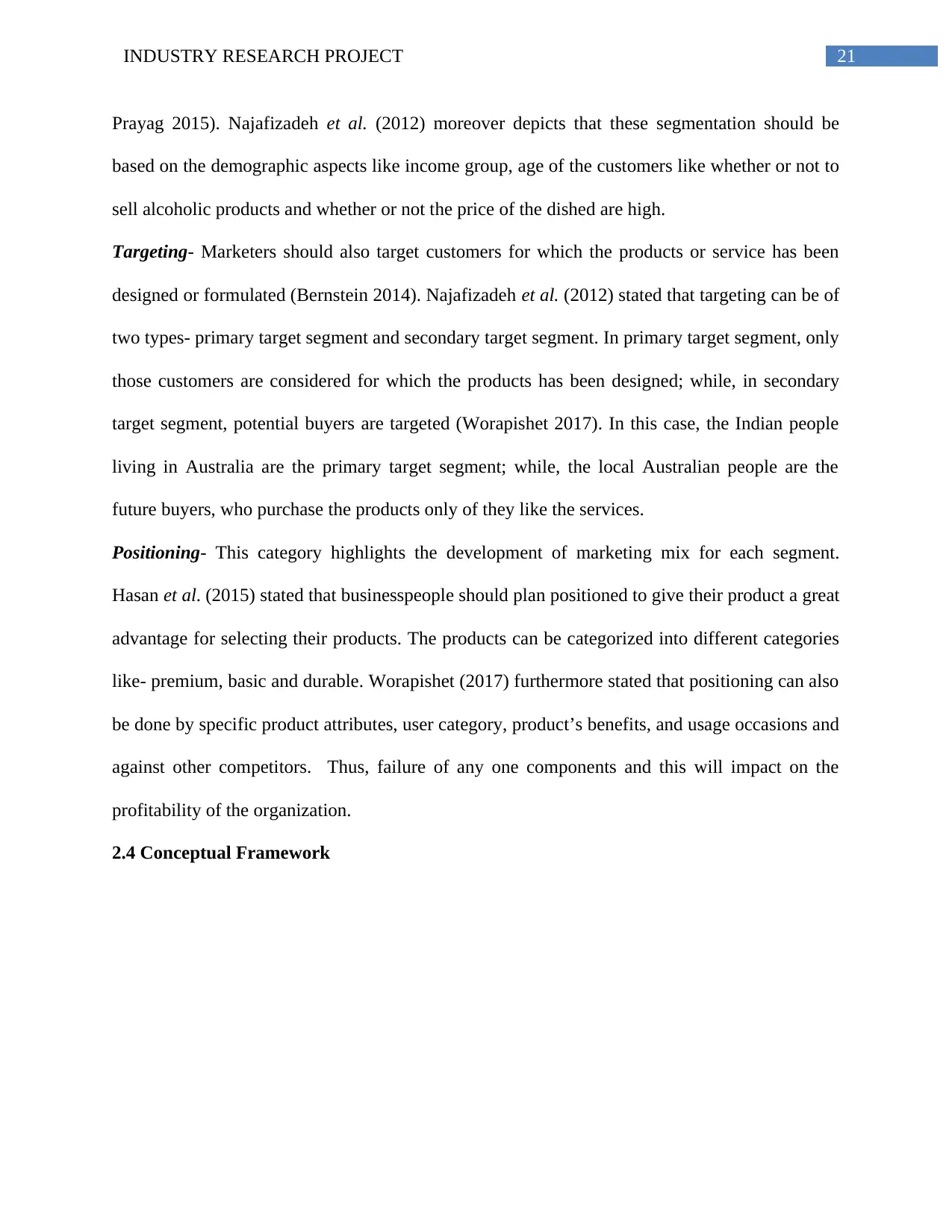
21INDUSTRY RESEARCH PROJECT
Prayag 2015). Najafizadeh et al. (2012) moreover depicts that these segmentation should be
based on the demographic aspects like income group, age of the customers like whether or not to
sell alcoholic products and whether or not the price of the dished are high.
Targeting- Marketers should also target customers for which the products or service has been
designed or formulated (Bernstein 2014). Najafizadeh et al. (2012) stated that targeting can be of
two types- primary target segment and secondary target segment. In primary target segment, only
those customers are considered for which the products has been designed; while, in secondary
target segment, potential buyers are targeted (Worapishet 2017). In this case, the Indian people
living in Australia are the primary target segment; while, the local Australian people are the
future buyers, who purchase the products only of they like the services.
Positioning- This category highlights the development of marketing mix for each segment.
Hasan et al. (2015) stated that businesspeople should plan positioned to give their product a great
advantage for selecting their products. The products can be categorized into different categories
like- premium, basic and durable. Worapishet (2017) furthermore stated that positioning can also
be done by specific product attributes, user category, product’s benefits, and usage occasions and
against other competitors. Thus, failure of any one components and this will impact on the
profitability of the organization.
2.4 Conceptual Framework
Prayag 2015). Najafizadeh et al. (2012) moreover depicts that these segmentation should be
based on the demographic aspects like income group, age of the customers like whether or not to
sell alcoholic products and whether or not the price of the dished are high.
Targeting- Marketers should also target customers for which the products or service has been
designed or formulated (Bernstein 2014). Najafizadeh et al. (2012) stated that targeting can be of
two types- primary target segment and secondary target segment. In primary target segment, only
those customers are considered for which the products has been designed; while, in secondary
target segment, potential buyers are targeted (Worapishet 2017). In this case, the Indian people
living in Australia are the primary target segment; while, the local Australian people are the
future buyers, who purchase the products only of they like the services.
Positioning- This category highlights the development of marketing mix for each segment.
Hasan et al. (2015) stated that businesspeople should plan positioned to give their product a great
advantage for selecting their products. The products can be categorized into different categories
like- premium, basic and durable. Worapishet (2017) furthermore stated that positioning can also
be done by specific product attributes, user category, product’s benefits, and usage occasions and
against other competitors. Thus, failure of any one components and this will impact on the
profitability of the organization.
2.4 Conceptual Framework
Secure Best Marks with AI Grader
Need help grading? Try our AI Grader for instant feedback on your assignments.
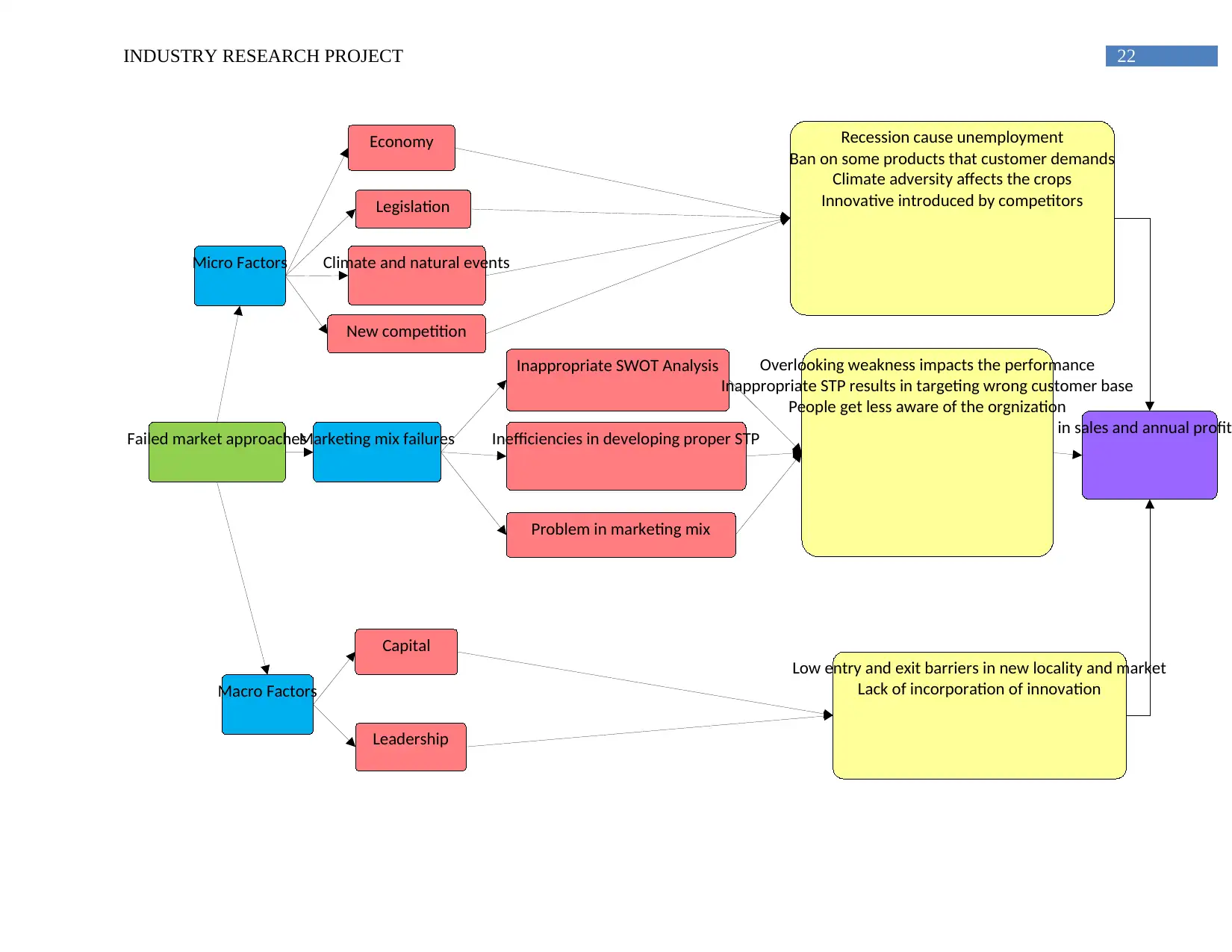
Failed market approaches
Micro Factors
Macro Factors
Marketing mix failures
Economy
Legislation
Climate and natural events
New competition
Capital
Leadership
Inappropriate SWOT Analysis
Problem in marketing mix
Inefficiencies in developing proper STP Loss in sales and annual profit
Recession cause unemployment
Ban on some products that customer demands
Climate adversity affects the crops
Innovative introduced by competitors
Low entry and exit barriers in new locality and market
Lack of incorporation of innovation
Overlooking weakness impacts the performance
Inappropriate STP results in targeting wrong customer base
People get less aware of the orgnization
22INDUSTRY RESEARCH PROJECT
Micro Factors
Macro Factors
Marketing mix failures
Economy
Legislation
Climate and natural events
New competition
Capital
Leadership
Inappropriate SWOT Analysis
Problem in marketing mix
Inefficiencies in developing proper STP Loss in sales and annual profit
Recession cause unemployment
Ban on some products that customer demands
Climate adversity affects the crops
Innovative introduced by competitors
Low entry and exit barriers in new locality and market
Lack of incorporation of innovation
Overlooking weakness impacts the performance
Inappropriate STP results in targeting wrong customer base
People get less aware of the orgnization
22INDUSTRY RESEARCH PROJECT

23INDUSTRY RESEARCH PROJECT
Chapter- 3: Research Methodology
3.0 Introduction
Mackey and Gass (2015) describes that research methodology is a systematic and
theoretical analysis of a study that highlight all the process that is taken for accomplishing a
research. Taylor et al. (2015) furthermore depicts that this chapter is important in a research
study as it provide proper justification of the undertaken research methods and how they helps
the research to obtain the desired objectives. This chapter comprises of details of used research
philosophies, research approach and research purpose along with their justifications. Detail of the
data collection methods, data analysis techniques followed by the sampling techniques and
sample size that is used in the research is also described. Lastly, the information about research
ethics and research limitation is also provided. Thus, the purpose of this chapter is to:
Discuss the research philosophy, approach and purpose with justification
Expand the research strategy that can help to attain the research objectives
3.1 Research Philosophy
Research philosophy is an approach that defines the way for gathering data and
phenomenon (Wang 2015). Siu and Comerasamy (2013) stated that some philosophies focus on
the truth of the research; while, some philosophies emphasizes on what is believed to be true.
Vaioleti (2016) portrays that there are three kinds of research philosophies- positivism,
interpretivism and realism. In case of positivism research philosophies, In case of positivism
research philosophies, all the data are considered and then the main outcome of the research is
drawn based on the analysis of the data. On the other hand, interpretivism only based on the
social believe on the research topic (Bryman 2015). On the other hand, the realism research
Chapter- 3: Research Methodology
3.0 Introduction
Mackey and Gass (2015) describes that research methodology is a systematic and
theoretical analysis of a study that highlight all the process that is taken for accomplishing a
research. Taylor et al. (2015) furthermore depicts that this chapter is important in a research
study as it provide proper justification of the undertaken research methods and how they helps
the research to obtain the desired objectives. This chapter comprises of details of used research
philosophies, research approach and research purpose along with their justifications. Detail of the
data collection methods, data analysis techniques followed by the sampling techniques and
sample size that is used in the research is also described. Lastly, the information about research
ethics and research limitation is also provided. Thus, the purpose of this chapter is to:
Discuss the research philosophy, approach and purpose with justification
Expand the research strategy that can help to attain the research objectives
3.1 Research Philosophy
Research philosophy is an approach that defines the way for gathering data and
phenomenon (Wang 2015). Siu and Comerasamy (2013) stated that some philosophies focus on
the truth of the research; while, some philosophies emphasizes on what is believed to be true.
Vaioleti (2016) portrays that there are three kinds of research philosophies- positivism,
interpretivism and realism. In case of positivism research philosophies, In case of positivism
research philosophies, all the data are considered and then the main outcome of the research is
drawn based on the analysis of the data. On the other hand, interpretivism only based on the
social believe on the research topic (Bryman 2015). On the other hand, the realism research
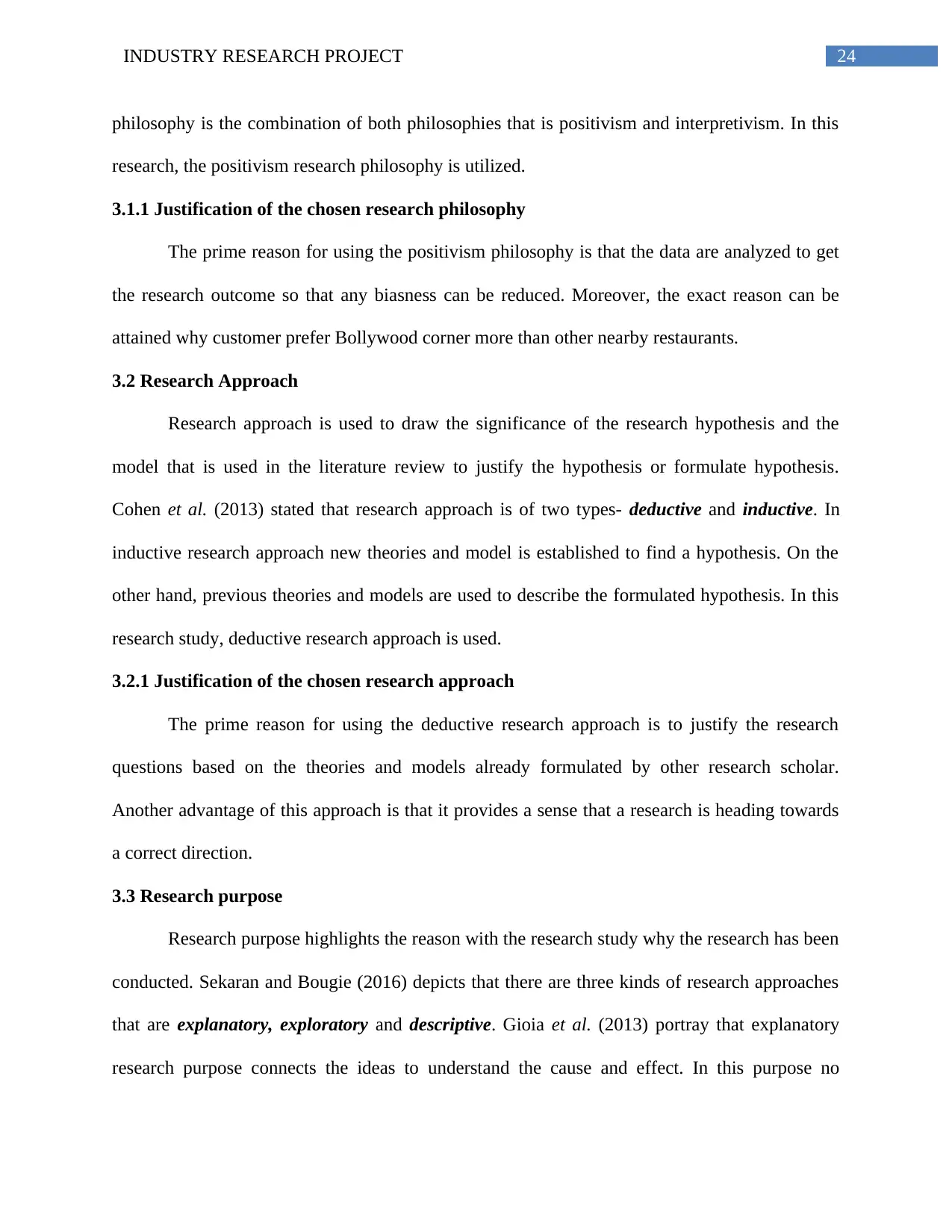
24INDUSTRY RESEARCH PROJECT
philosophy is the combination of both philosophies that is positivism and interpretivism. In this
research, the positivism research philosophy is utilized.
3.1.1 Justification of the chosen research philosophy
The prime reason for using the positivism philosophy is that the data are analyzed to get
the research outcome so that any biasness can be reduced. Moreover, the exact reason can be
attained why customer prefer Bollywood corner more than other nearby restaurants.
3.2 Research Approach
Research approach is used to draw the significance of the research hypothesis and the
model that is used in the literature review to justify the hypothesis or formulate hypothesis.
Cohen et al. (2013) stated that research approach is of two types- deductive and inductive. In
inductive research approach new theories and model is established to find a hypothesis. On the
other hand, previous theories and models are used to describe the formulated hypothesis. In this
research study, deductive research approach is used.
3.2.1 Justification of the chosen research approach
The prime reason for using the deductive research approach is to justify the research
questions based on the theories and models already formulated by other research scholar.
Another advantage of this approach is that it provides a sense that a research is heading towards
a correct direction.
3.3 Research purpose
Research purpose highlights the reason with the research study why the research has been
conducted. Sekaran and Bougie (2016) depicts that there are three kinds of research approaches
that are explanatory, exploratory and descriptive. Gioia et al. (2013) portray that explanatory
research purpose connects the ideas to understand the cause and effect. In this purpose no
philosophy is the combination of both philosophies that is positivism and interpretivism. In this
research, the positivism research philosophy is utilized.
3.1.1 Justification of the chosen research philosophy
The prime reason for using the positivism philosophy is that the data are analyzed to get
the research outcome so that any biasness can be reduced. Moreover, the exact reason can be
attained why customer prefer Bollywood corner more than other nearby restaurants.
3.2 Research Approach
Research approach is used to draw the significance of the research hypothesis and the
model that is used in the literature review to justify the hypothesis or formulate hypothesis.
Cohen et al. (2013) stated that research approach is of two types- deductive and inductive. In
inductive research approach new theories and model is established to find a hypothesis. On the
other hand, previous theories and models are used to describe the formulated hypothesis. In this
research study, deductive research approach is used.
3.2.1 Justification of the chosen research approach
The prime reason for using the deductive research approach is to justify the research
questions based on the theories and models already formulated by other research scholar.
Another advantage of this approach is that it provides a sense that a research is heading towards
a correct direction.
3.3 Research purpose
Research purpose highlights the reason with the research study why the research has been
conducted. Sekaran and Bougie (2016) depicts that there are three kinds of research approaches
that are explanatory, exploratory and descriptive. Gioia et al. (2013) portray that explanatory
research purpose connects the ideas to understand the cause and effect. In this purpose no
Paraphrase This Document
Need a fresh take? Get an instant paraphrase of this document with our AI Paraphraser
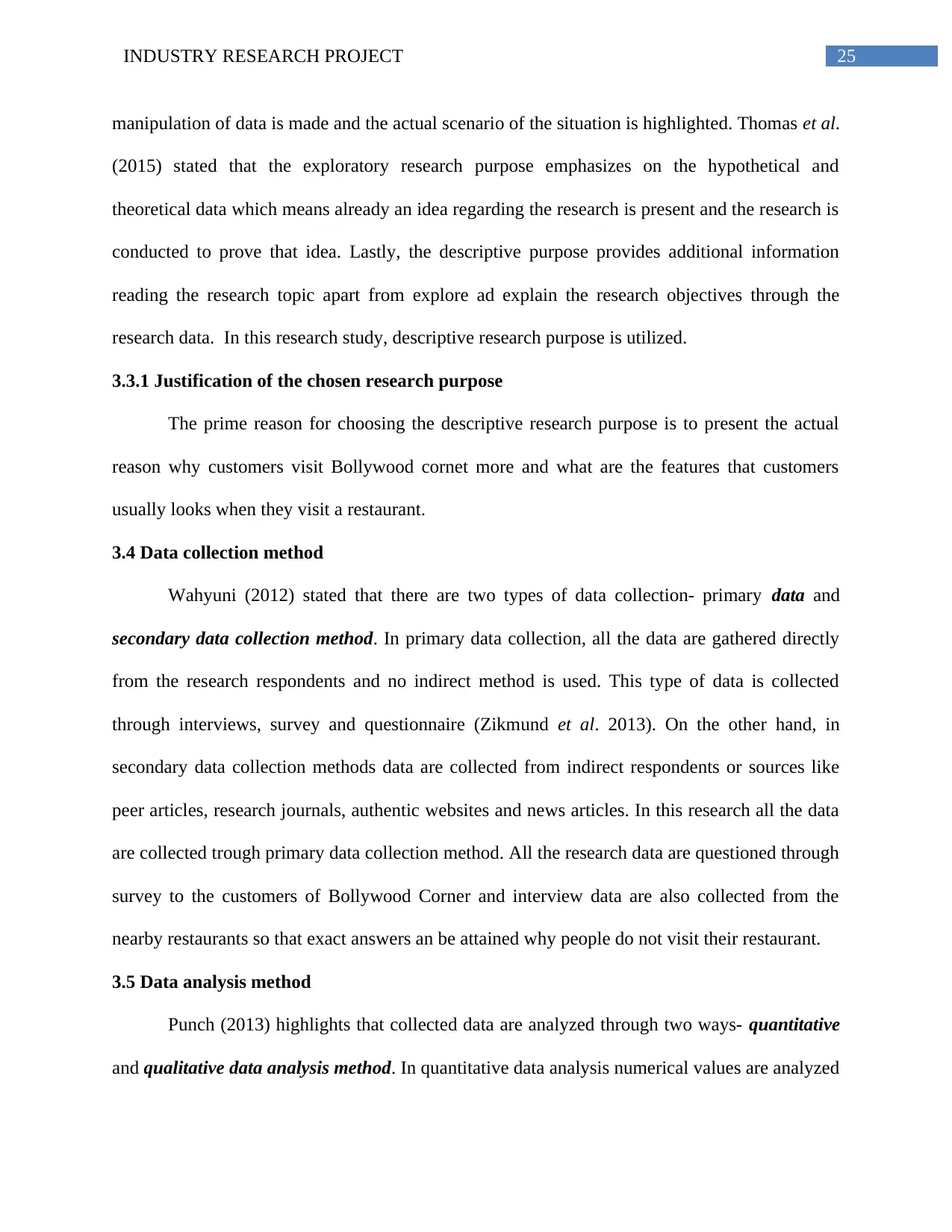
25INDUSTRY RESEARCH PROJECT
manipulation of data is made and the actual scenario of the situation is highlighted. Thomas et al.
(2015) stated that the exploratory research purpose emphasizes on the hypothetical and
theoretical data which means already an idea regarding the research is present and the research is
conducted to prove that idea. Lastly, the descriptive purpose provides additional information
reading the research topic apart from explore ad explain the research objectives through the
research data. In this research study, descriptive research purpose is utilized.
3.3.1 Justification of the chosen research purpose
The prime reason for choosing the descriptive research purpose is to present the actual
reason why customers visit Bollywood cornet more and what are the features that customers
usually looks when they visit a restaurant.
3.4 Data collection method
Wahyuni (2012) stated that there are two types of data collection- primary data and
secondary data collection method. In primary data collection, all the data are gathered directly
from the research respondents and no indirect method is used. This type of data is collected
through interviews, survey and questionnaire (Zikmund et al. 2013). On the other hand, in
secondary data collection methods data are collected from indirect respondents or sources like
peer articles, research journals, authentic websites and news articles. In this research all the data
are collected trough primary data collection method. All the research data are questioned through
survey to the customers of Bollywood Corner and interview data are also collected from the
nearby restaurants so that exact answers an be attained why people do not visit their restaurant.
3.5 Data analysis method
Punch (2013) highlights that collected data are analyzed through two ways- quantitative
and qualitative data analysis method. In quantitative data analysis numerical values are analyzed
manipulation of data is made and the actual scenario of the situation is highlighted. Thomas et al.
(2015) stated that the exploratory research purpose emphasizes on the hypothetical and
theoretical data which means already an idea regarding the research is present and the research is
conducted to prove that idea. Lastly, the descriptive purpose provides additional information
reading the research topic apart from explore ad explain the research objectives through the
research data. In this research study, descriptive research purpose is utilized.
3.3.1 Justification of the chosen research purpose
The prime reason for choosing the descriptive research purpose is to present the actual
reason why customers visit Bollywood cornet more and what are the features that customers
usually looks when they visit a restaurant.
3.4 Data collection method
Wahyuni (2012) stated that there are two types of data collection- primary data and
secondary data collection method. In primary data collection, all the data are gathered directly
from the research respondents and no indirect method is used. This type of data is collected
through interviews, survey and questionnaire (Zikmund et al. 2013). On the other hand, in
secondary data collection methods data are collected from indirect respondents or sources like
peer articles, research journals, authentic websites and news articles. In this research all the data
are collected trough primary data collection method. All the research data are questioned through
survey to the customers of Bollywood Corner and interview data are also collected from the
nearby restaurants so that exact answers an be attained why people do not visit their restaurant.
3.5 Data analysis method
Punch (2013) highlights that collected data are analyzed through two ways- quantitative
and qualitative data analysis method. In quantitative data analysis numerical values are analyzed
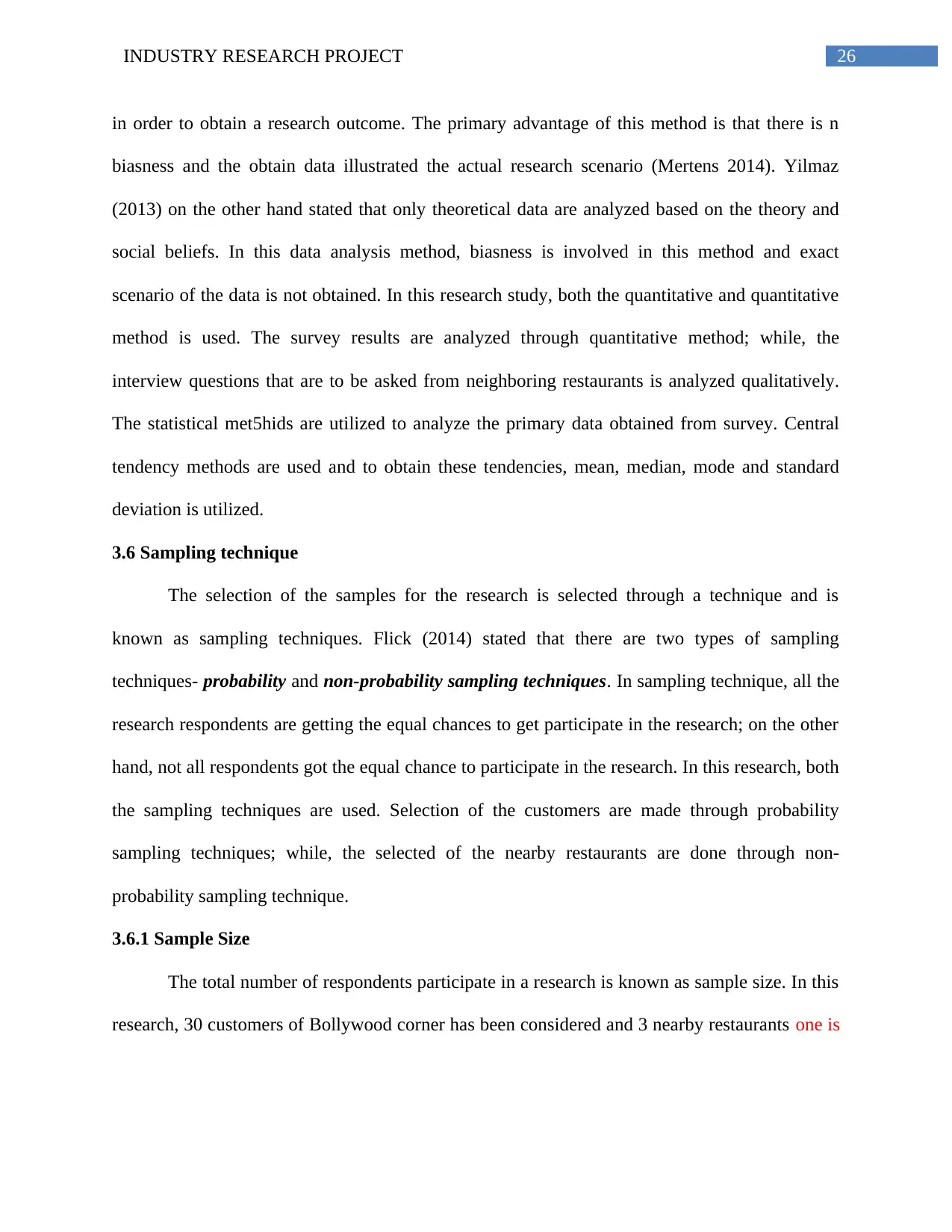
26INDUSTRY RESEARCH PROJECT
in order to obtain a research outcome. The primary advantage of this method is that there is n
biasness and the obtain data illustrated the actual research scenario (Mertens 2014). Yilmaz
(2013) on the other hand stated that only theoretical data are analyzed based on the theory and
social beliefs. In this data analysis method, biasness is involved in this method and exact
scenario of the data is not obtained. In this research study, both the quantitative and quantitative
method is used. The survey results are analyzed through quantitative method; while, the
interview questions that are to be asked from neighboring restaurants is analyzed qualitatively.
The statistical met5hids are utilized to analyze the primary data obtained from survey. Central
tendency methods are used and to obtain these tendencies, mean, median, mode and standard
deviation is utilized.
3.6 Sampling technique
The selection of the samples for the research is selected through a technique and is
known as sampling techniques. Flick (2014) stated that there are two types of sampling
techniques- probability and non-probability sampling techniques. In sampling technique, all the
research respondents are getting the equal chances to get participate in the research; on the other
hand, not all respondents got the equal chance to participate in the research. In this research, both
the sampling techniques are used. Selection of the customers are made through probability
sampling techniques; while, the selected of the nearby restaurants are done through non-
probability sampling technique.
3.6.1 Sample Size
The total number of respondents participate in a research is known as sample size. In this
research, 30 customers of Bollywood corner has been considered and 3 nearby restaurants one is
in order to obtain a research outcome. The primary advantage of this method is that there is n
biasness and the obtain data illustrated the actual research scenario (Mertens 2014). Yilmaz
(2013) on the other hand stated that only theoretical data are analyzed based on the theory and
social beliefs. In this data analysis method, biasness is involved in this method and exact
scenario of the data is not obtained. In this research study, both the quantitative and quantitative
method is used. The survey results are analyzed through quantitative method; while, the
interview questions that are to be asked from neighboring restaurants is analyzed qualitatively.
The statistical met5hids are utilized to analyze the primary data obtained from survey. Central
tendency methods are used and to obtain these tendencies, mean, median, mode and standard
deviation is utilized.
3.6 Sampling technique
The selection of the samples for the research is selected through a technique and is
known as sampling techniques. Flick (2014) stated that there are two types of sampling
techniques- probability and non-probability sampling techniques. In sampling technique, all the
research respondents are getting the equal chances to get participate in the research; on the other
hand, not all respondents got the equal chance to participate in the research. In this research, both
the sampling techniques are used. Selection of the customers are made through probability
sampling techniques; while, the selected of the nearby restaurants are done through non-
probability sampling technique.
3.6.1 Sample Size
The total number of respondents participate in a research is known as sample size. In this
research, 30 customers of Bollywood corner has been considered and 3 nearby restaurants one is

27INDUSTRY RESEARCH PROJECT
Indian restaurants, Italian restaurants and Chinese restaurant that are also questioned regarding
why customer gets more attracted towards Bollywood Corner type restaurants.
3.7 Research ethics
Neuman and Robson (2014) stated that research ethics allows top complete the research
without breaching any research procedure and adopt any unethical approaches. In this way, the
research can be accepted effectively and social authorization is also attained to accomplish the
entire research. In this research, initially all the respondents are provided with a consent form
that is duly signed from the respondents, which represents that all the participants, are willingly
participate in the research and help to obtain research data. All the research respondents are
respected and their thoughts are not influenced so as to change their options during the research.
In addition to that, not passive source is utilized to obtain the data. Moreover, non sensitive or
emotional questions are asked from the respondents. All the data are also protected under the
legislation of Data Protection Act 1998 and these data are also used only for the research
purpose and not for any other business benefits. These data after research are handed over to the
univer5sity and in case, publications of respondents data will necessary in future, it will be done
by taking their permission otherwise anonymousness is maintain3ed throughout the research.
3.8 Research Limitation
The research suffers from the limitation of time and financial resources. In addition to
that, all the data are taken from a small size of sample that is 30. Better result can be attained if
more respondents can be selected. Additionally, only the primary data has been collected in this
research and no secondary data is utilized. Furthermore, only one organization hat is Bollywood
Corner is taken into consideration and thus the research outcome specifically highlights the
Indian restaurants, Italian restaurants and Chinese restaurant that are also questioned regarding
why customer gets more attracted towards Bollywood Corner type restaurants.
3.7 Research ethics
Neuman and Robson (2014) stated that research ethics allows top complete the research
without breaching any research procedure and adopt any unethical approaches. In this way, the
research can be accepted effectively and social authorization is also attained to accomplish the
entire research. In this research, initially all the respondents are provided with a consent form
that is duly signed from the respondents, which represents that all the participants, are willingly
participate in the research and help to obtain research data. All the research respondents are
respected and their thoughts are not influenced so as to change their options during the research.
In addition to that, not passive source is utilized to obtain the data. Moreover, non sensitive or
emotional questions are asked from the respondents. All the data are also protected under the
legislation of Data Protection Act 1998 and these data are also used only for the research
purpose and not for any other business benefits. These data after research are handed over to the
univer5sity and in case, publications of respondents data will necessary in future, it will be done
by taking their permission otherwise anonymousness is maintain3ed throughout the research.
3.8 Research Limitation
The research suffers from the limitation of time and financial resources. In addition to
that, all the data are taken from a small size of sample that is 30. Better result can be attained if
more respondents can be selected. Additionally, only the primary data has been collected in this
research and no secondary data is utilized. Furthermore, only one organization hat is Bollywood
Corner is taken into consideration and thus the research outcome specifically highlights the
Secure Best Marks with AI Grader
Need help grading? Try our AI Grader for instant feedback on your assignments.
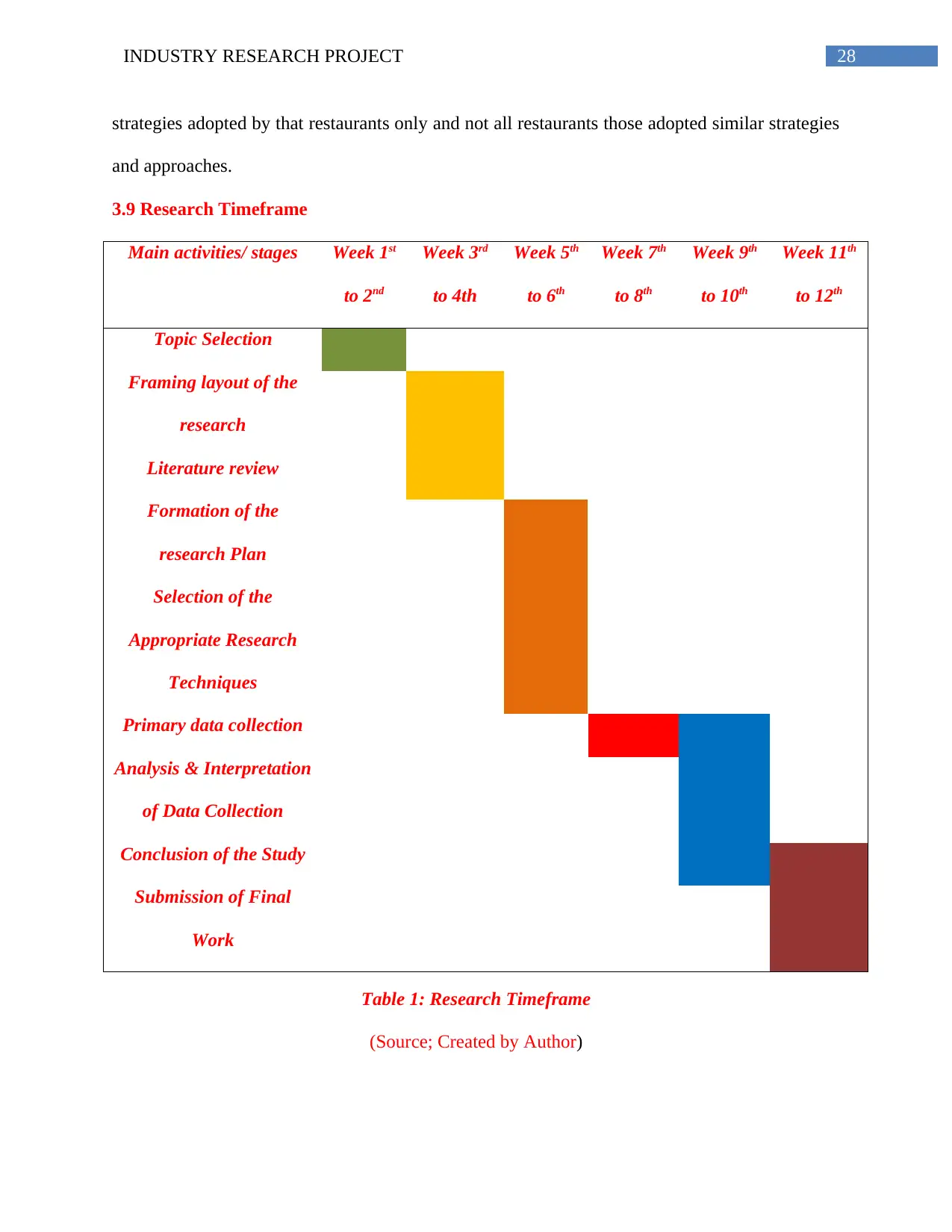
28INDUSTRY RESEARCH PROJECT
strategies adopted by that restaurants only and not all restaurants those adopted similar strategies
and approaches.
3.9 Research Timeframe
Main activities/ stages Week 1st
to 2nd
Week 3rd
to 4th
Week 5th
to 6th
Week 7th
to 8th
Week 9th
to 10th
Week 11th
to 12th
Topic Selection
Framing layout of the
research
Literature review
Formation of the
research Plan
Selection of the
Appropriate Research
Techniques
Primary data collection
Analysis & Interpretation
of Data Collection
Conclusion of the Study
Submission of Final
Work
Table 1: Research Timeframe
(Source; Created by Author)
strategies adopted by that restaurants only and not all restaurants those adopted similar strategies
and approaches.
3.9 Research Timeframe
Main activities/ stages Week 1st
to 2nd
Week 3rd
to 4th
Week 5th
to 6th
Week 7th
to 8th
Week 9th
to 10th
Week 11th
to 12th
Topic Selection
Framing layout of the
research
Literature review
Formation of the
research Plan
Selection of the
Appropriate Research
Techniques
Primary data collection
Analysis & Interpretation
of Data Collection
Conclusion of the Study
Submission of Final
Work
Table 1: Research Timeframe
(Source; Created by Author)
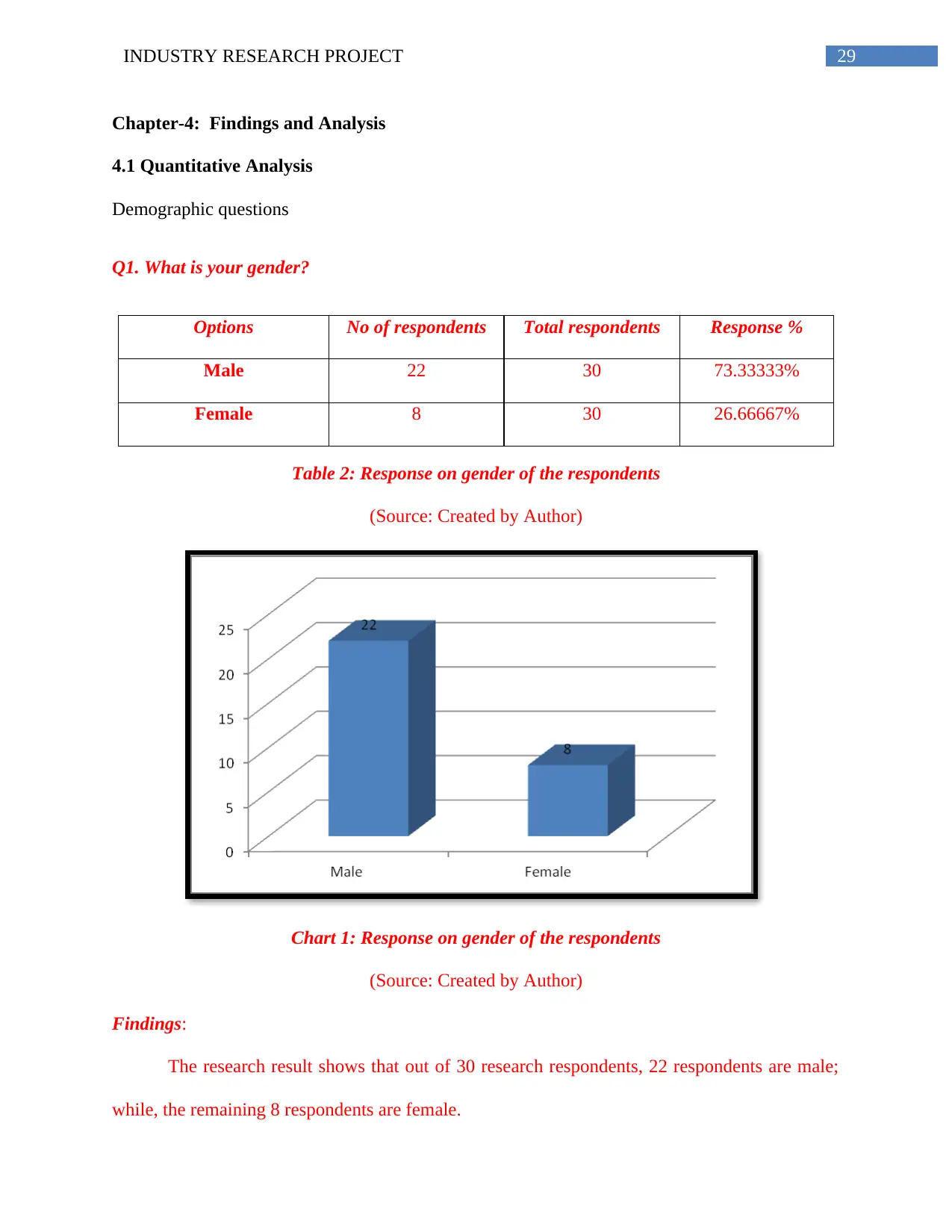
29INDUSTRY RESEARCH PROJECT
Chapter-4: Findings and Analysis
4.1 Quantitative Analysis
Demographic questions
Q1. What is your gender?
Options No of respondents Total respondents Response %
Male 22 30 73.33333%
Female 8 30 26.66667%
Table 2: Response on gender of the respondents
(Source: Created by Author)
Chart 1: Response on gender of the respondents
(Source: Created by Author)
Findings:
The research result shows that out of 30 research respondents, 22 respondents are male;
while, the remaining 8 respondents are female.
Chapter-4: Findings and Analysis
4.1 Quantitative Analysis
Demographic questions
Q1. What is your gender?
Options No of respondents Total respondents Response %
Male 22 30 73.33333%
Female 8 30 26.66667%
Table 2: Response on gender of the respondents
(Source: Created by Author)
Chart 1: Response on gender of the respondents
(Source: Created by Author)
Findings:
The research result shows that out of 30 research respondents, 22 respondents are male;
while, the remaining 8 respondents are female.
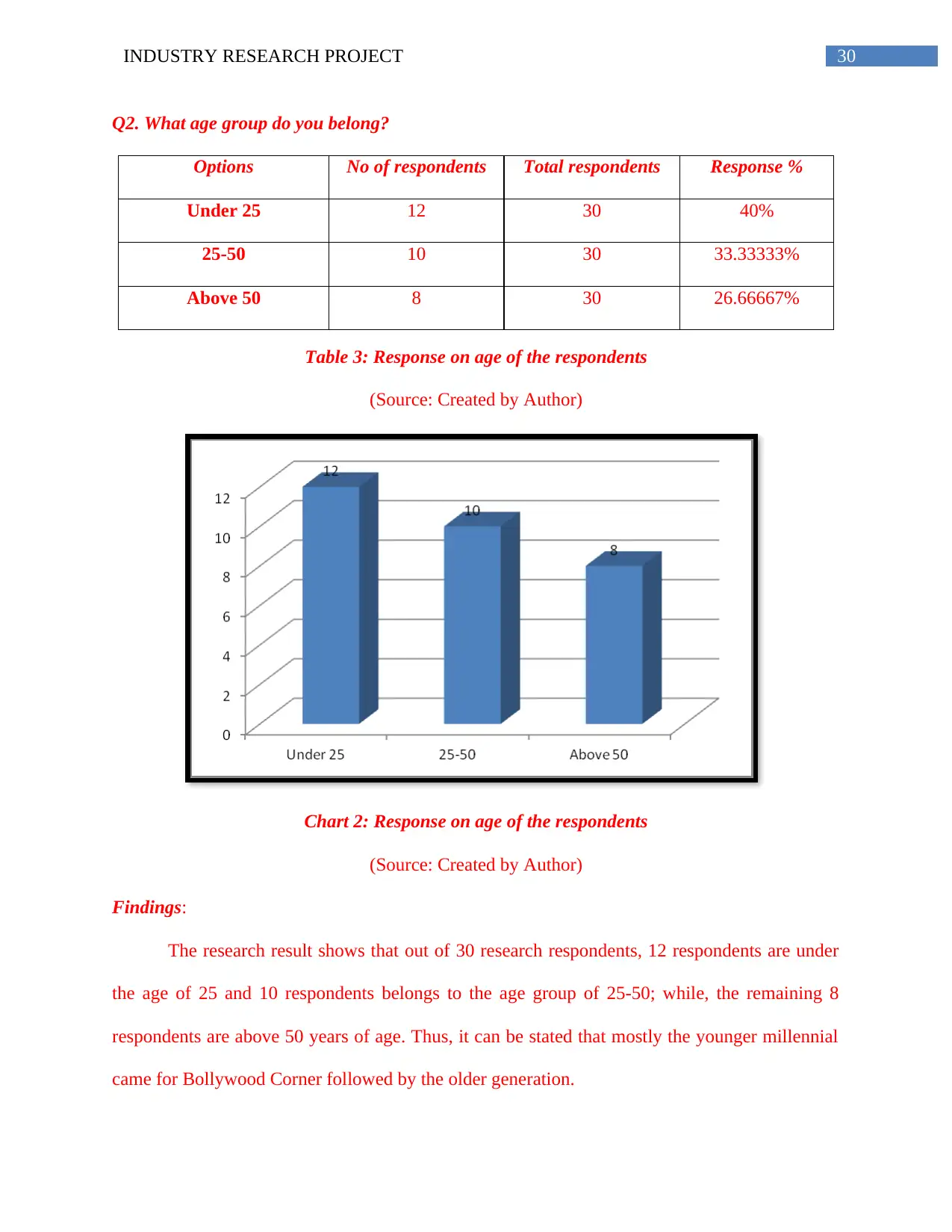
30INDUSTRY RESEARCH PROJECT
Q2. What age group do you belong?
Options No of respondents Total respondents Response %
Under 25 12 30 40%
25-50 10 30 33.33333%
Above 50 8 30 26.66667%
Table 3: Response on age of the respondents
(Source: Created by Author)
Chart 2: Response on age of the respondents
(Source: Created by Author)
Findings:
The research result shows that out of 30 research respondents, 12 respondents are under
the age of 25 and 10 respondents belongs to the age group of 25-50; while, the remaining 8
respondents are above 50 years of age. Thus, it can be stated that mostly the younger millennial
came for Bollywood Corner followed by the older generation.
Q2. What age group do you belong?
Options No of respondents Total respondents Response %
Under 25 12 30 40%
25-50 10 30 33.33333%
Above 50 8 30 26.66667%
Table 3: Response on age of the respondents
(Source: Created by Author)
Chart 2: Response on age of the respondents
(Source: Created by Author)
Findings:
The research result shows that out of 30 research respondents, 12 respondents are under
the age of 25 and 10 respondents belongs to the age group of 25-50; while, the remaining 8
respondents are above 50 years of age. Thus, it can be stated that mostly the younger millennial
came for Bollywood Corner followed by the older generation.
Paraphrase This Document
Need a fresh take? Get an instant paraphrase of this document with our AI Paraphraser
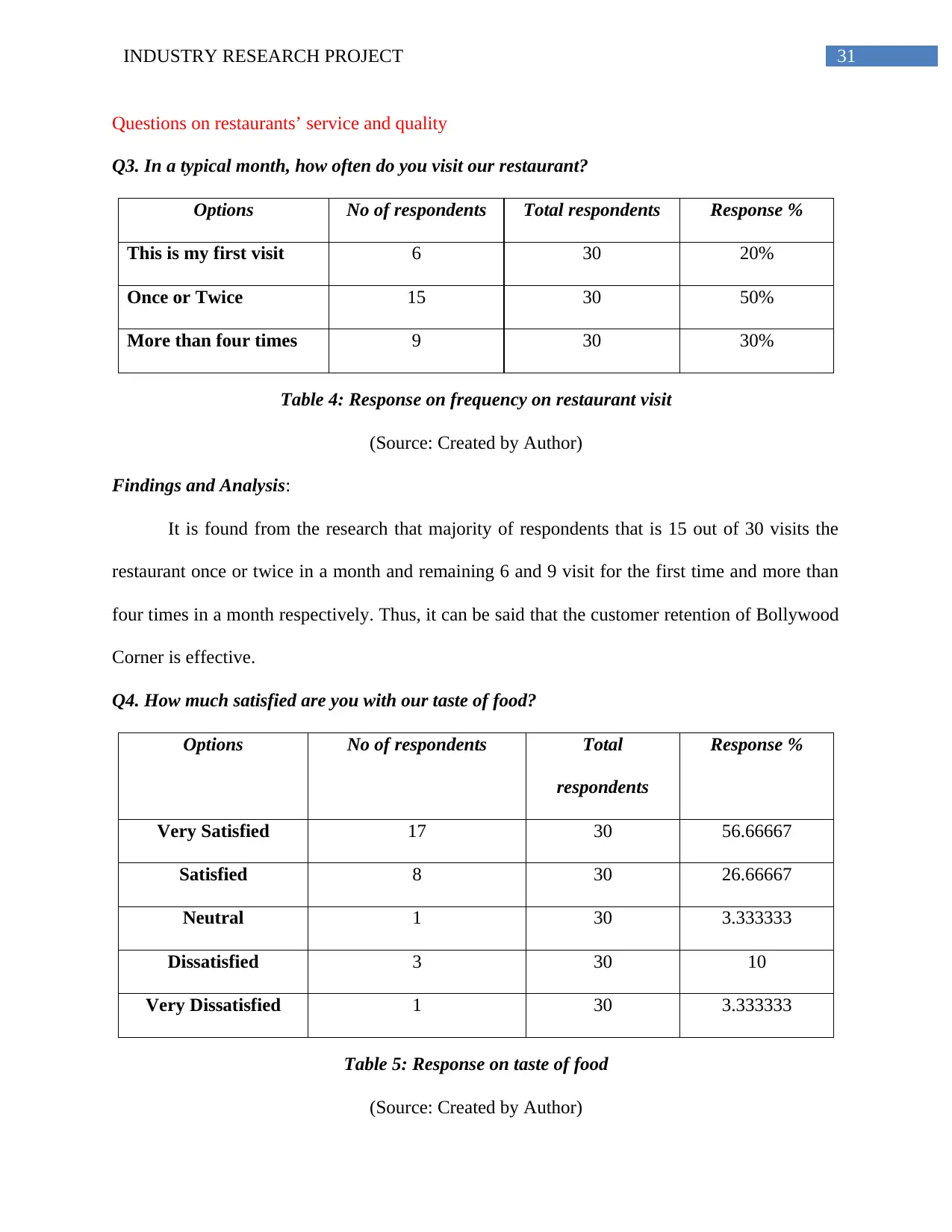
31INDUSTRY RESEARCH PROJECT
Questions on restaurants’ service and quality
Q3. In a typical month, how often do you visit our restaurant?
Options No of respondents Total respondents Response %
This is my first visit 6 30 20%
Once or Twice 15 30 50%
More than four times 9 30 30%
Table 4: Response on frequency on restaurant visit
(Source: Created by Author)
Findings and Analysis:
It is found from the research that majority of respondents that is 15 out of 30 visits the
restaurant once or twice in a month and remaining 6 and 9 visit for the first time and more than
four times in a month respectively. Thus, it can be said that the customer retention of Bollywood
Corner is effective.
Q4. How much satisfied are you with our taste of food?
Options No of respondents Total
respondents
Response %
Very Satisfied 17 30 56.66667
Satisfied 8 30 26.66667
Neutral 1 30 3.333333
Dissatisfied 3 30 10
Very Dissatisfied 1 30 3.333333
Table 5: Response on taste of food
(Source: Created by Author)
Questions on restaurants’ service and quality
Q3. In a typical month, how often do you visit our restaurant?
Options No of respondents Total respondents Response %
This is my first visit 6 30 20%
Once or Twice 15 30 50%
More than four times 9 30 30%
Table 4: Response on frequency on restaurant visit
(Source: Created by Author)
Findings and Analysis:
It is found from the research that majority of respondents that is 15 out of 30 visits the
restaurant once or twice in a month and remaining 6 and 9 visit for the first time and more than
four times in a month respectively. Thus, it can be said that the customer retention of Bollywood
Corner is effective.
Q4. How much satisfied are you with our taste of food?
Options No of respondents Total
respondents
Response %
Very Satisfied 17 30 56.66667
Satisfied 8 30 26.66667
Neutral 1 30 3.333333
Dissatisfied 3 30 10
Very Dissatisfied 1 30 3.333333
Table 5: Response on taste of food
(Source: Created by Author)
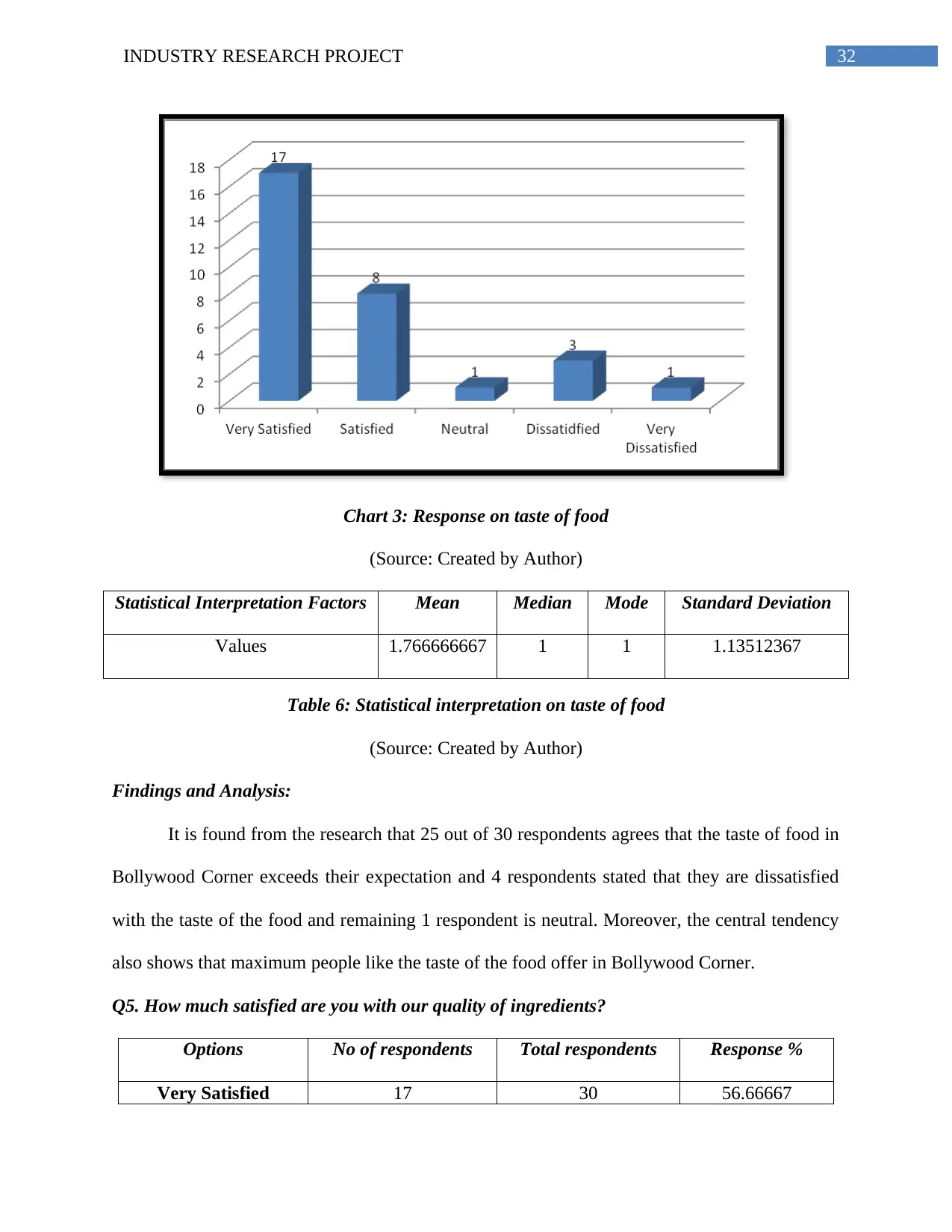
32INDUSTRY RESEARCH PROJECT
Chart 3: Response on taste of food
(Source: Created by Author)
Statistical Interpretation Factors Mean Median Mode Standard Deviation
Values 1.766666667 1 1 1.13512367
Table 6: Statistical interpretation on taste of food
(Source: Created by Author)
Findings and Analysis:
It is found from the research that 25 out of 30 respondents agrees that the taste of food in
Bollywood Corner exceeds their expectation and 4 respondents stated that they are dissatisfied
with the taste of the food and remaining 1 respondent is neutral. Moreover, the central tendency
also shows that maximum people like the taste of the food offer in Bollywood Corner.
Q5. How much satisfied are you with our quality of ingredients?
Options No of respondents Total respondents Response %
Very Satisfied 17 30 56.66667
Chart 3: Response on taste of food
(Source: Created by Author)
Statistical Interpretation Factors Mean Median Mode Standard Deviation
Values 1.766666667 1 1 1.13512367
Table 6: Statistical interpretation on taste of food
(Source: Created by Author)
Findings and Analysis:
It is found from the research that 25 out of 30 respondents agrees that the taste of food in
Bollywood Corner exceeds their expectation and 4 respondents stated that they are dissatisfied
with the taste of the food and remaining 1 respondent is neutral. Moreover, the central tendency
also shows that maximum people like the taste of the food offer in Bollywood Corner.
Q5. How much satisfied are you with our quality of ingredients?
Options No of respondents Total respondents Response %
Very Satisfied 17 30 56.66667
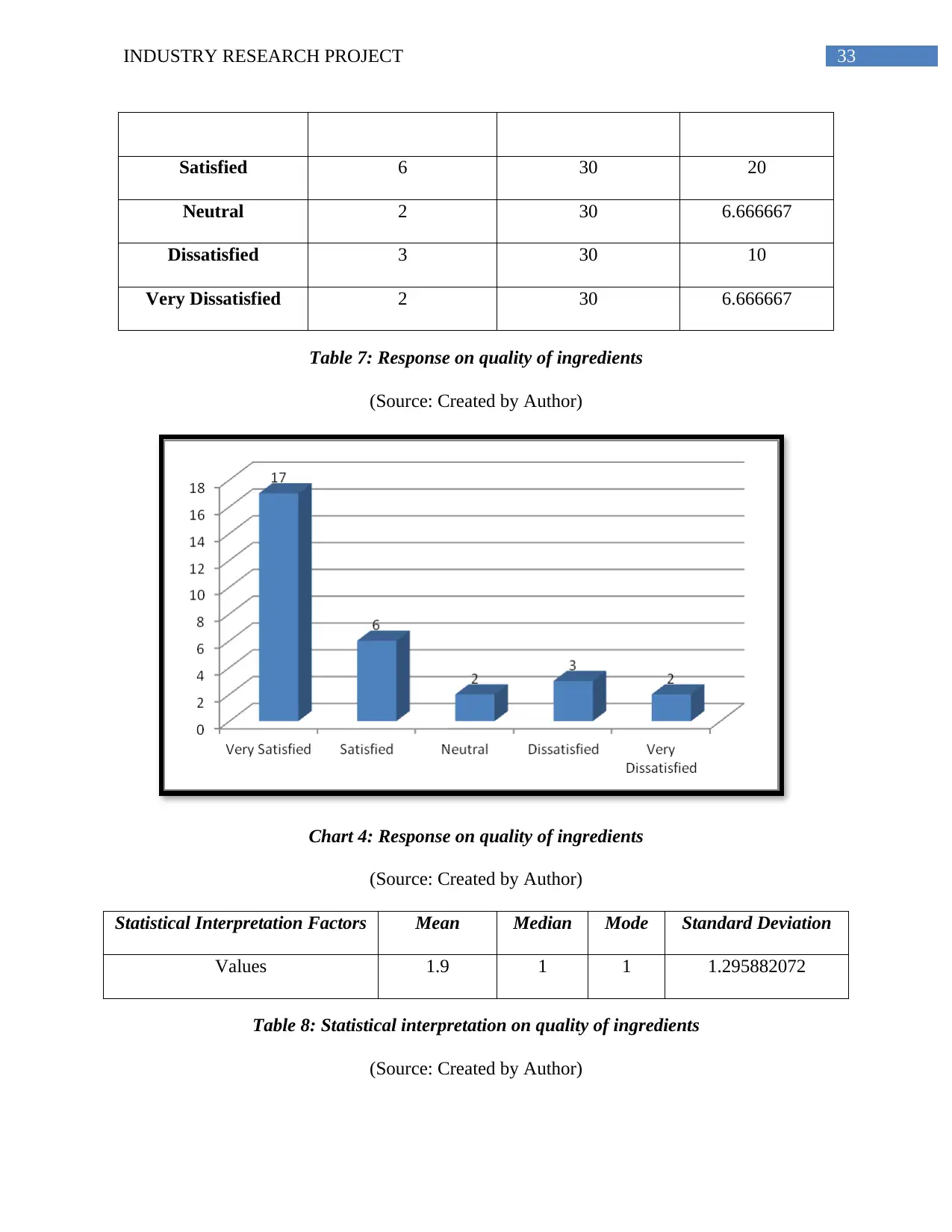
33INDUSTRY RESEARCH PROJECT
Satisfied 6 30 20
Neutral 2 30 6.666667
Dissatisfied 3 30 10
Very Dissatisfied 2 30 6.666667
Table 7: Response on quality of ingredients
(Source: Created by Author)
Chart 4: Response on quality of ingredients
(Source: Created by Author)
Statistical Interpretation Factors Mean Median Mode Standard Deviation
Values 1.9 1 1 1.295882072
Table 8: Statistical interpretation on quality of ingredients
(Source: Created by Author)
Satisfied 6 30 20
Neutral 2 30 6.666667
Dissatisfied 3 30 10
Very Dissatisfied 2 30 6.666667
Table 7: Response on quality of ingredients
(Source: Created by Author)
Chart 4: Response on quality of ingredients
(Source: Created by Author)
Statistical Interpretation Factors Mean Median Mode Standard Deviation
Values 1.9 1 1 1.295882072
Table 8: Statistical interpretation on quality of ingredients
(Source: Created by Author)
Secure Best Marks with AI Grader
Need help grading? Try our AI Grader for instant feedback on your assignments.
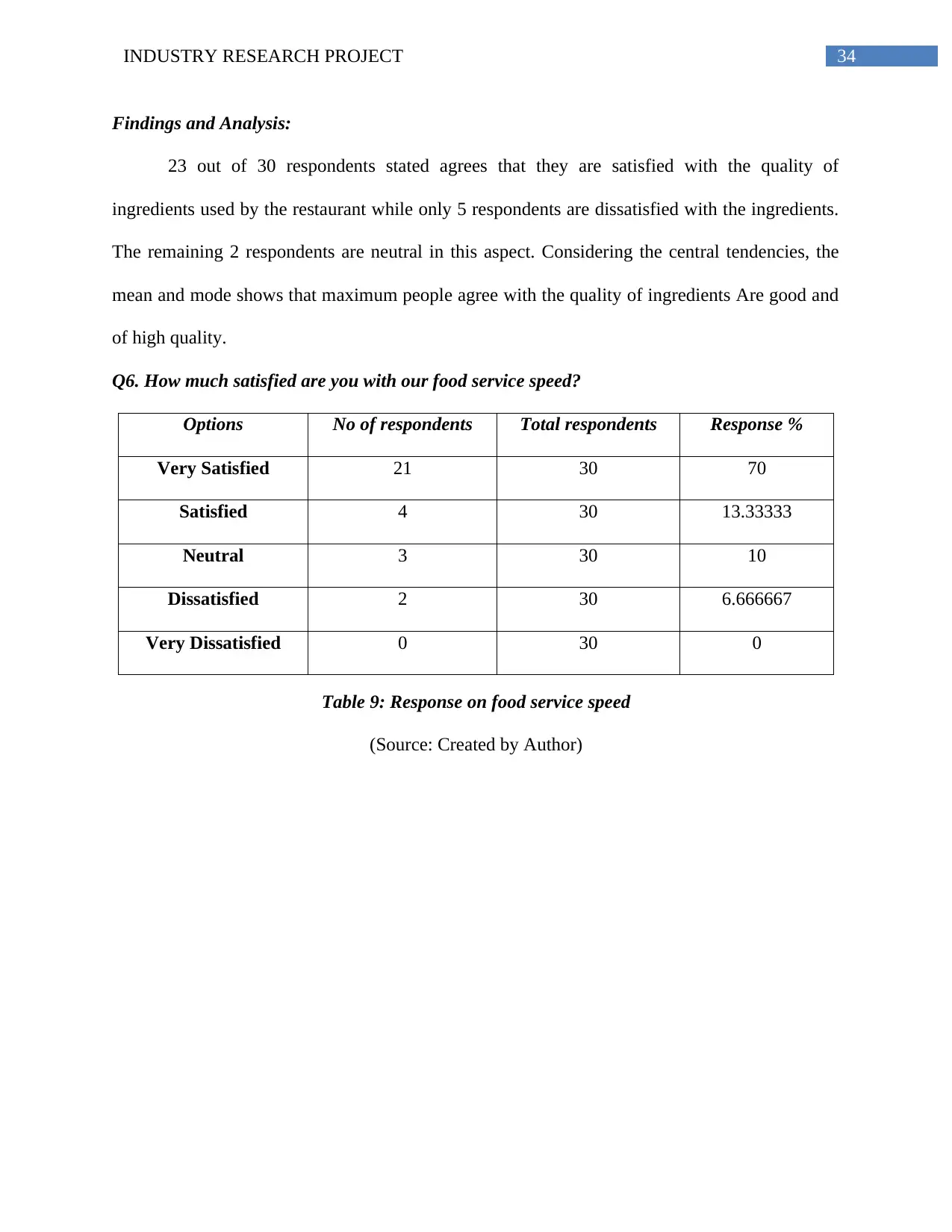
34INDUSTRY RESEARCH PROJECT
Findings and Analysis:
23 out of 30 respondents stated agrees that they are satisfied with the quality of
ingredients used by the restaurant while only 5 respondents are dissatisfied with the ingredients.
The remaining 2 respondents are neutral in this aspect. Considering the central tendencies, the
mean and mode shows that maximum people agree with the quality of ingredients Are good and
of high quality.
Q6. How much satisfied are you with our food service speed?
Options No of respondents Total respondents Response %
Very Satisfied 21 30 70
Satisfied 4 30 13.33333
Neutral 3 30 10
Dissatisfied 2 30 6.666667
Very Dissatisfied 0 30 0
Table 9: Response on food service speed
(Source: Created by Author)
Findings and Analysis:
23 out of 30 respondents stated agrees that they are satisfied with the quality of
ingredients used by the restaurant while only 5 respondents are dissatisfied with the ingredients.
The remaining 2 respondents are neutral in this aspect. Considering the central tendencies, the
mean and mode shows that maximum people agree with the quality of ingredients Are good and
of high quality.
Q6. How much satisfied are you with our food service speed?
Options No of respondents Total respondents Response %
Very Satisfied 21 30 70
Satisfied 4 30 13.33333
Neutral 3 30 10
Dissatisfied 2 30 6.666667
Very Dissatisfied 0 30 0
Table 9: Response on food service speed
(Source: Created by Author)
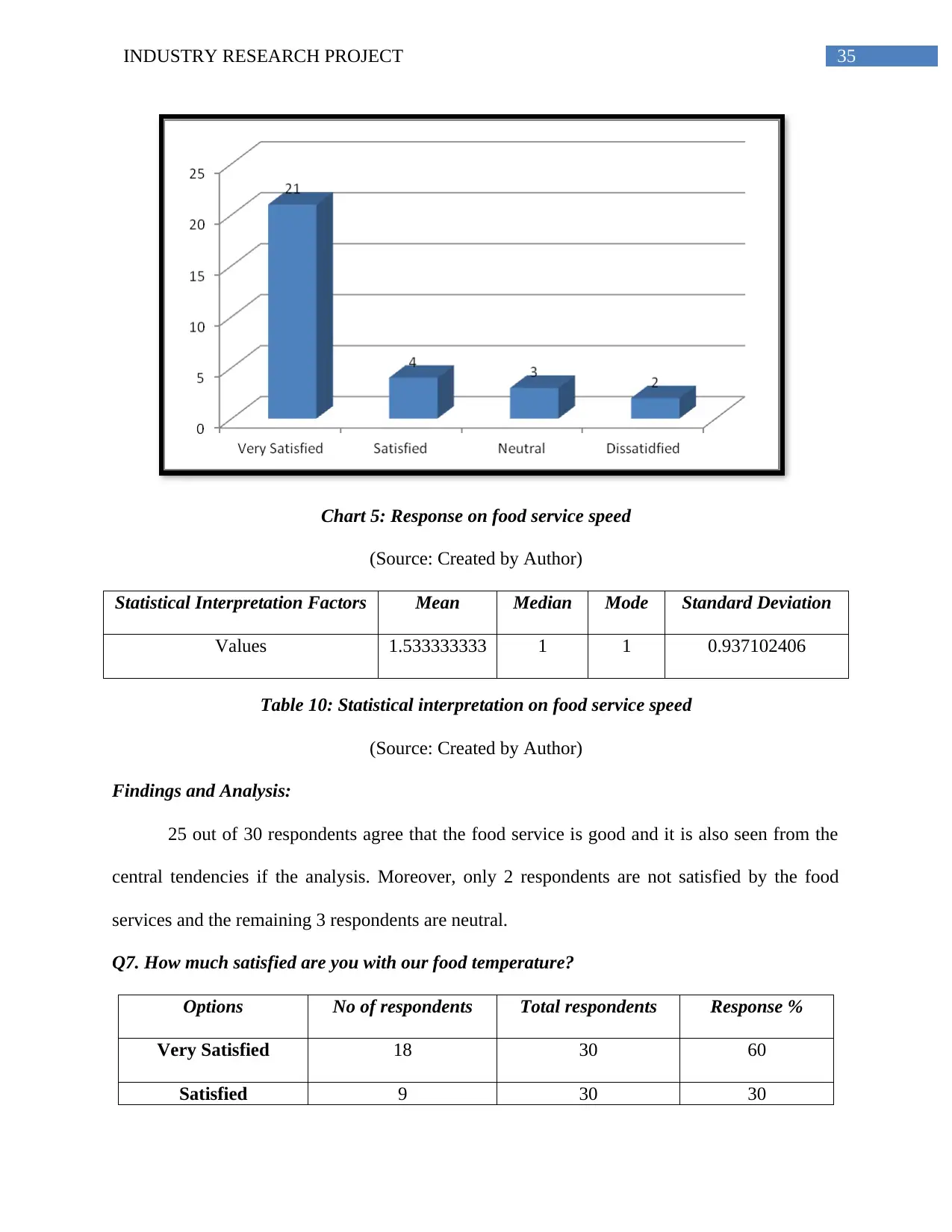
35INDUSTRY RESEARCH PROJECT
Chart 5: Response on food service speed
(Source: Created by Author)
Statistical Interpretation Factors Mean Median Mode Standard Deviation
Values 1.533333333 1 1 0.937102406
Table 10: Statistical interpretation on food service speed
(Source: Created by Author)
Findings and Analysis:
25 out of 30 respondents agree that the food service is good and it is also seen from the
central tendencies if the analysis. Moreover, only 2 respondents are not satisfied by the food
services and the remaining 3 respondents are neutral.
Q7. How much satisfied are you with our food temperature?
Options No of respondents Total respondents Response %
Very Satisfied 18 30 60
Satisfied 9 30 30
Chart 5: Response on food service speed
(Source: Created by Author)
Statistical Interpretation Factors Mean Median Mode Standard Deviation
Values 1.533333333 1 1 0.937102406
Table 10: Statistical interpretation on food service speed
(Source: Created by Author)
Findings and Analysis:
25 out of 30 respondents agree that the food service is good and it is also seen from the
central tendencies if the analysis. Moreover, only 2 respondents are not satisfied by the food
services and the remaining 3 respondents are neutral.
Q7. How much satisfied are you with our food temperature?
Options No of respondents Total respondents Response %
Very Satisfied 18 30 60
Satisfied 9 30 30
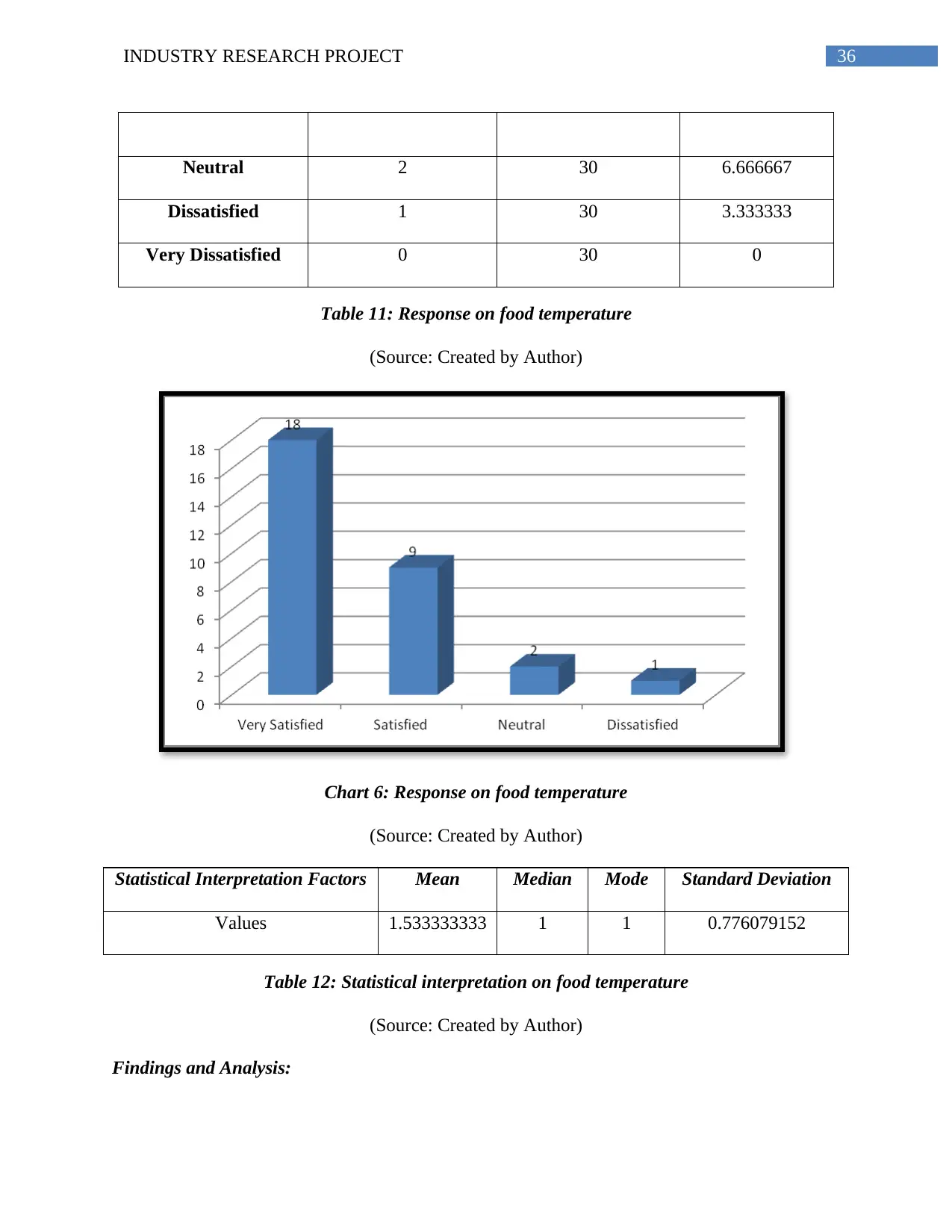
36INDUSTRY RESEARCH PROJECT
Neutral 2 30 6.666667
Dissatisfied 1 30 3.333333
Very Dissatisfied 0 30 0
Table 11: Response on food temperature
(Source: Created by Author)
Chart 6: Response on food temperature
(Source: Created by Author)
Statistical Interpretation Factors Mean Median Mode Standard Deviation
Values 1.533333333 1 1 0.776079152
Table 12: Statistical interpretation on food temperature
(Source: Created by Author)
Findings and Analysis:
Neutral 2 30 6.666667
Dissatisfied 1 30 3.333333
Very Dissatisfied 0 30 0
Table 11: Response on food temperature
(Source: Created by Author)
Chart 6: Response on food temperature
(Source: Created by Author)
Statistical Interpretation Factors Mean Median Mode Standard Deviation
Values 1.533333333 1 1 0.776079152
Table 12: Statistical interpretation on food temperature
(Source: Created by Author)
Findings and Analysis:
Paraphrase This Document
Need a fresh take? Get an instant paraphrase of this document with our AI Paraphraser
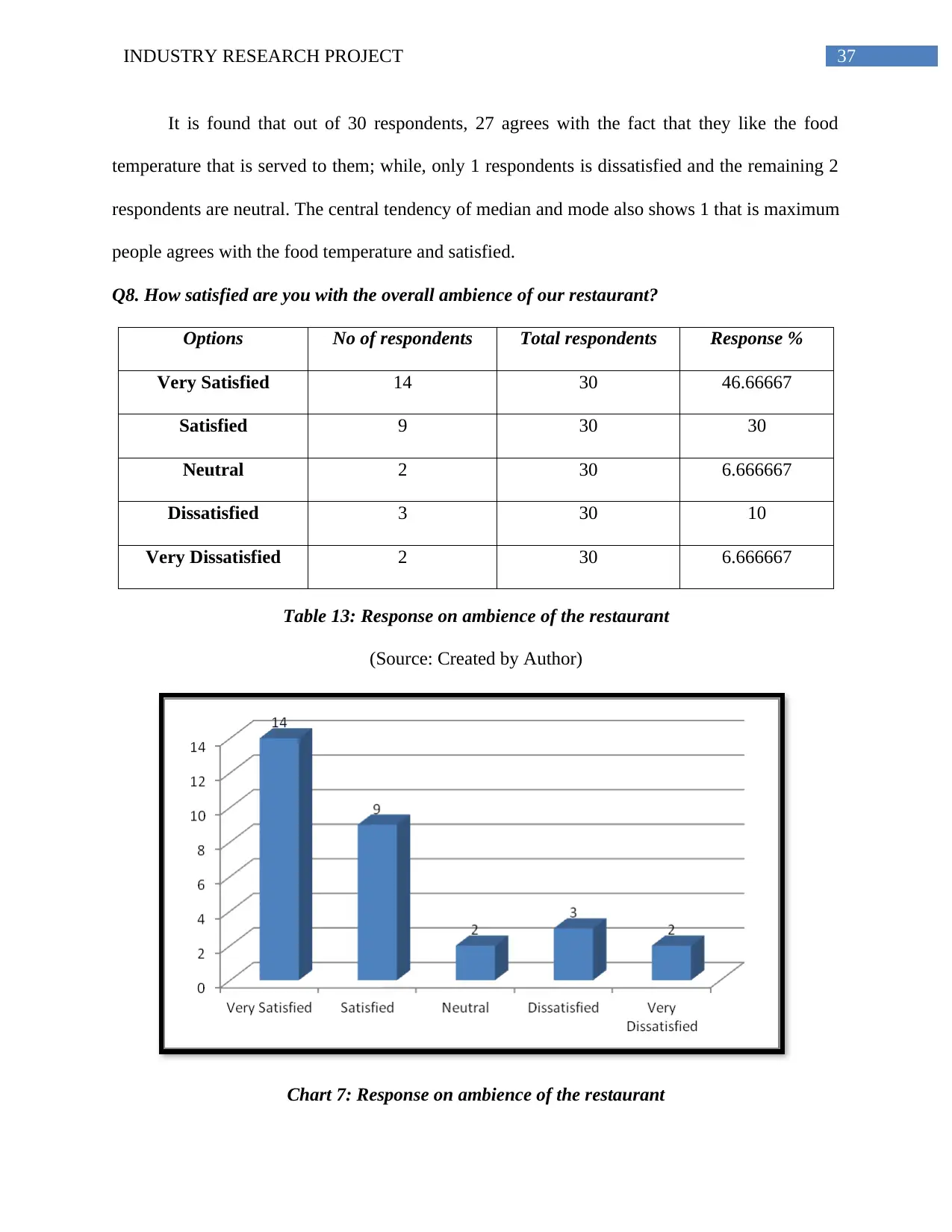
37INDUSTRY RESEARCH PROJECT
It is found that out of 30 respondents, 27 agrees with the fact that they like the food
temperature that is served to them; while, only 1 respondents is dissatisfied and the remaining 2
respondents are neutral. The central tendency of median and mode also shows 1 that is maximum
people agrees with the food temperature and satisfied.
Q8. How satisfied are you with the overall ambience of our restaurant?
Options No of respondents Total respondents Response %
Very Satisfied 14 30 46.66667
Satisfied 9 30 30
Neutral 2 30 6.666667
Dissatisfied 3 30 10
Very Dissatisfied 2 30 6.666667
Table 13: Response on ambience of the restaurant
(Source: Created by Author)
Chart 7: Response on ambience of the restaurant
It is found that out of 30 respondents, 27 agrees with the fact that they like the food
temperature that is served to them; while, only 1 respondents is dissatisfied and the remaining 2
respondents are neutral. The central tendency of median and mode also shows 1 that is maximum
people agrees with the food temperature and satisfied.
Q8. How satisfied are you with the overall ambience of our restaurant?
Options No of respondents Total respondents Response %
Very Satisfied 14 30 46.66667
Satisfied 9 30 30
Neutral 2 30 6.666667
Dissatisfied 3 30 10
Very Dissatisfied 2 30 6.666667
Table 13: Response on ambience of the restaurant
(Source: Created by Author)
Chart 7: Response on ambience of the restaurant
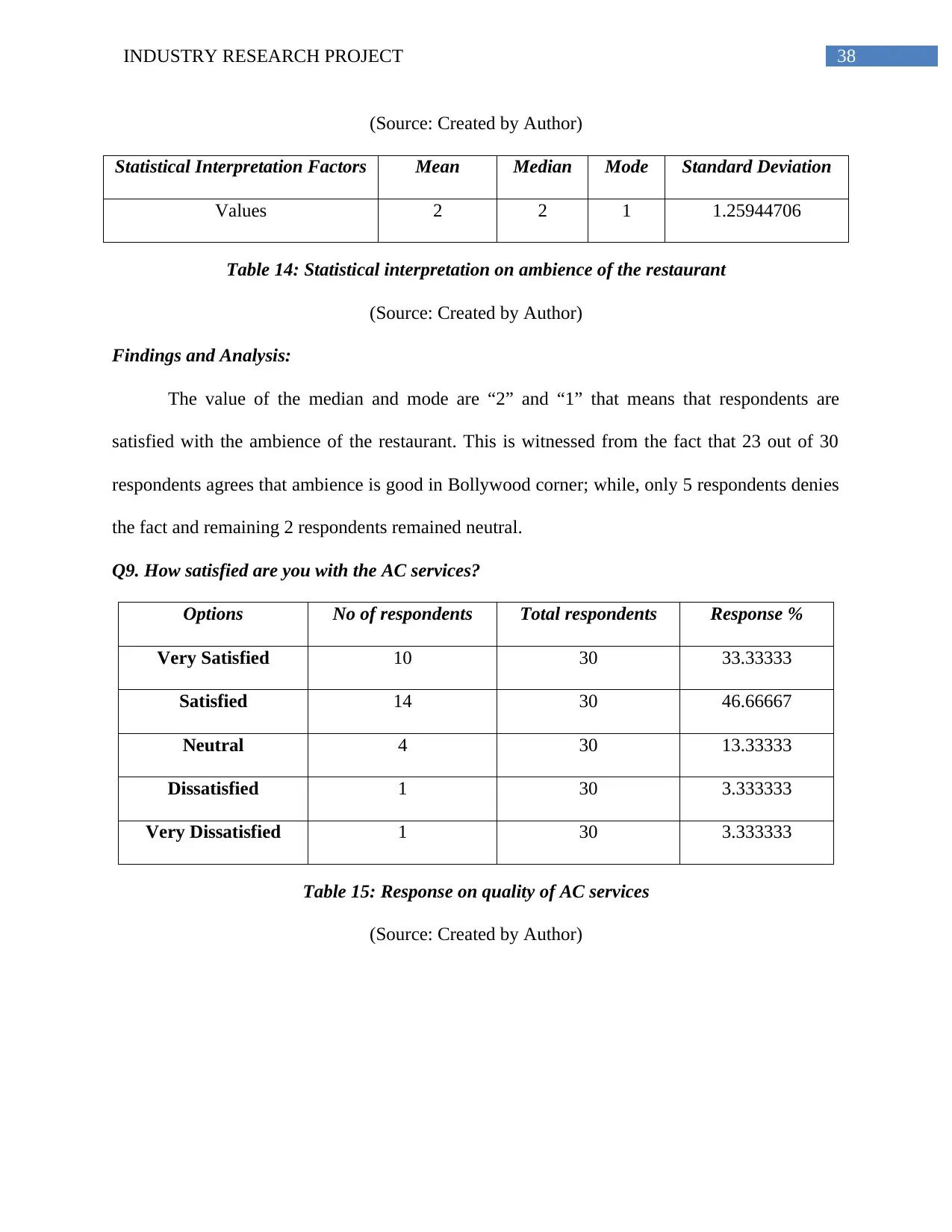
38INDUSTRY RESEARCH PROJECT
(Source: Created by Author)
Statistical Interpretation Factors Mean Median Mode Standard Deviation
Values 2 2 1 1.25944706
Table 14: Statistical interpretation on ambience of the restaurant
(Source: Created by Author)
Findings and Analysis:
The value of the median and mode are “2” and “1” that means that respondents are
satisfied with the ambience of the restaurant. This is witnessed from the fact that 23 out of 30
respondents agrees that ambience is good in Bollywood corner; while, only 5 respondents denies
the fact and remaining 2 respondents remained neutral.
Q9. How satisfied are you with the AC services?
Options No of respondents Total respondents Response %
Very Satisfied 10 30 33.33333
Satisfied 14 30 46.66667
Neutral 4 30 13.33333
Dissatisfied 1 30 3.333333
Very Dissatisfied 1 30 3.333333
Table 15: Response on quality of AC services
(Source: Created by Author)
(Source: Created by Author)
Statistical Interpretation Factors Mean Median Mode Standard Deviation
Values 2 2 1 1.25944706
Table 14: Statistical interpretation on ambience of the restaurant
(Source: Created by Author)
Findings and Analysis:
The value of the median and mode are “2” and “1” that means that respondents are
satisfied with the ambience of the restaurant. This is witnessed from the fact that 23 out of 30
respondents agrees that ambience is good in Bollywood corner; while, only 5 respondents denies
the fact and remaining 2 respondents remained neutral.
Q9. How satisfied are you with the AC services?
Options No of respondents Total respondents Response %
Very Satisfied 10 30 33.33333
Satisfied 14 30 46.66667
Neutral 4 30 13.33333
Dissatisfied 1 30 3.333333
Very Dissatisfied 1 30 3.333333
Table 15: Response on quality of AC services
(Source: Created by Author)
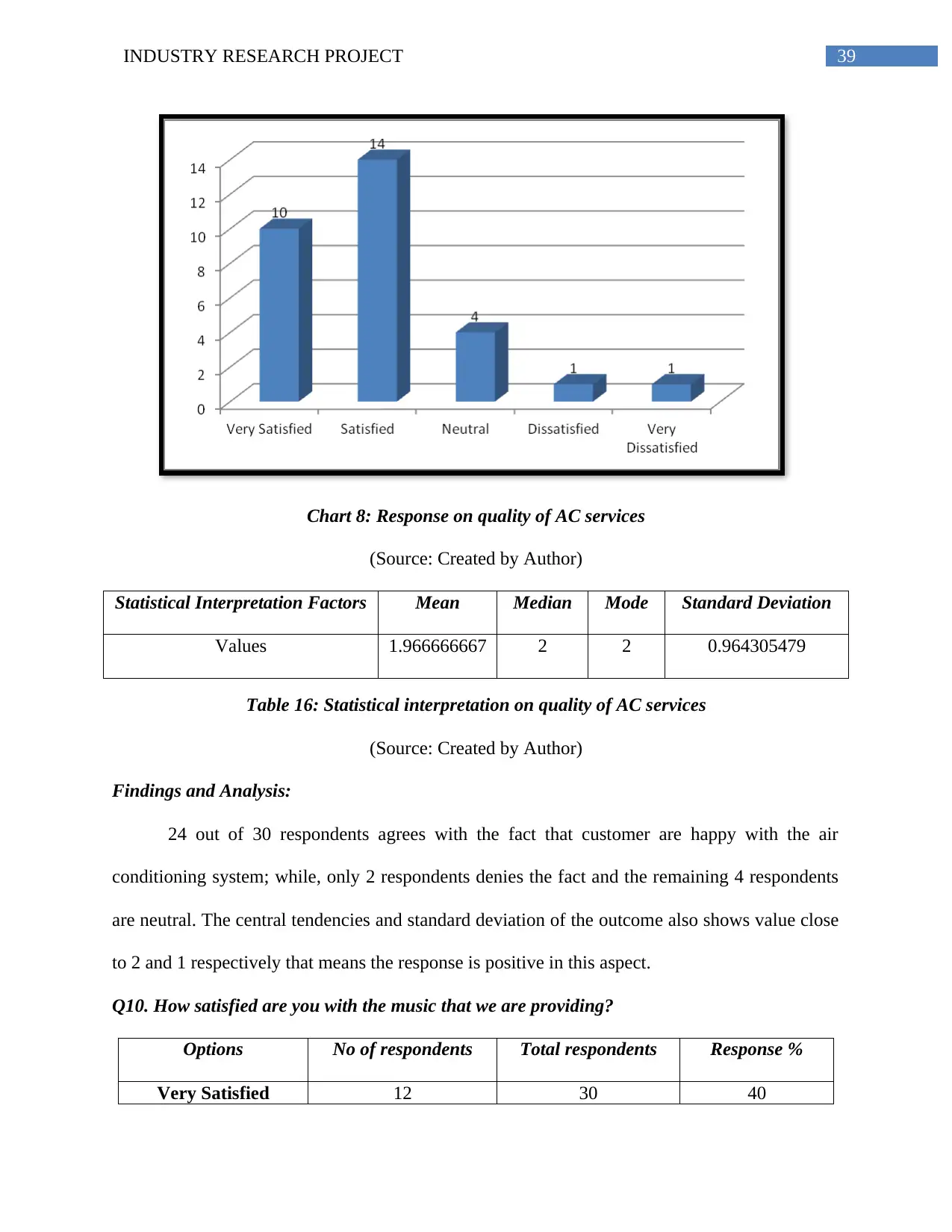
39INDUSTRY RESEARCH PROJECT
Chart 8: Response on quality of AC services
(Source: Created by Author)
Statistical Interpretation Factors Mean Median Mode Standard Deviation
Values 1.966666667 2 2 0.964305479
Table 16: Statistical interpretation on quality of AC services
(Source: Created by Author)
Findings and Analysis:
24 out of 30 respondents agrees with the fact that customer are happy with the air
conditioning system; while, only 2 respondents denies the fact and the remaining 4 respondents
are neutral. The central tendencies and standard deviation of the outcome also shows value close
to 2 and 1 respectively that means the response is positive in this aspect.
Q10. How satisfied are you with the music that we are providing?
Options No of respondents Total respondents Response %
Very Satisfied 12 30 40
Chart 8: Response on quality of AC services
(Source: Created by Author)
Statistical Interpretation Factors Mean Median Mode Standard Deviation
Values 1.966666667 2 2 0.964305479
Table 16: Statistical interpretation on quality of AC services
(Source: Created by Author)
Findings and Analysis:
24 out of 30 respondents agrees with the fact that customer are happy with the air
conditioning system; while, only 2 respondents denies the fact and the remaining 4 respondents
are neutral. The central tendencies and standard deviation of the outcome also shows value close
to 2 and 1 respectively that means the response is positive in this aspect.
Q10. How satisfied are you with the music that we are providing?
Options No of respondents Total respondents Response %
Very Satisfied 12 30 40
Secure Best Marks with AI Grader
Need help grading? Try our AI Grader for instant feedback on your assignments.
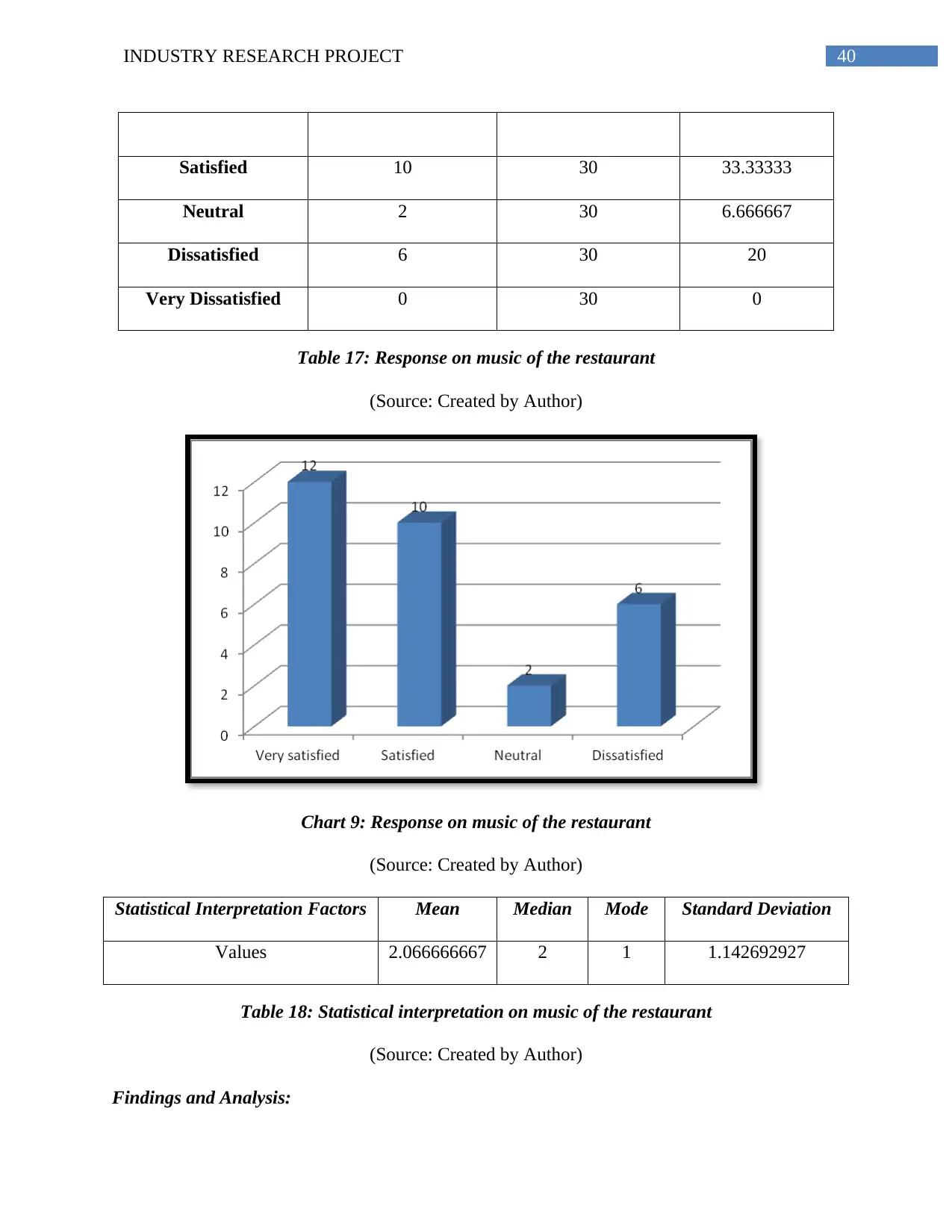
40INDUSTRY RESEARCH PROJECT
Satisfied 10 30 33.33333
Neutral 2 30 6.666667
Dissatisfied 6 30 20
Very Dissatisfied 0 30 0
Table 17: Response on music of the restaurant
(Source: Created by Author)
Chart 9: Response on music of the restaurant
(Source: Created by Author)
Statistical Interpretation Factors Mean Median Mode Standard Deviation
Values 2.066666667 2 1 1.142692927
Table 18: Statistical interpretation on music of the restaurant
(Source: Created by Author)
Findings and Analysis:
Satisfied 10 30 33.33333
Neutral 2 30 6.666667
Dissatisfied 6 30 20
Very Dissatisfied 0 30 0
Table 17: Response on music of the restaurant
(Source: Created by Author)
Chart 9: Response on music of the restaurant
(Source: Created by Author)
Statistical Interpretation Factors Mean Median Mode Standard Deviation
Values 2.066666667 2 1 1.142692927
Table 18: Statistical interpretation on music of the restaurant
(Source: Created by Author)
Findings and Analysis:
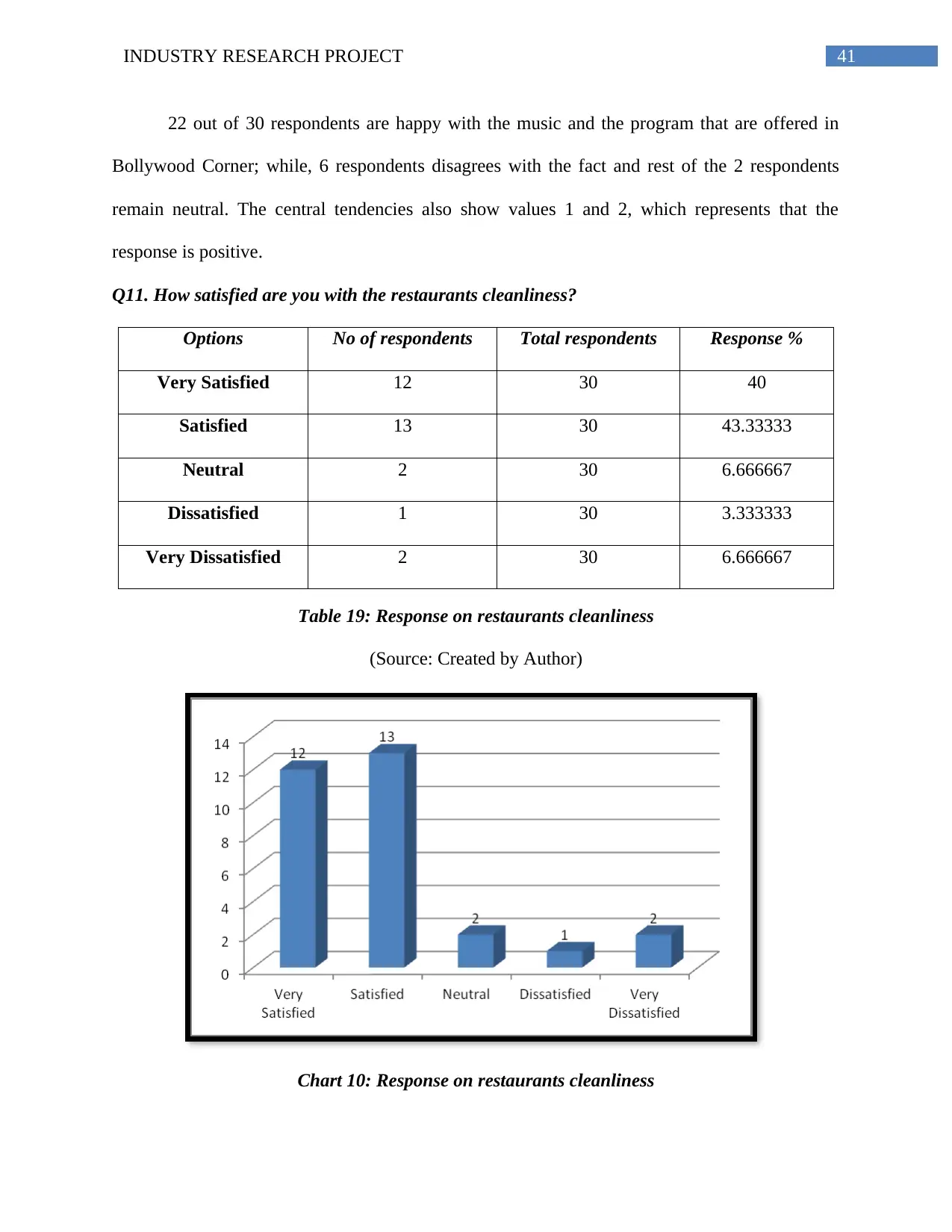
41INDUSTRY RESEARCH PROJECT
22 out of 30 respondents are happy with the music and the program that are offered in
Bollywood Corner; while, 6 respondents disagrees with the fact and rest of the 2 respondents
remain neutral. The central tendencies also show values 1 and 2, which represents that the
response is positive.
Q11. How satisfied are you with the restaurants cleanliness?
Options No of respondents Total respondents Response %
Very Satisfied 12 30 40
Satisfied 13 30 43.33333
Neutral 2 30 6.666667
Dissatisfied 1 30 3.333333
Very Dissatisfied 2 30 6.666667
Table 19: Response on restaurants cleanliness
(Source: Created by Author)
Chart 10: Response on restaurants cleanliness
22 out of 30 respondents are happy with the music and the program that are offered in
Bollywood Corner; while, 6 respondents disagrees with the fact and rest of the 2 respondents
remain neutral. The central tendencies also show values 1 and 2, which represents that the
response is positive.
Q11. How satisfied are you with the restaurants cleanliness?
Options No of respondents Total respondents Response %
Very Satisfied 12 30 40
Satisfied 13 30 43.33333
Neutral 2 30 6.666667
Dissatisfied 1 30 3.333333
Very Dissatisfied 2 30 6.666667
Table 19: Response on restaurants cleanliness
(Source: Created by Author)
Chart 10: Response on restaurants cleanliness
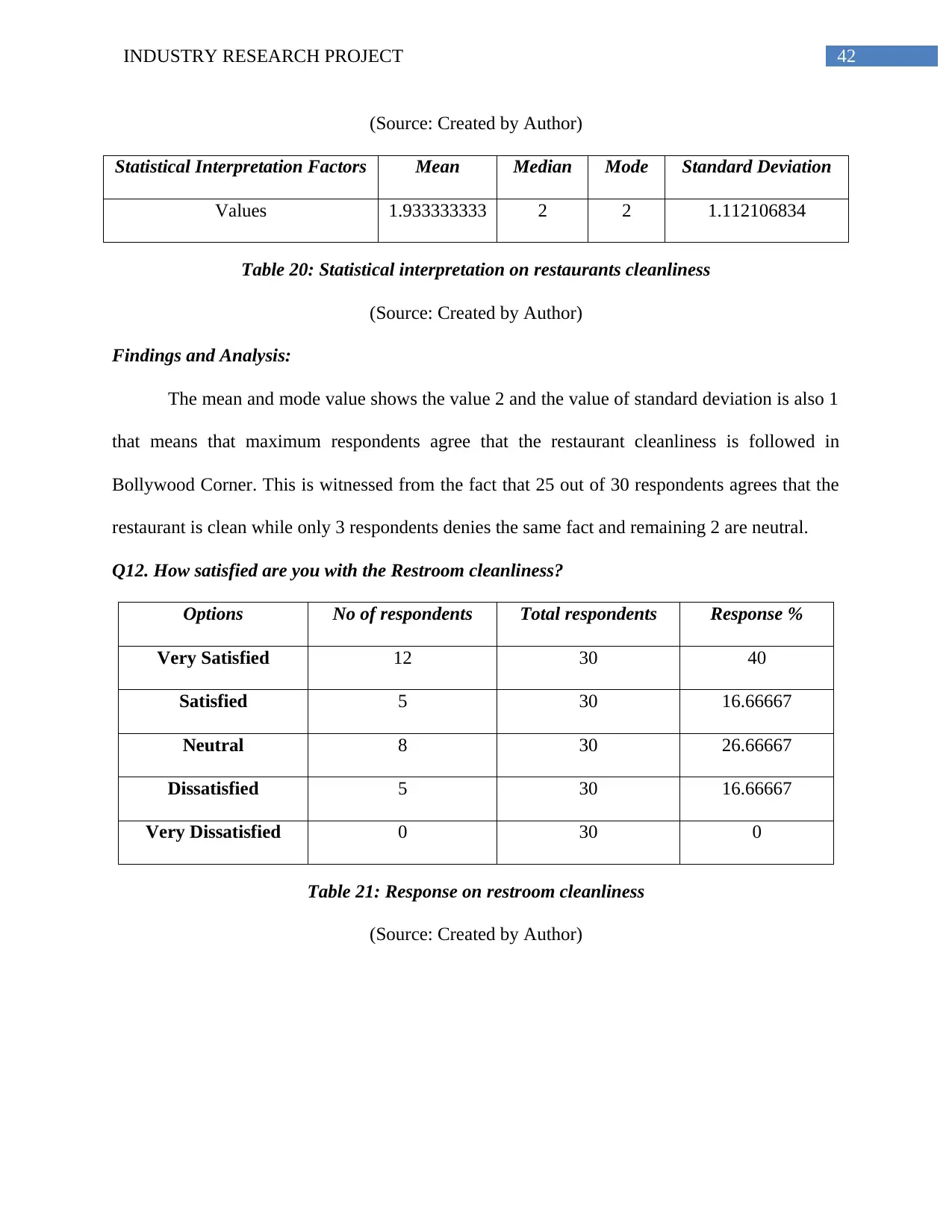
42INDUSTRY RESEARCH PROJECT
(Source: Created by Author)
Statistical Interpretation Factors Mean Median Mode Standard Deviation
Values 1.933333333 2 2 1.112106834
Table 20: Statistical interpretation on restaurants cleanliness
(Source: Created by Author)
Findings and Analysis:
The mean and mode value shows the value 2 and the value of standard deviation is also 1
that means that maximum respondents agree that the restaurant cleanliness is followed in
Bollywood Corner. This is witnessed from the fact that 25 out of 30 respondents agrees that the
restaurant is clean while only 3 respondents denies the same fact and remaining 2 are neutral.
Q12. How satisfied are you with the Restroom cleanliness?
Options No of respondents Total respondents Response %
Very Satisfied 12 30 40
Satisfied 5 30 16.66667
Neutral 8 30 26.66667
Dissatisfied 5 30 16.66667
Very Dissatisfied 0 30 0
Table 21: Response on restroom cleanliness
(Source: Created by Author)
(Source: Created by Author)
Statistical Interpretation Factors Mean Median Mode Standard Deviation
Values 1.933333333 2 2 1.112106834
Table 20: Statistical interpretation on restaurants cleanliness
(Source: Created by Author)
Findings and Analysis:
The mean and mode value shows the value 2 and the value of standard deviation is also 1
that means that maximum respondents agree that the restaurant cleanliness is followed in
Bollywood Corner. This is witnessed from the fact that 25 out of 30 respondents agrees that the
restaurant is clean while only 3 respondents denies the same fact and remaining 2 are neutral.
Q12. How satisfied are you with the Restroom cleanliness?
Options No of respondents Total respondents Response %
Very Satisfied 12 30 40
Satisfied 5 30 16.66667
Neutral 8 30 26.66667
Dissatisfied 5 30 16.66667
Very Dissatisfied 0 30 0
Table 21: Response on restroom cleanliness
(Source: Created by Author)
Paraphrase This Document
Need a fresh take? Get an instant paraphrase of this document with our AI Paraphraser
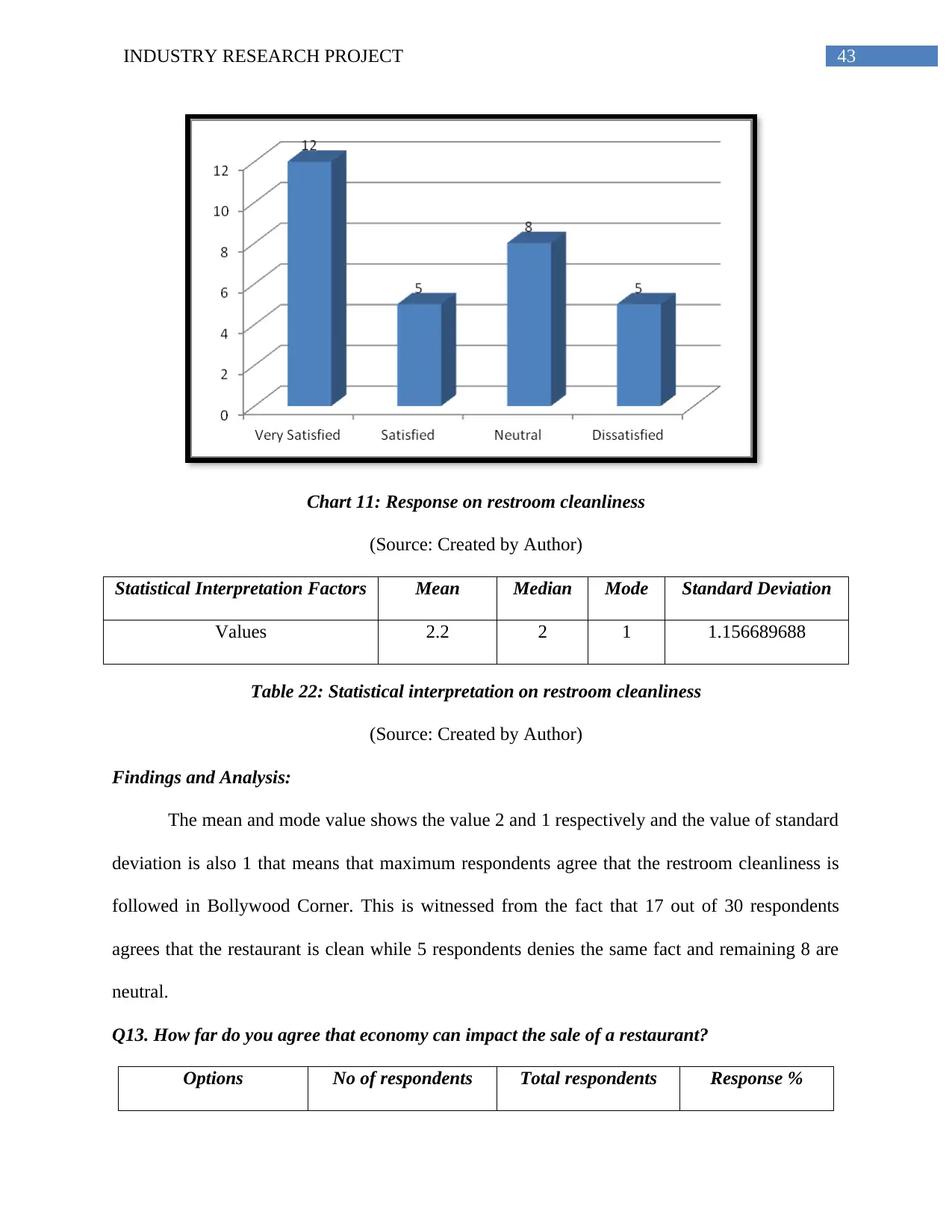
43INDUSTRY RESEARCH PROJECT
Chart 11: Response on restroom cleanliness
(Source: Created by Author)
Statistical Interpretation Factors Mean Median Mode Standard Deviation
Values 2.2 2 1 1.156689688
Table 22: Statistical interpretation on restroom cleanliness
(Source: Created by Author)
Findings and Analysis:
The mean and mode value shows the value 2 and 1 respectively and the value of standard
deviation is also 1 that means that maximum respondents agree that the restroom cleanliness is
followed in Bollywood Corner. This is witnessed from the fact that 17 out of 30 respondents
agrees that the restaurant is clean while 5 respondents denies the same fact and remaining 8 are
neutral.
Q13. How far do you agree that economy can impact the sale of a restaurant?
Options No of respondents Total respondents Response %
Chart 11: Response on restroom cleanliness
(Source: Created by Author)
Statistical Interpretation Factors Mean Median Mode Standard Deviation
Values 2.2 2 1 1.156689688
Table 22: Statistical interpretation on restroom cleanliness
(Source: Created by Author)
Findings and Analysis:
The mean and mode value shows the value 2 and 1 respectively and the value of standard
deviation is also 1 that means that maximum respondents agree that the restroom cleanliness is
followed in Bollywood Corner. This is witnessed from the fact that 17 out of 30 respondents
agrees that the restaurant is clean while 5 respondents denies the same fact and remaining 8 are
neutral.
Q13. How far do you agree that economy can impact the sale of a restaurant?
Options No of respondents Total respondents Response %
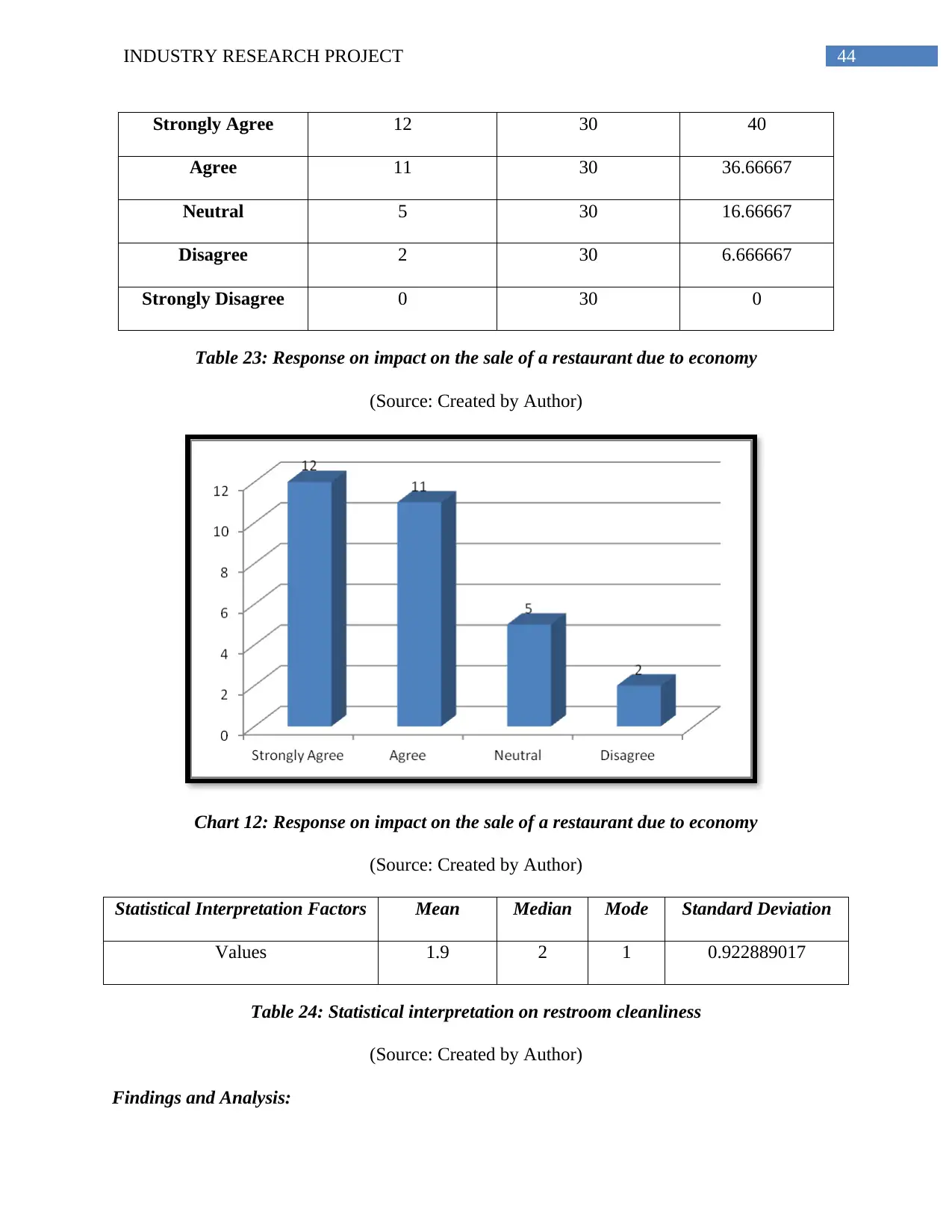
44INDUSTRY RESEARCH PROJECT
Strongly Agree 12 30 40
Agree 11 30 36.66667
Neutral 5 30 16.66667
Disagree 2 30 6.666667
Strongly Disagree 0 30 0
Table 23: Response on impact on the sale of a restaurant due to economy
(Source: Created by Author)
Chart 12: Response on impact on the sale of a restaurant due to economy
(Source: Created by Author)
Statistical Interpretation Factors Mean Median Mode Standard Deviation
Values 1.9 2 1 0.922889017
Table 24: Statistical interpretation on restroom cleanliness
(Source: Created by Author)
Findings and Analysis:
Strongly Agree 12 30 40
Agree 11 30 36.66667
Neutral 5 30 16.66667
Disagree 2 30 6.666667
Strongly Disagree 0 30 0
Table 23: Response on impact on the sale of a restaurant due to economy
(Source: Created by Author)
Chart 12: Response on impact on the sale of a restaurant due to economy
(Source: Created by Author)
Statistical Interpretation Factors Mean Median Mode Standard Deviation
Values 1.9 2 1 0.922889017
Table 24: Statistical interpretation on restroom cleanliness
(Source: Created by Author)
Findings and Analysis:
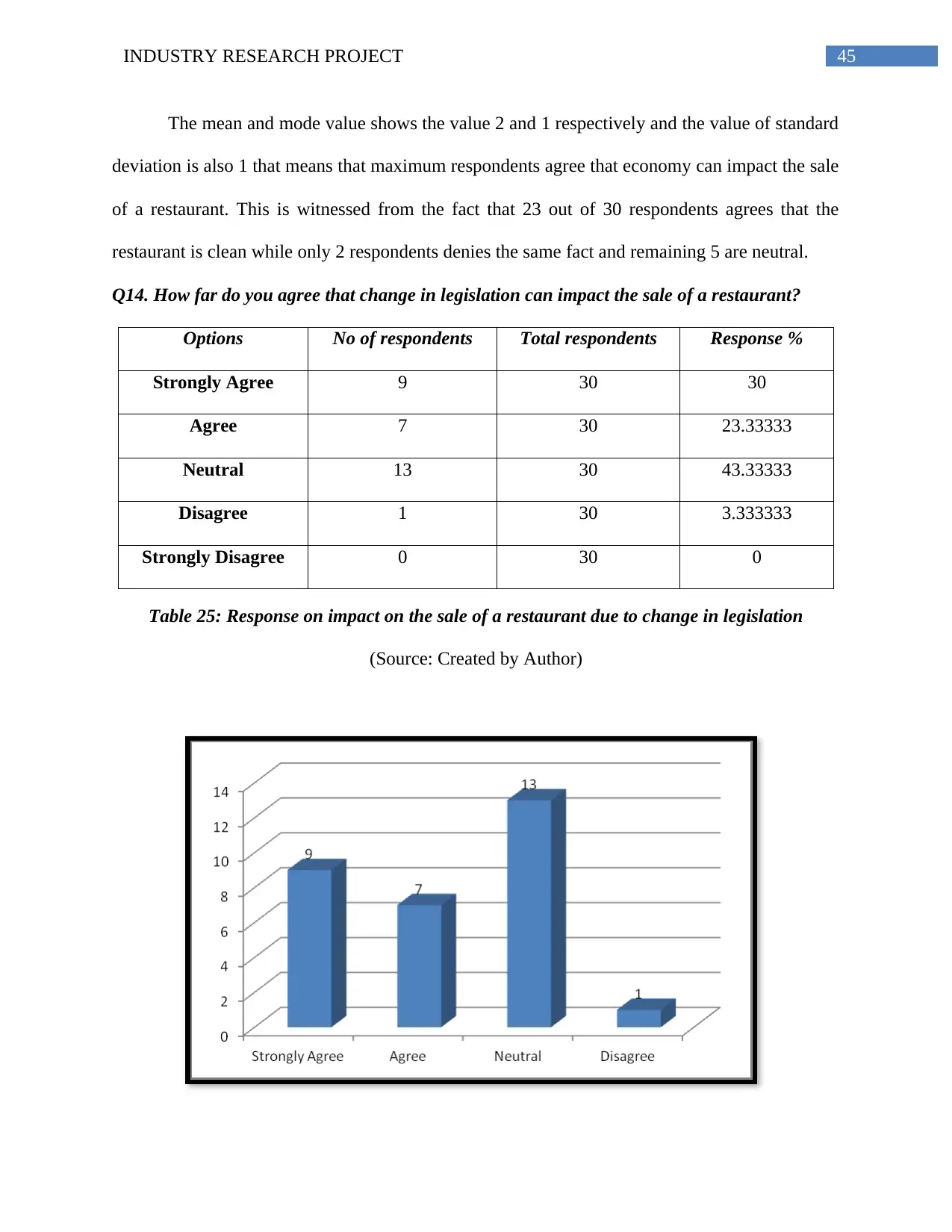
45INDUSTRY RESEARCH PROJECT
The mean and mode value shows the value 2 and 1 respectively and the value of standard
deviation is also 1 that means that maximum respondents agree that economy can impact the sale
of a restaurant. This is witnessed from the fact that 23 out of 30 respondents agrees that the
restaurant is clean while only 2 respondents denies the same fact and remaining 5 are neutral.
Q14. How far do you agree that change in legislation can impact the sale of a restaurant?
Options No of respondents Total respondents Response %
Strongly Agree 9 30 30
Agree 7 30 23.33333
Neutral 13 30 43.33333
Disagree 1 30 3.333333
Strongly Disagree 0 30 0
Table 25: Response on impact on the sale of a restaurant due to change in legislation
(Source: Created by Author)
The mean and mode value shows the value 2 and 1 respectively and the value of standard
deviation is also 1 that means that maximum respondents agree that economy can impact the sale
of a restaurant. This is witnessed from the fact that 23 out of 30 respondents agrees that the
restaurant is clean while only 2 respondents denies the same fact and remaining 5 are neutral.
Q14. How far do you agree that change in legislation can impact the sale of a restaurant?
Options No of respondents Total respondents Response %
Strongly Agree 9 30 30
Agree 7 30 23.33333
Neutral 13 30 43.33333
Disagree 1 30 3.333333
Strongly Disagree 0 30 0
Table 25: Response on impact on the sale of a restaurant due to change in legislation
(Source: Created by Author)
Secure Best Marks with AI Grader
Need help grading? Try our AI Grader for instant feedback on your assignments.
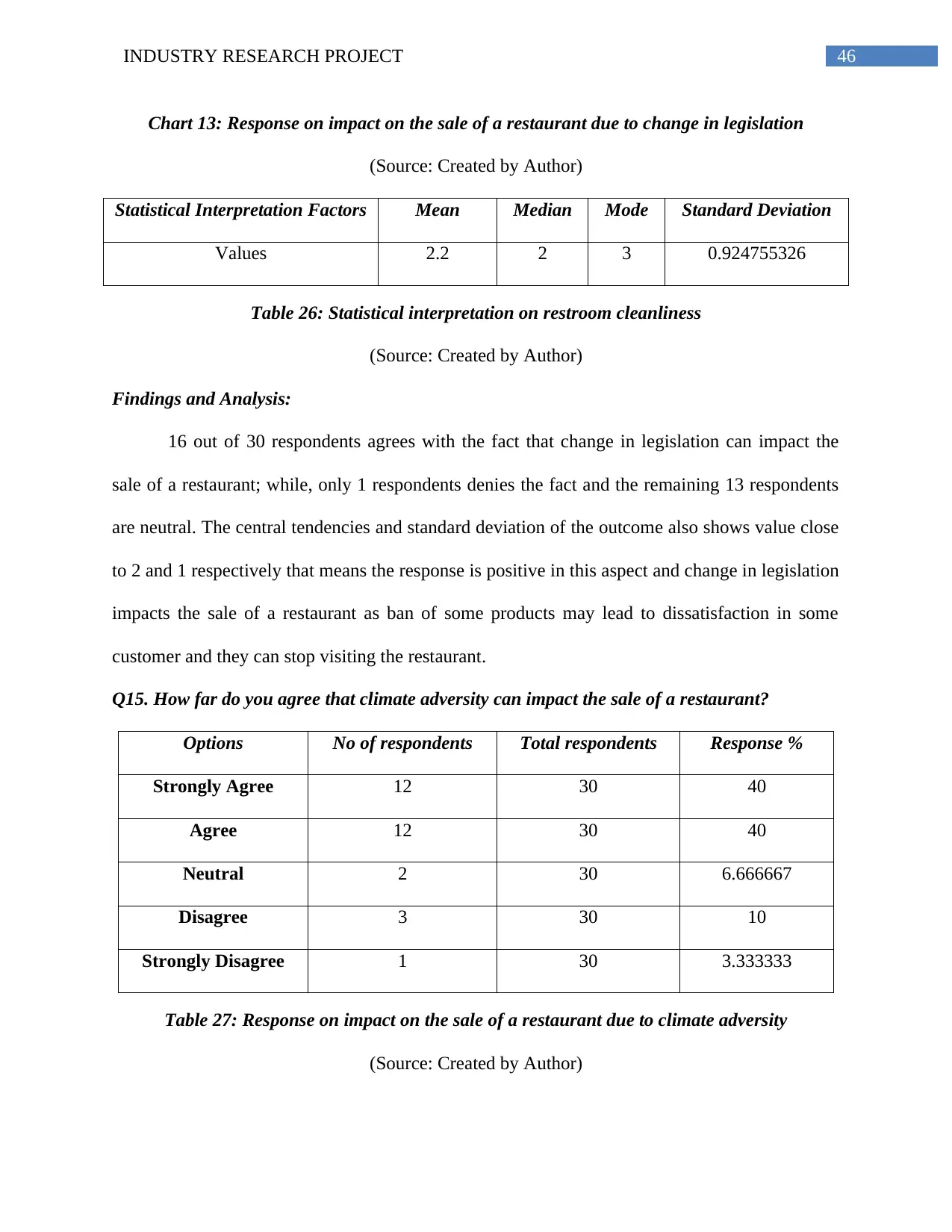
46INDUSTRY RESEARCH PROJECT
Chart 13: Response on impact on the sale of a restaurant due to change in legislation
(Source: Created by Author)
Statistical Interpretation Factors Mean Median Mode Standard Deviation
Values 2.2 2 3 0.924755326
Table 26: Statistical interpretation on restroom cleanliness
(Source: Created by Author)
Findings and Analysis:
16 out of 30 respondents agrees with the fact that change in legislation can impact the
sale of a restaurant; while, only 1 respondents denies the fact and the remaining 13 respondents
are neutral. The central tendencies and standard deviation of the outcome also shows value close
to 2 and 1 respectively that means the response is positive in this aspect and change in legislation
impacts the sale of a restaurant as ban of some products may lead to dissatisfaction in some
customer and they can stop visiting the restaurant.
Q15. How far do you agree that climate adversity can impact the sale of a restaurant?
Options No of respondents Total respondents Response %
Strongly Agree 12 30 40
Agree 12 30 40
Neutral 2 30 6.666667
Disagree 3 30 10
Strongly Disagree 1 30 3.333333
Table 27: Response on impact on the sale of a restaurant due to climate adversity
(Source: Created by Author)
Chart 13: Response on impact on the sale of a restaurant due to change in legislation
(Source: Created by Author)
Statistical Interpretation Factors Mean Median Mode Standard Deviation
Values 2.2 2 3 0.924755326
Table 26: Statistical interpretation on restroom cleanliness
(Source: Created by Author)
Findings and Analysis:
16 out of 30 respondents agrees with the fact that change in legislation can impact the
sale of a restaurant; while, only 1 respondents denies the fact and the remaining 13 respondents
are neutral. The central tendencies and standard deviation of the outcome also shows value close
to 2 and 1 respectively that means the response is positive in this aspect and change in legislation
impacts the sale of a restaurant as ban of some products may lead to dissatisfaction in some
customer and they can stop visiting the restaurant.
Q15. How far do you agree that climate adversity can impact the sale of a restaurant?
Options No of respondents Total respondents Response %
Strongly Agree 12 30 40
Agree 12 30 40
Neutral 2 30 6.666667
Disagree 3 30 10
Strongly Disagree 1 30 3.333333
Table 27: Response on impact on the sale of a restaurant due to climate adversity
(Source: Created by Author)
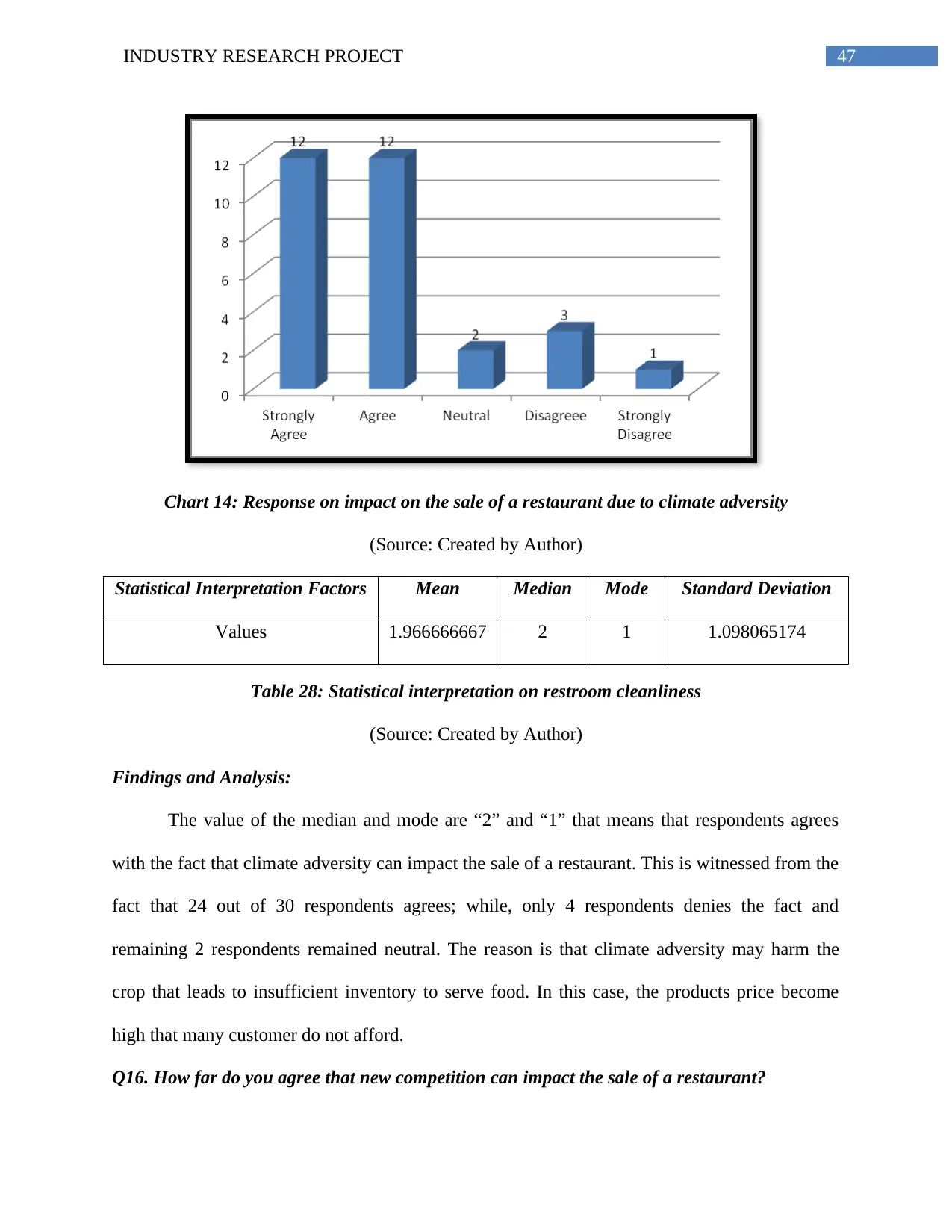
47INDUSTRY RESEARCH PROJECT
Chart 14: Response on impact on the sale of a restaurant due to climate adversity
(Source: Created by Author)
Statistical Interpretation Factors Mean Median Mode Standard Deviation
Values 1.966666667 2 1 1.098065174
Table 28: Statistical interpretation on restroom cleanliness
(Source: Created by Author)
Findings and Analysis:
The value of the median and mode are “2” and “1” that means that respondents agrees
with the fact that climate adversity can impact the sale of a restaurant. This is witnessed from the
fact that 24 out of 30 respondents agrees; while, only 4 respondents denies the fact and
remaining 2 respondents remained neutral. The reason is that climate adversity may harm the
crop that leads to insufficient inventory to serve food. In this case, the products price become
high that many customer do not afford.
Q16. How far do you agree that new competition can impact the sale of a restaurant?
Chart 14: Response on impact on the sale of a restaurant due to climate adversity
(Source: Created by Author)
Statistical Interpretation Factors Mean Median Mode Standard Deviation
Values 1.966666667 2 1 1.098065174
Table 28: Statistical interpretation on restroom cleanliness
(Source: Created by Author)
Findings and Analysis:
The value of the median and mode are “2” and “1” that means that respondents agrees
with the fact that climate adversity can impact the sale of a restaurant. This is witnessed from the
fact that 24 out of 30 respondents agrees; while, only 4 respondents denies the fact and
remaining 2 respondents remained neutral. The reason is that climate adversity may harm the
crop that leads to insufficient inventory to serve food. In this case, the products price become
high that many customer do not afford.
Q16. How far do you agree that new competition can impact the sale of a restaurant?
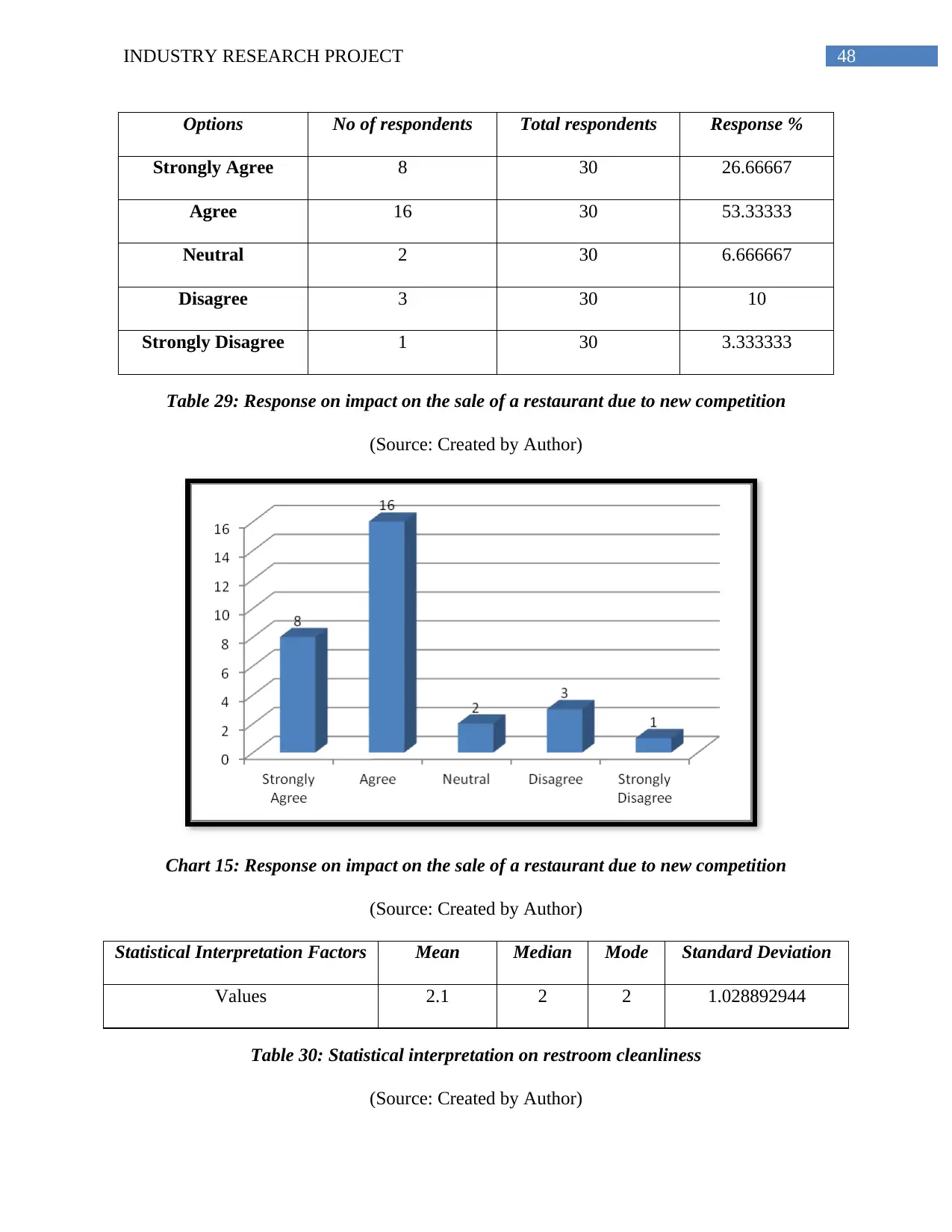
48INDUSTRY RESEARCH PROJECT
Options No of respondents Total respondents Response %
Strongly Agree 8 30 26.66667
Agree 16 30 53.33333
Neutral 2 30 6.666667
Disagree 3 30 10
Strongly Disagree 1 30 3.333333
Table 29: Response on impact on the sale of a restaurant due to new competition
(Source: Created by Author)
Chart 15: Response on impact on the sale of a restaurant due to new competition
(Source: Created by Author)
Statistical Interpretation Factors Mean Median Mode Standard Deviation
Values 2.1 2 2 1.028892944
Table 30: Statistical interpretation on restroom cleanliness
(Source: Created by Author)
Options No of respondents Total respondents Response %
Strongly Agree 8 30 26.66667
Agree 16 30 53.33333
Neutral 2 30 6.666667
Disagree 3 30 10
Strongly Disagree 1 30 3.333333
Table 29: Response on impact on the sale of a restaurant due to new competition
(Source: Created by Author)
Chart 15: Response on impact on the sale of a restaurant due to new competition
(Source: Created by Author)
Statistical Interpretation Factors Mean Median Mode Standard Deviation
Values 2.1 2 2 1.028892944
Table 30: Statistical interpretation on restroom cleanliness
(Source: Created by Author)
Paraphrase This Document
Need a fresh take? Get an instant paraphrase of this document with our AI Paraphraser
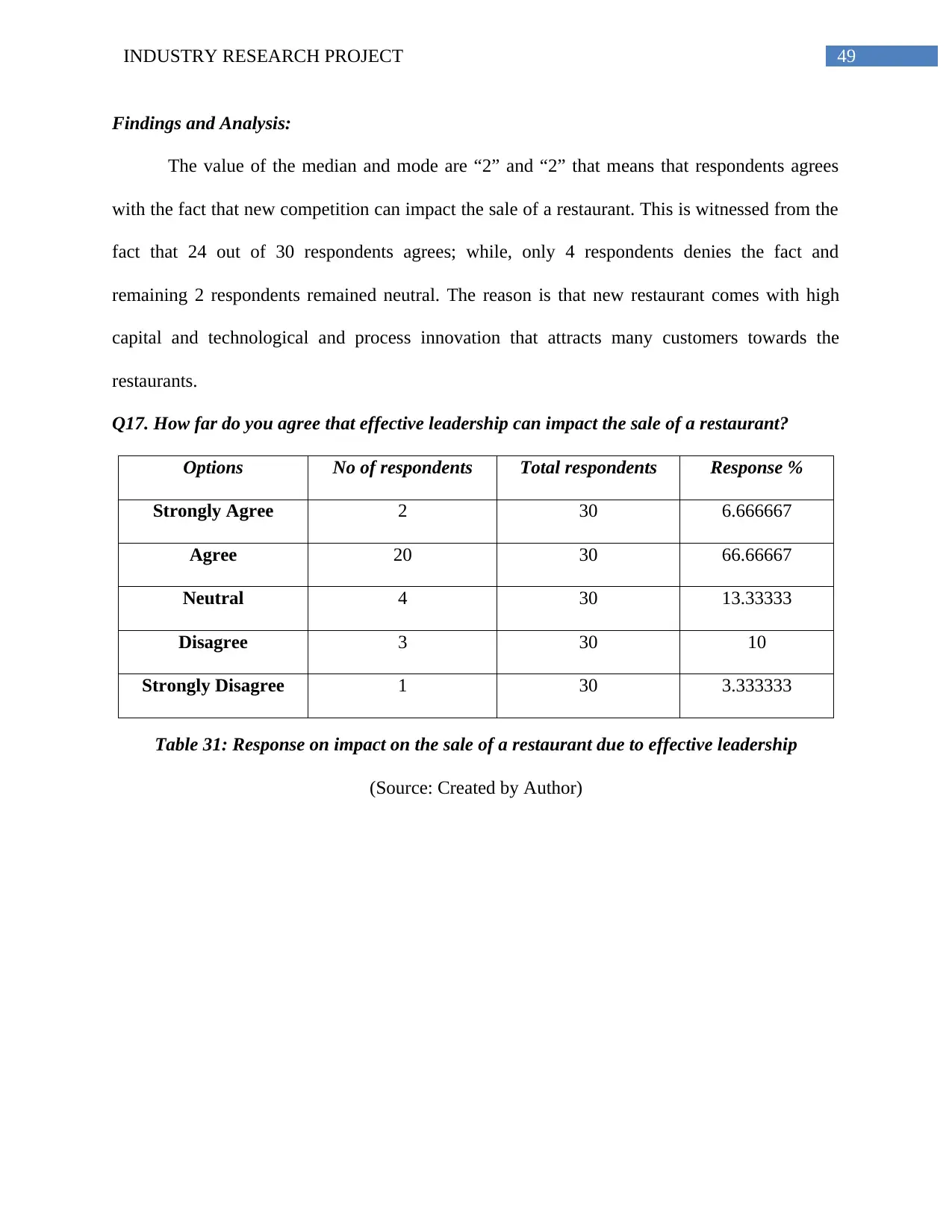
49INDUSTRY RESEARCH PROJECT
Findings and Analysis:
The value of the median and mode are “2” and “2” that means that respondents agrees
with the fact that new competition can impact the sale of a restaurant. This is witnessed from the
fact that 24 out of 30 respondents agrees; while, only 4 respondents denies the fact and
remaining 2 respondents remained neutral. The reason is that new restaurant comes with high
capital and technological and process innovation that attracts many customers towards the
restaurants.
Q17. How far do you agree that effective leadership can impact the sale of a restaurant?
Options No of respondents Total respondents Response %
Strongly Agree 2 30 6.666667
Agree 20 30 66.66667
Neutral 4 30 13.33333
Disagree 3 30 10
Strongly Disagree 1 30 3.333333
Table 31: Response on impact on the sale of a restaurant due to effective leadership
(Source: Created by Author)
Findings and Analysis:
The value of the median and mode are “2” and “2” that means that respondents agrees
with the fact that new competition can impact the sale of a restaurant. This is witnessed from the
fact that 24 out of 30 respondents agrees; while, only 4 respondents denies the fact and
remaining 2 respondents remained neutral. The reason is that new restaurant comes with high
capital and technological and process innovation that attracts many customers towards the
restaurants.
Q17. How far do you agree that effective leadership can impact the sale of a restaurant?
Options No of respondents Total respondents Response %
Strongly Agree 2 30 6.666667
Agree 20 30 66.66667
Neutral 4 30 13.33333
Disagree 3 30 10
Strongly Disagree 1 30 3.333333
Table 31: Response on impact on the sale of a restaurant due to effective leadership
(Source: Created by Author)
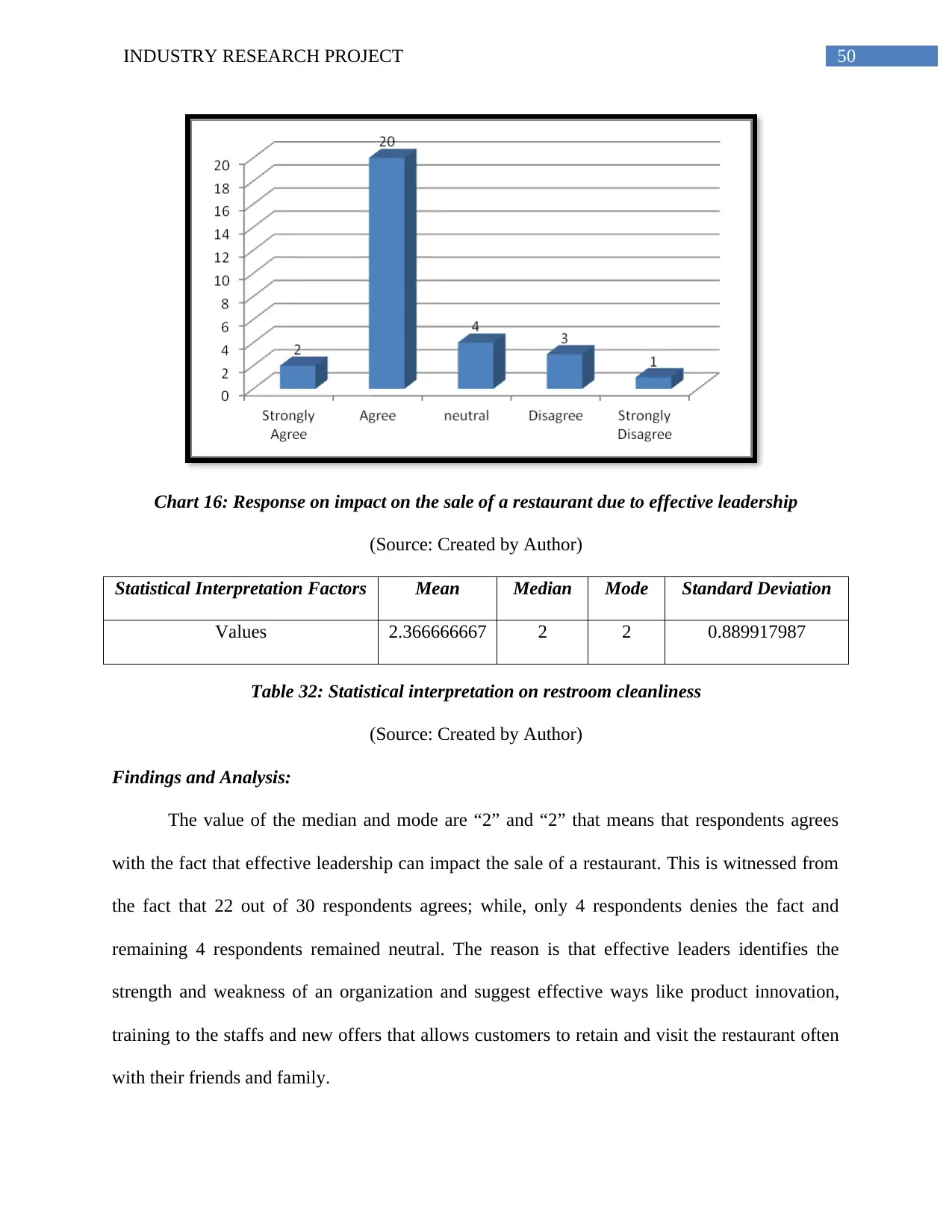
50INDUSTRY RESEARCH PROJECT
Chart 16: Response on impact on the sale of a restaurant due to effective leadership
(Source: Created by Author)
Statistical Interpretation Factors Mean Median Mode Standard Deviation
Values 2.366666667 2 2 0.889917987
Table 32: Statistical interpretation on restroom cleanliness
(Source: Created by Author)
Findings and Analysis:
The value of the median and mode are “2” and “2” that means that respondents agrees
with the fact that effective leadership can impact the sale of a restaurant. This is witnessed from
the fact that 22 out of 30 respondents agrees; while, only 4 respondents denies the fact and
remaining 4 respondents remained neutral. The reason is that effective leaders identifies the
strength and weakness of an organization and suggest effective ways like product innovation,
training to the staffs and new offers that allows customers to retain and visit the restaurant often
with their friends and family.
Chart 16: Response on impact on the sale of a restaurant due to effective leadership
(Source: Created by Author)
Statistical Interpretation Factors Mean Median Mode Standard Deviation
Values 2.366666667 2 2 0.889917987
Table 32: Statistical interpretation on restroom cleanliness
(Source: Created by Author)
Findings and Analysis:
The value of the median and mode are “2” and “2” that means that respondents agrees
with the fact that effective leadership can impact the sale of a restaurant. This is witnessed from
the fact that 22 out of 30 respondents agrees; while, only 4 respondents denies the fact and
remaining 4 respondents remained neutral. The reason is that effective leaders identifies the
strength and weakness of an organization and suggest effective ways like product innovation,
training to the staffs and new offers that allows customers to retain and visit the restaurant often
with their friends and family.
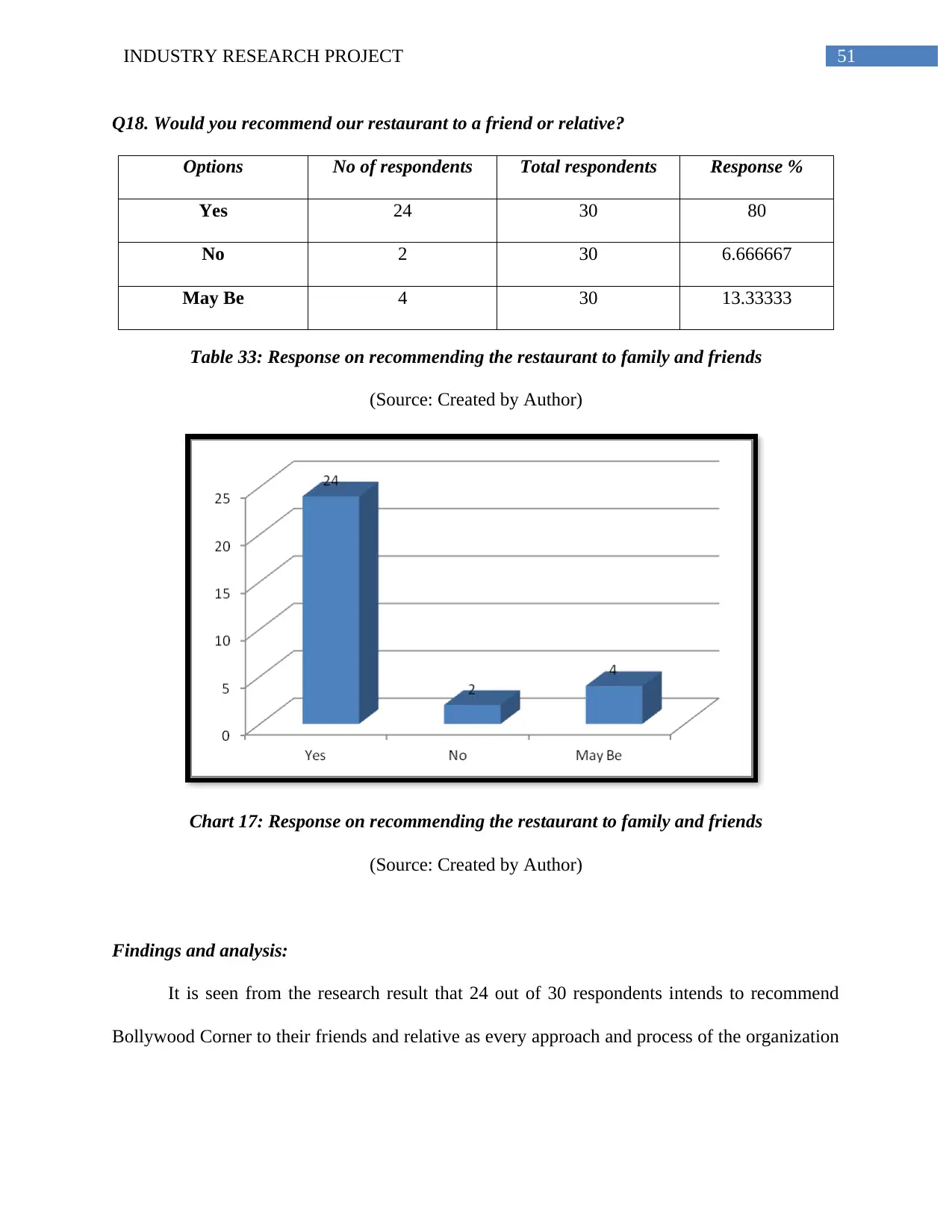
51INDUSTRY RESEARCH PROJECT
Q18. Would you recommend our restaurant to a friend or relative?
Options No of respondents Total respondents Response %
Yes 24 30 80
No 2 30 6.666667
May Be 4 30 13.33333
Table 33: Response on recommending the restaurant to family and friends
(Source: Created by Author)
Chart 17: Response on recommending the restaurant to family and friends
(Source: Created by Author)
Findings and analysis:
It is seen from the research result that 24 out of 30 respondents intends to recommend
Bollywood Corner to their friends and relative as every approach and process of the organization
Q18. Would you recommend our restaurant to a friend or relative?
Options No of respondents Total respondents Response %
Yes 24 30 80
No 2 30 6.666667
May Be 4 30 13.33333
Table 33: Response on recommending the restaurant to family and friends
(Source: Created by Author)
Chart 17: Response on recommending the restaurant to family and friends
(Source: Created by Author)
Findings and analysis:
It is seen from the research result that 24 out of 30 respondents intends to recommend
Bollywood Corner to their friends and relative as every approach and process of the organization
Secure Best Marks with AI Grader
Need help grading? Try our AI Grader for instant feedback on your assignments.
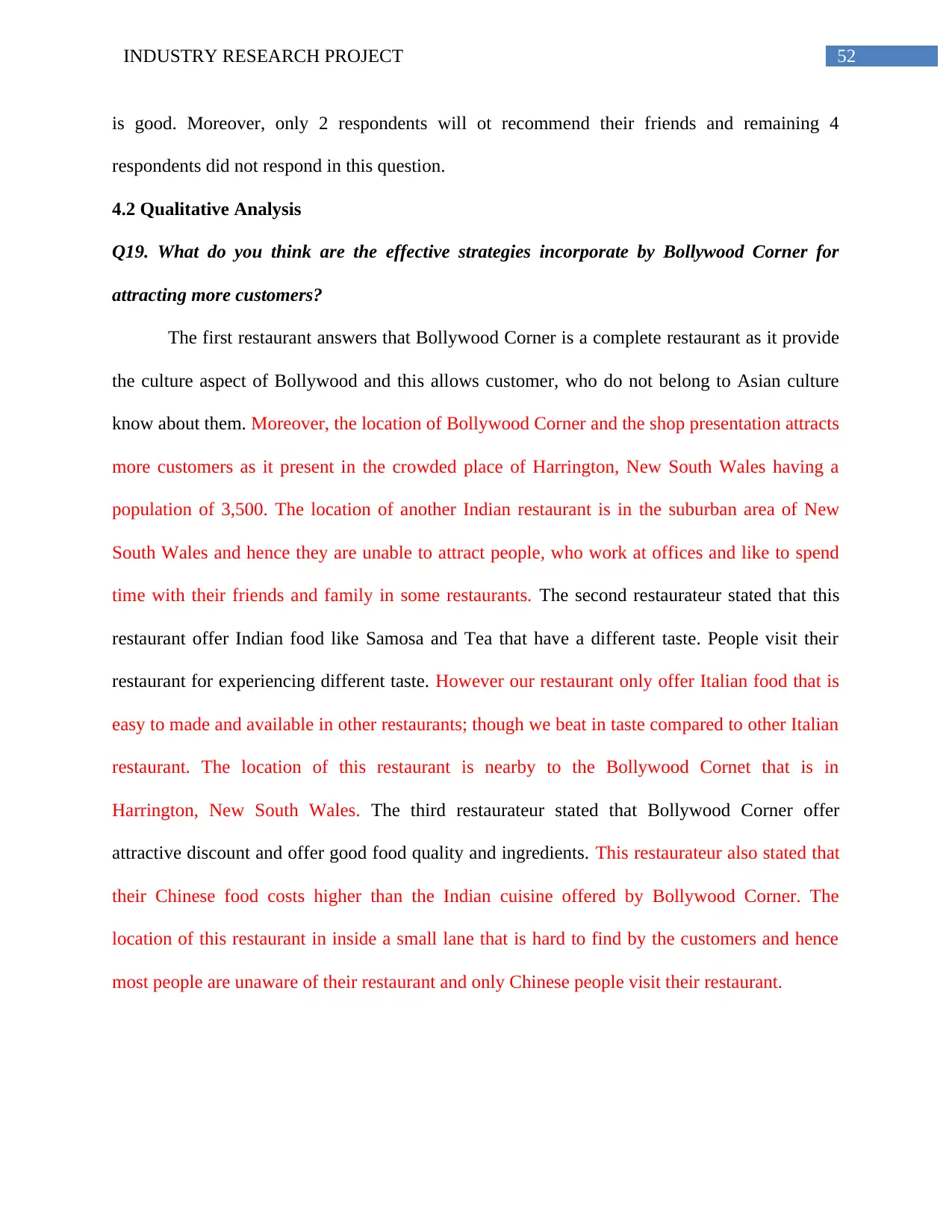
52INDUSTRY RESEARCH PROJECT
is good. Moreover, only 2 respondents will ot recommend their friends and remaining 4
respondents did not respond in this question.
4.2 Qualitative Analysis
Q19. What do you think are the effective strategies incorporate by Bollywood Corner for
attracting more customers?
The first restaurant answers that Bollywood Corner is a complete restaurant as it provide
the culture aspect of Bollywood and this allows customer, who do not belong to Asian culture
know about them. Moreover, the location of Bollywood Corner and the shop presentation attracts
more customers as it present in the crowded place of Harrington, New South Wales having a
population of 3,500. The location of another Indian restaurant is in the suburban area of New
South Wales and hence they are unable to attract people, who work at offices and like to spend
time with their friends and family in some restaurants. The second restaurateur stated that this
restaurant offer Indian food like Samosa and Tea that have a different taste. People visit their
restaurant for experiencing different taste. However our restaurant only offer Italian food that is
easy to made and available in other restaurants; though we beat in taste compared to other Italian
restaurant. The location of this restaurant is nearby to the Bollywood Cornet that is in
Harrington, New South Wales. The third restaurateur stated that Bollywood Corner offer
attractive discount and offer good food quality and ingredients. This restaurateur also stated that
their Chinese food costs higher than the Indian cuisine offered by Bollywood Corner. The
location of this restaurant in inside a small lane that is hard to find by the customers and hence
most people are unaware of their restaurant and only Chinese people visit their restaurant.
is good. Moreover, only 2 respondents will ot recommend their friends and remaining 4
respondents did not respond in this question.
4.2 Qualitative Analysis
Q19. What do you think are the effective strategies incorporate by Bollywood Corner for
attracting more customers?
The first restaurant answers that Bollywood Corner is a complete restaurant as it provide
the culture aspect of Bollywood and this allows customer, who do not belong to Asian culture
know about them. Moreover, the location of Bollywood Corner and the shop presentation attracts
more customers as it present in the crowded place of Harrington, New South Wales having a
population of 3,500. The location of another Indian restaurant is in the suburban area of New
South Wales and hence they are unable to attract people, who work at offices and like to spend
time with their friends and family in some restaurants. The second restaurateur stated that this
restaurant offer Indian food like Samosa and Tea that have a different taste. People visit their
restaurant for experiencing different taste. However our restaurant only offer Italian food that is
easy to made and available in other restaurants; though we beat in taste compared to other Italian
restaurant. The location of this restaurant is nearby to the Bollywood Cornet that is in
Harrington, New South Wales. The third restaurateur stated that Bollywood Corner offer
attractive discount and offer good food quality and ingredients. This restaurateur also stated that
their Chinese food costs higher than the Indian cuisine offered by Bollywood Corner. The
location of this restaurant in inside a small lane that is hard to find by the customers and hence
most people are unaware of their restaurant and only Chinese people visit their restaurant.
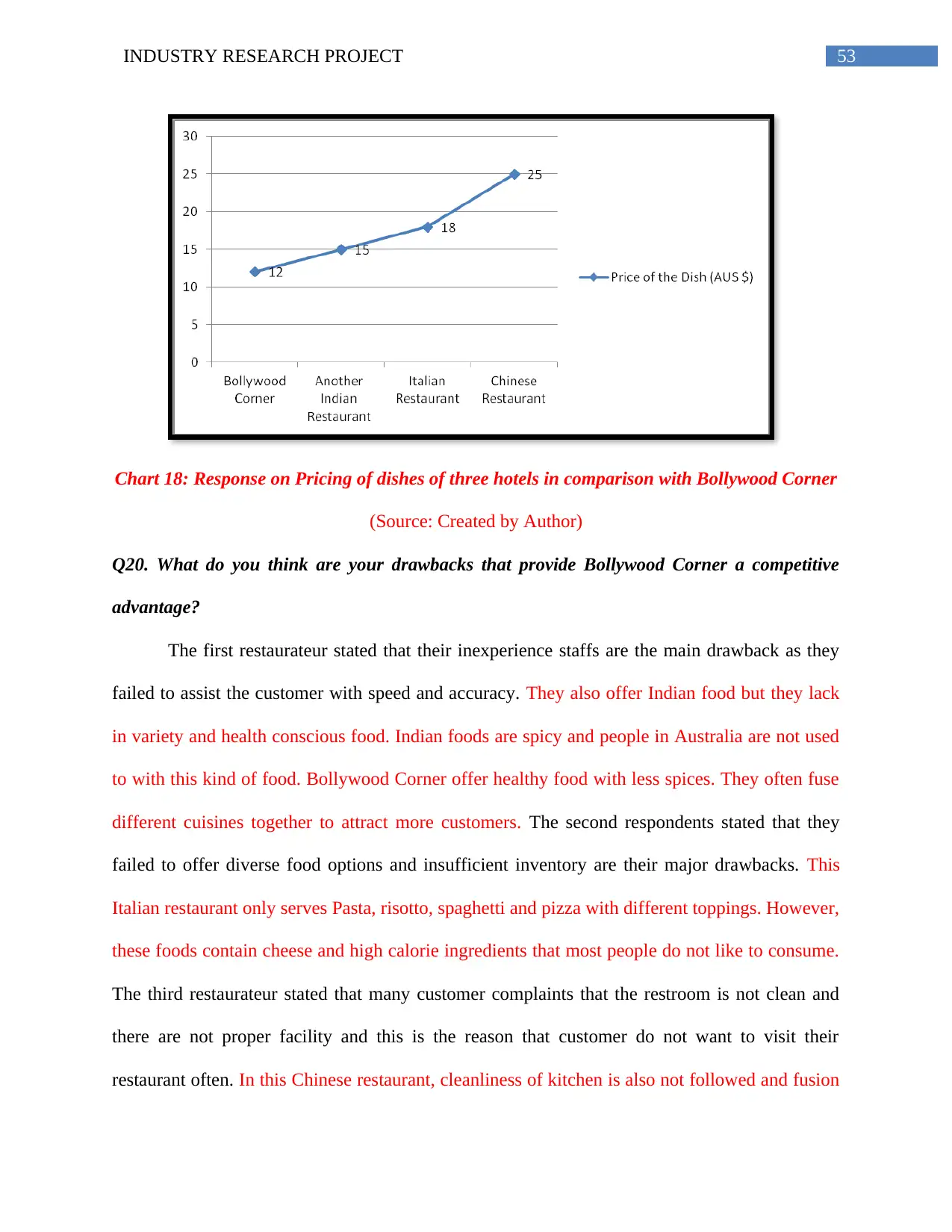
53INDUSTRY RESEARCH PROJECT
Chart 18: Response on Pricing of dishes of three hotels in comparison with Bollywood Corner
(Source: Created by Author)
Q20. What do you think are your drawbacks that provide Bollywood Corner a competitive
advantage?
The first restaurateur stated that their inexperience staffs are the main drawback as they
failed to assist the customer with speed and accuracy. They also offer Indian food but they lack
in variety and health conscious food. Indian foods are spicy and people in Australia are not used
to with this kind of food. Bollywood Corner offer healthy food with less spices. They often fuse
different cuisines together to attract more customers. The second respondents stated that they
failed to offer diverse food options and insufficient inventory are their major drawbacks. This
Italian restaurant only serves Pasta, risotto, spaghetti and pizza with different toppings. However,
these foods contain cheese and high calorie ingredients that most people do not like to consume.
The third restaurateur stated that many customer complaints that the restroom is not clean and
there are not proper facility and this is the reason that customer do not want to visit their
restaurant often. In this Chinese restaurant, cleanliness of kitchen is also not followed and fusion
Chart 18: Response on Pricing of dishes of three hotels in comparison with Bollywood Corner
(Source: Created by Author)
Q20. What do you think are your drawbacks that provide Bollywood Corner a competitive
advantage?
The first restaurateur stated that their inexperience staffs are the main drawback as they
failed to assist the customer with speed and accuracy. They also offer Indian food but they lack
in variety and health conscious food. Indian foods are spicy and people in Australia are not used
to with this kind of food. Bollywood Corner offer healthy food with less spices. They often fuse
different cuisines together to attract more customers. The second respondents stated that they
failed to offer diverse food options and insufficient inventory are their major drawbacks. This
Italian restaurant only serves Pasta, risotto, spaghetti and pizza with different toppings. However,
these foods contain cheese and high calorie ingredients that most people do not like to consume.
The third restaurateur stated that many customer complaints that the restroom is not clean and
there are not proper facility and this is the reason that customer do not want to visit their
restaurant often. In this Chinese restaurant, cleanliness of kitchen is also not followed and fusion
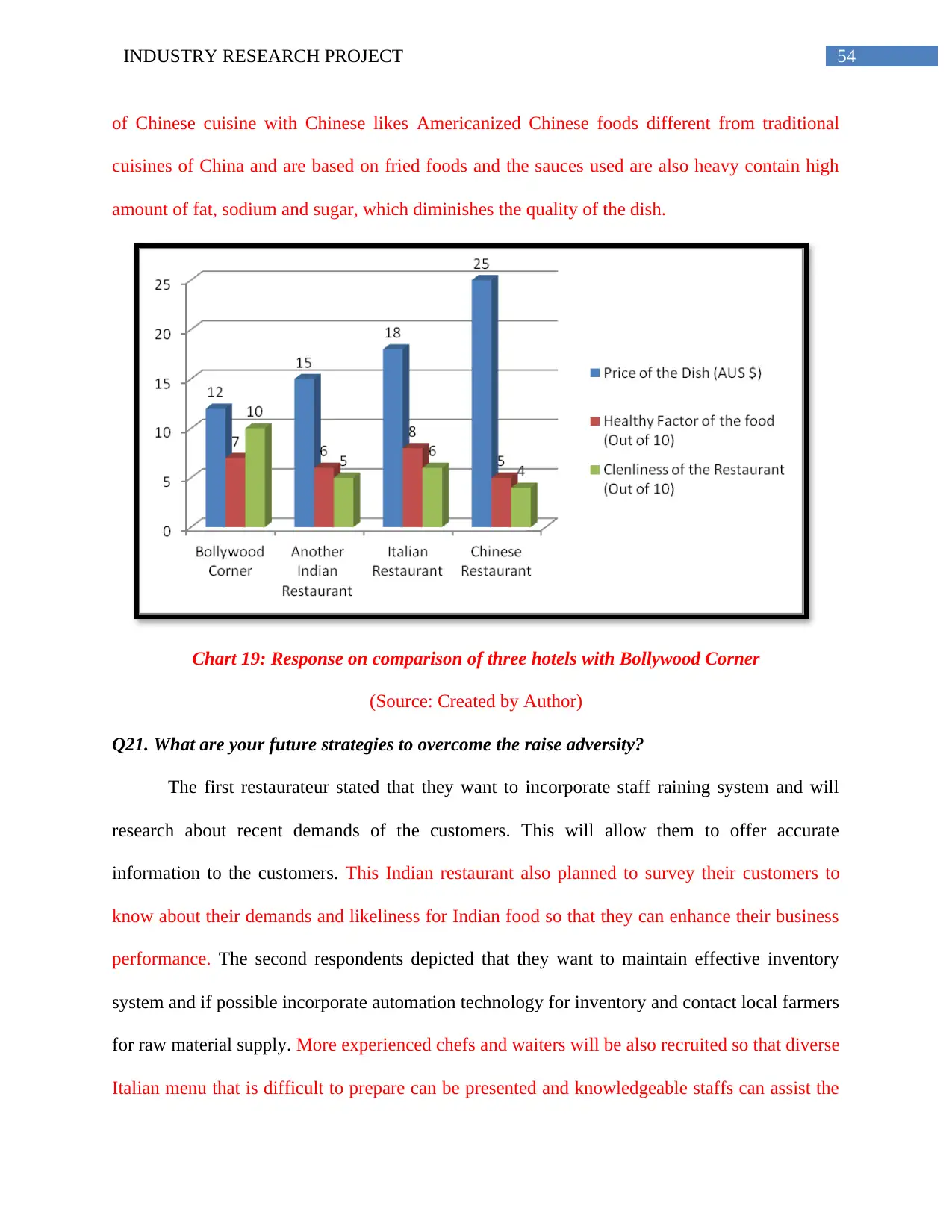
54INDUSTRY RESEARCH PROJECT
of Chinese cuisine with Chinese likes Americanized Chinese foods different from traditional
cuisines of China and are based on fried foods and the sauces used are also heavy contain high
amount of fat, sodium and sugar, which diminishes the quality of the dish.
Chart 19: Response on comparison of three hotels with Bollywood Corner
(Source: Created by Author)
Q21. What are your future strategies to overcome the raise adversity?
The first restaurateur stated that they want to incorporate staff raining system and will
research about recent demands of the customers. This will allow them to offer accurate
information to the customers. This Indian restaurant also planned to survey their customers to
know about their demands and likeliness for Indian food so that they can enhance their business
performance. The second respondents depicted that they want to maintain effective inventory
system and if possible incorporate automation technology for inventory and contact local farmers
for raw material supply. More experienced chefs and waiters will be also recruited so that diverse
Italian menu that is difficult to prepare can be presented and knowledgeable staffs can assist the
of Chinese cuisine with Chinese likes Americanized Chinese foods different from traditional
cuisines of China and are based on fried foods and the sauces used are also heavy contain high
amount of fat, sodium and sugar, which diminishes the quality of the dish.
Chart 19: Response on comparison of three hotels with Bollywood Corner
(Source: Created by Author)
Q21. What are your future strategies to overcome the raise adversity?
The first restaurateur stated that they want to incorporate staff raining system and will
research about recent demands of the customers. This will allow them to offer accurate
information to the customers. This Indian restaurant also planned to survey their customers to
know about their demands and likeliness for Indian food so that they can enhance their business
performance. The second respondents depicted that they want to maintain effective inventory
system and if possible incorporate automation technology for inventory and contact local farmers
for raw material supply. More experienced chefs and waiters will be also recruited so that diverse
Italian menu that is difficult to prepare can be presented and knowledgeable staffs can assist the
Paraphrase This Document
Need a fresh take? Get an instant paraphrase of this document with our AI Paraphraser

55INDUSTRY RESEARCH PROJECT
customers efficiently. The third restaurateur said that they desire to renovate their interiors and
plan the restaurant more effectively so that people can get proper restroom facilities and
comfortable ambience inside the restaurants. This will allow them to maintain their inventory.
This Chinese restaurant is planning to offer only Chinese cuisines that are low in fat and healthy
to consume. Moreover, calorie-rich dishes like Kung Pao beef and General Tso's chicken will be
served with healthy salads and low fat side dishes in order to offer a balanced diet.
customers efficiently. The third restaurateur said that they desire to renovate their interiors and
plan the restaurant more effectively so that people can get proper restroom facilities and
comfortable ambience inside the restaurants. This will allow them to maintain their inventory.
This Chinese restaurant is planning to offer only Chinese cuisines that are low in fat and healthy
to consume. Moreover, calorie-rich dishes like Kung Pao beef and General Tso's chicken will be
served with healthy salads and low fat side dishes in order to offer a balanced diet.

56INDUSTRY RESEARCH PROJECT
Chapter-5: Conclusion
5.1 Conclusion
The research aims for the finding the problem that a restaurant may face, which in the
other hand diminishes their annual sale as their sale become low. In addition to that, it is found
that from the literature review that there are several factors like micro and macro factors that are
responsible for the failure of a restaurant. However, ineffective incorporation of the marketing
theories and improper research about the customer demand and market also lead to the failure of
the restaurant. This marketing concept is inefficient identification of the strength of the
organization, overlooking the weakness and threat for the organization and neglecting the
opportunity. All these factors allow other competitors to prosper and attain competitive
advantage. However, the organization that is taken into consideration is the Bollywood Corner
and it is an Indian restaurant in Australia.
The research also shows that this restaurant offer good food quality and use good
ingredients that people often visit their restaurants with their friends and family. Moreover, this
restaurant also provides discounts and has clean restroom. This restaurant also shows many
Bollywood movies and makes the local people aware of the Bollywood talents. This makes non-
Asian people also aware of the Asian culture. The respondents also agrees that economic
conditions f the customers, change in legislation like bans on alcohols and climate adversity
impacts that sale of a restaurant and may cause failure for the organization. This research also
shows that leaders also play a crucial role in development of the restaurant as they are liable to
suggest new ideas that can provide competitive advantage to an organization. They are also
liable to identify the weakness in the staffs and provide them effective training through effective
methods.
Chapter-5: Conclusion
5.1 Conclusion
The research aims for the finding the problem that a restaurant may face, which in the
other hand diminishes their annual sale as their sale become low. In addition to that, it is found
that from the literature review that there are several factors like micro and macro factors that are
responsible for the failure of a restaurant. However, ineffective incorporation of the marketing
theories and improper research about the customer demand and market also lead to the failure of
the restaurant. This marketing concept is inefficient identification of the strength of the
organization, overlooking the weakness and threat for the organization and neglecting the
opportunity. All these factors allow other competitors to prosper and attain competitive
advantage. However, the organization that is taken into consideration is the Bollywood Corner
and it is an Indian restaurant in Australia.
The research also shows that this restaurant offer good food quality and use good
ingredients that people often visit their restaurants with their friends and family. Moreover, this
restaurant also provides discounts and has clean restroom. This restaurant also shows many
Bollywood movies and makes the local people aware of the Bollywood talents. This makes non-
Asian people also aware of the Asian culture. The respondents also agrees that economic
conditions f the customers, change in legislation like bans on alcohols and climate adversity
impacts that sale of a restaurant and may cause failure for the organization. This research also
shows that leaders also play a crucial role in development of the restaurant as they are liable to
suggest new ideas that can provide competitive advantage to an organization. They are also
liable to identify the weakness in the staffs and provide them effective training through effective
methods.

57INDUSTRY RESEARCH PROJECT
Reference List
Abs.gov.au., 2017. Australian Bureau of Statistics. [online] Available at: http://
http://www.abs.gov.au/ausstats/abs@.nsf/ViewContent?
readform&view=mediareleasesbyTopic&Action=Expand&Num=3.9.. [Accessed 25 Sep. 2017].
Akroush, M.N., Abu-ElSamen, A.A., Samawi, G.A. and Odetallah, A.L., 2013. Internal
marketing and service quality in restaurants. Marketing Intelligence & Planning, 31(4), pp.304-
336.
Alipour, M., Aghamohammadi, A., Ahmadi, R. and Hoseini, S.H., 2012. A new educational
marketing mix: The 6ps for private school marketing in Iran. Research journal of applied
sciences, engineering and technology, 4(21), pp.4314-4319.
Anitsal, I., Girard, T. and Anitsal, M.M., 2012. An Application of Services Marketing Mix
Framework: How do Retailers Communicate Information on Their Sales Receipts?,„. Business
Studies Journal, 4(2), pp.77-90.
Asseng, S., Ewert, F., Rosenzweig, C., Jones, J.W., Hatfield, J.L., Ruane, A.C., Boote, K.J.,
Thorburn, P.J., Rötter, R.P., Cammarano, D. and Brisson, N., 2013. Uncertainty in simulating
wheat yields under climate change. Nature Climate Change, 3(9), pp.827-832.
Been, J.V., Nurmatov, U.B., Cox, B., Nawrot, T.S., van Schayck, C.P. and Sheikh, A., 2014.
Effect of smoke-free legislation on perinatal and child health: a systematic review and meta-
analysis. The Lancet, 383(9928), pp.1549-1560.
Bernstein, J.S., 2014. Identifying Market Segments, Selecting Target Markets, and Positioning
the Offer. In Standing Room Only (pp. 125-143). Palgrave Macmillan US.
Bhatia, A., 2013. SWOT analysis of Indian tourism industry. International Journal of Application
or Innovation in Engineering & Management, 2(12), pp.44-49.
Reference List
Abs.gov.au., 2017. Australian Bureau of Statistics. [online] Available at: http://
http://www.abs.gov.au/ausstats/abs@.nsf/ViewContent?
readform&view=mediareleasesbyTopic&Action=Expand&Num=3.9.. [Accessed 25 Sep. 2017].
Akroush, M.N., Abu-ElSamen, A.A., Samawi, G.A. and Odetallah, A.L., 2013. Internal
marketing and service quality in restaurants. Marketing Intelligence & Planning, 31(4), pp.304-
336.
Alipour, M., Aghamohammadi, A., Ahmadi, R. and Hoseini, S.H., 2012. A new educational
marketing mix: The 6ps for private school marketing in Iran. Research journal of applied
sciences, engineering and technology, 4(21), pp.4314-4319.
Anitsal, I., Girard, T. and Anitsal, M.M., 2012. An Application of Services Marketing Mix
Framework: How do Retailers Communicate Information on Their Sales Receipts?,„. Business
Studies Journal, 4(2), pp.77-90.
Asseng, S., Ewert, F., Rosenzweig, C., Jones, J.W., Hatfield, J.L., Ruane, A.C., Boote, K.J.,
Thorburn, P.J., Rötter, R.P., Cammarano, D. and Brisson, N., 2013. Uncertainty in simulating
wheat yields under climate change. Nature Climate Change, 3(9), pp.827-832.
Been, J.V., Nurmatov, U.B., Cox, B., Nawrot, T.S., van Schayck, C.P. and Sheikh, A., 2014.
Effect of smoke-free legislation on perinatal and child health: a systematic review and meta-
analysis. The Lancet, 383(9928), pp.1549-1560.
Bernstein, J.S., 2014. Identifying Market Segments, Selecting Target Markets, and Positioning
the Offer. In Standing Room Only (pp. 125-143). Palgrave Macmillan US.
Bhatia, A., 2013. SWOT analysis of Indian tourism industry. International Journal of Application
or Innovation in Engineering & Management, 2(12), pp.44-49.
Secure Best Marks with AI Grader
Need help grading? Try our AI Grader for instant feedback on your assignments.
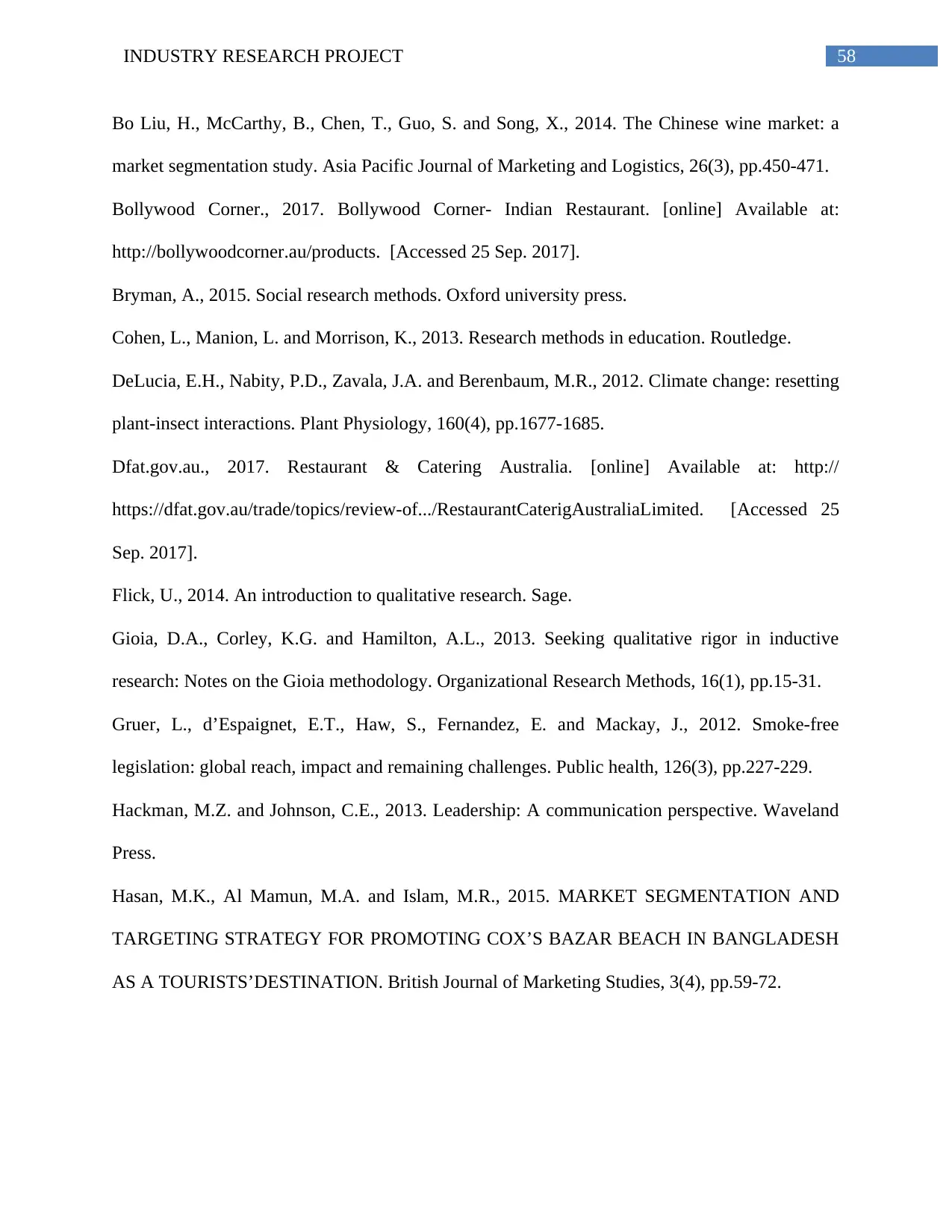
58INDUSTRY RESEARCH PROJECT
Bo Liu, H., McCarthy, B., Chen, T., Guo, S. and Song, X., 2014. The Chinese wine market: a
market segmentation study. Asia Pacific Journal of Marketing and Logistics, 26(3), pp.450-471.
Bollywood Corner., 2017. Bollywood Corner- Indian Restaurant. [online] Available at:
http://bollywoodcorner.au/products. [Accessed 25 Sep. 2017].
Bryman, A., 2015. Social research methods. Oxford university press.
Cohen, L., Manion, L. and Morrison, K., 2013. Research methods in education. Routledge.
DeLucia, E.H., Nabity, P.D., Zavala, J.A. and Berenbaum, M.R., 2012. Climate change: resetting
plant-insect interactions. Plant Physiology, 160(4), pp.1677-1685.
Dfat.gov.au., 2017. Restaurant & Catering Australia. [online] Available at: http://
https://dfat.gov.au/trade/topics/review-of.../RestaurantCaterigAustraliaLimited. [Accessed 25
Sep. 2017].
Flick, U., 2014. An introduction to qualitative research. Sage.
Gioia, D.A., Corley, K.G. and Hamilton, A.L., 2013. Seeking qualitative rigor in inductive
research: Notes on the Gioia methodology. Organizational Research Methods, 16(1), pp.15-31.
Gruer, L., d’Espaignet, E.T., Haw, S., Fernandez, E. and Mackay, J., 2012. Smoke-free
legislation: global reach, impact and remaining challenges. Public health, 126(3), pp.227-229.
Hackman, M.Z. and Johnson, C.E., 2013. Leadership: A communication perspective. Waveland
Press.
Hasan, M.K., Al Mamun, M.A. and Islam, M.R., 2015. MARKET SEGMENTATION AND
TARGETING STRATEGY FOR PROMOTING COX’S BAZAR BEACH IN BANGLADESH
AS A TOURISTS’DESTINATION. British Journal of Marketing Studies, 3(4), pp.59-72.
Bo Liu, H., McCarthy, B., Chen, T., Guo, S. and Song, X., 2014. The Chinese wine market: a
market segmentation study. Asia Pacific Journal of Marketing and Logistics, 26(3), pp.450-471.
Bollywood Corner., 2017. Bollywood Corner- Indian Restaurant. [online] Available at:
http://bollywoodcorner.au/products. [Accessed 25 Sep. 2017].
Bryman, A., 2015. Social research methods. Oxford university press.
Cohen, L., Manion, L. and Morrison, K., 2013. Research methods in education. Routledge.
DeLucia, E.H., Nabity, P.D., Zavala, J.A. and Berenbaum, M.R., 2012. Climate change: resetting
plant-insect interactions. Plant Physiology, 160(4), pp.1677-1685.
Dfat.gov.au., 2017. Restaurant & Catering Australia. [online] Available at: http://
https://dfat.gov.au/trade/topics/review-of.../RestaurantCaterigAustraliaLimited. [Accessed 25
Sep. 2017].
Flick, U., 2014. An introduction to qualitative research. Sage.
Gioia, D.A., Corley, K.G. and Hamilton, A.L., 2013. Seeking qualitative rigor in inductive
research: Notes on the Gioia methodology. Organizational Research Methods, 16(1), pp.15-31.
Gruer, L., d’Espaignet, E.T., Haw, S., Fernandez, E. and Mackay, J., 2012. Smoke-free
legislation: global reach, impact and remaining challenges. Public health, 126(3), pp.227-229.
Hackman, M.Z. and Johnson, C.E., 2013. Leadership: A communication perspective. Waveland
Press.
Hasan, M.K., Al Mamun, M.A. and Islam, M.R., 2015. MARKET SEGMENTATION AND
TARGETING STRATEGY FOR PROMOTING COX’S BAZAR BEACH IN BANGLADESH
AS A TOURISTS’DESTINATION. British Journal of Marketing Studies, 3(4), pp.59-72.
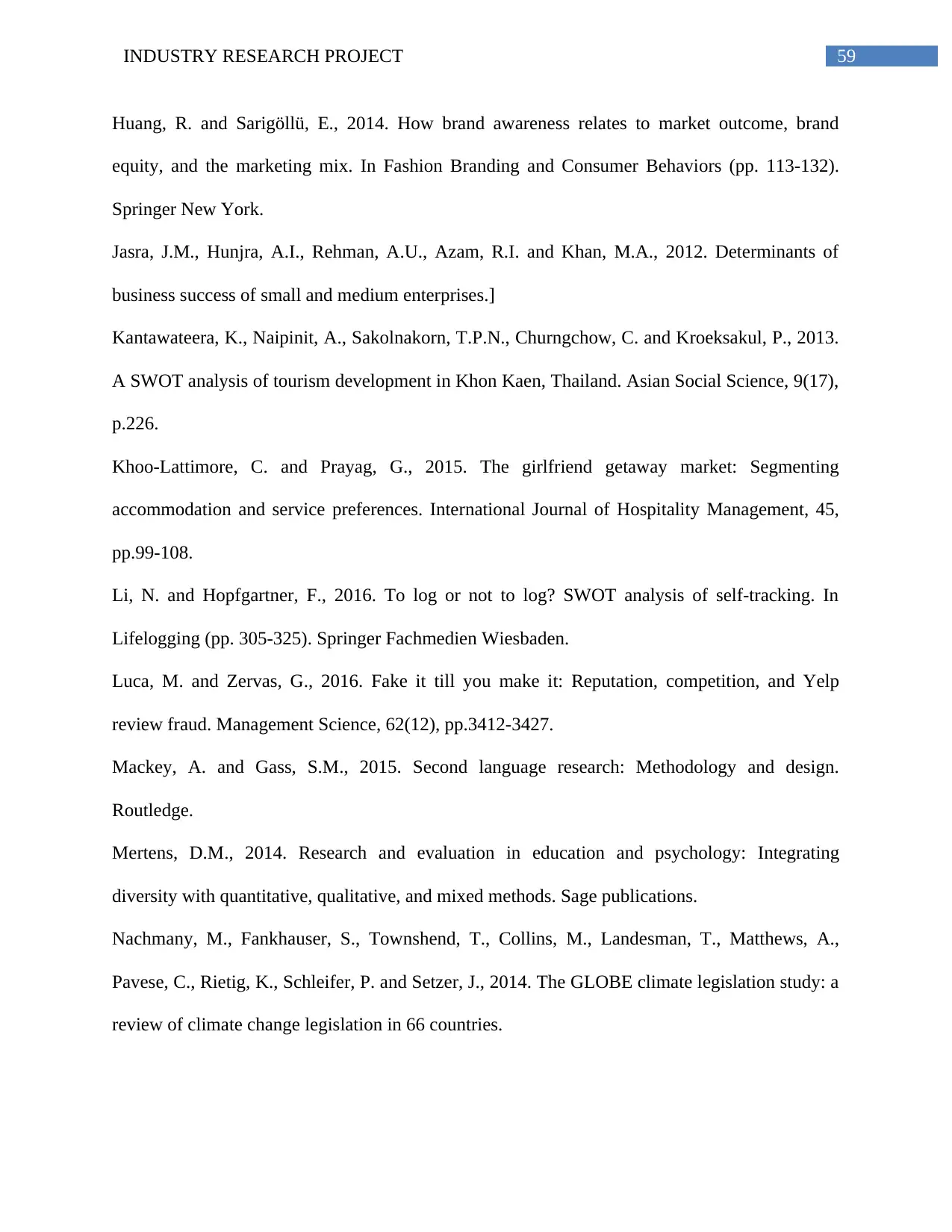
59INDUSTRY RESEARCH PROJECT
Huang, R. and Sarigöllü, E., 2014. How brand awareness relates to market outcome, brand
equity, and the marketing mix. In Fashion Branding and Consumer Behaviors (pp. 113-132).
Springer New York.
Jasra, J.M., Hunjra, A.I., Rehman, A.U., Azam, R.I. and Khan, M.A., 2012. Determinants of
business success of small and medium enterprises.]
Kantawateera, K., Naipinit, A., Sakolnakorn, T.P.N., Churngchow, C. and Kroeksakul, P., 2013.
A SWOT analysis of tourism development in Khon Kaen, Thailand. Asian Social Science, 9(17),
p.226.
Khoo-Lattimore, C. and Prayag, G., 2015. The girlfriend getaway market: Segmenting
accommodation and service preferences. International Journal of Hospitality Management, 45,
pp.99-108.
Li, N. and Hopfgartner, F., 2016. To log or not to log? SWOT analysis of self-tracking. In
Lifelogging (pp. 305-325). Springer Fachmedien Wiesbaden.
Luca, M. and Zervas, G., 2016. Fake it till you make it: Reputation, competition, and Yelp
review fraud. Management Science, 62(12), pp.3412-3427.
Mackey, A. and Gass, S.M., 2015. Second language research: Methodology and design.
Routledge.
Mertens, D.M., 2014. Research and evaluation in education and psychology: Integrating
diversity with quantitative, qualitative, and mixed methods. Sage publications.
Nachmany, M., Fankhauser, S., Townshend, T., Collins, M., Landesman, T., Matthews, A.,
Pavese, C., Rietig, K., Schleifer, P. and Setzer, J., 2014. The GLOBE climate legislation study: a
review of climate change legislation in 66 countries.
Huang, R. and Sarigöllü, E., 2014. How brand awareness relates to market outcome, brand
equity, and the marketing mix. In Fashion Branding and Consumer Behaviors (pp. 113-132).
Springer New York.
Jasra, J.M., Hunjra, A.I., Rehman, A.U., Azam, R.I. and Khan, M.A., 2012. Determinants of
business success of small and medium enterprises.]
Kantawateera, K., Naipinit, A., Sakolnakorn, T.P.N., Churngchow, C. and Kroeksakul, P., 2013.
A SWOT analysis of tourism development in Khon Kaen, Thailand. Asian Social Science, 9(17),
p.226.
Khoo-Lattimore, C. and Prayag, G., 2015. The girlfriend getaway market: Segmenting
accommodation and service preferences. International Journal of Hospitality Management, 45,
pp.99-108.
Li, N. and Hopfgartner, F., 2016. To log or not to log? SWOT analysis of self-tracking. In
Lifelogging (pp. 305-325). Springer Fachmedien Wiesbaden.
Luca, M. and Zervas, G., 2016. Fake it till you make it: Reputation, competition, and Yelp
review fraud. Management Science, 62(12), pp.3412-3427.
Mackey, A. and Gass, S.M., 2015. Second language research: Methodology and design.
Routledge.
Mertens, D.M., 2014. Research and evaluation in education and psychology: Integrating
diversity with quantitative, qualitative, and mixed methods. Sage publications.
Nachmany, M., Fankhauser, S., Townshend, T., Collins, M., Landesman, T., Matthews, A.,
Pavese, C., Rietig, K., Schleifer, P. and Setzer, J., 2014. The GLOBE climate legislation study: a
review of climate change legislation in 66 countries.
1 out of 60
Your All-in-One AI-Powered Toolkit for Academic Success.
+13062052269
info@desklib.com
Available 24*7 on WhatsApp / Email
![[object Object]](/_next/static/media/star-bottom.7253800d.svg)
Unlock your academic potential
© 2024 | Zucol Services PVT LTD | All rights reserved.




